-
Posts
2,292 -
Joined
-
Last visited
Content Type
Profiles
Forums
Gallery
Events
Posts posted by dafi
-
-
Sometimes, yes sometimes I wonder why-why-why ...... but after looking at my first lashing trials done with supermarket yarn for the tampions and the apron, 0,3 Krick line for the lashing and a breech rope laid out of the same material ...
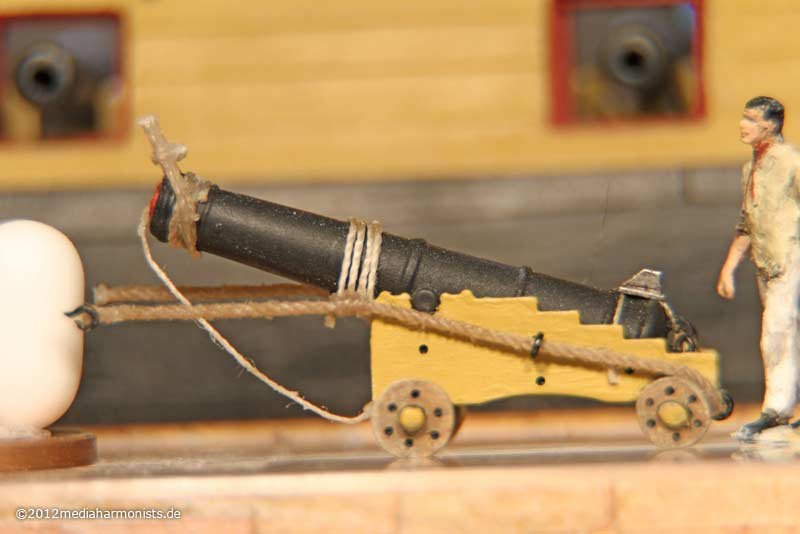 ... and when I compare with my own material ...
... and when I compare with my own material ...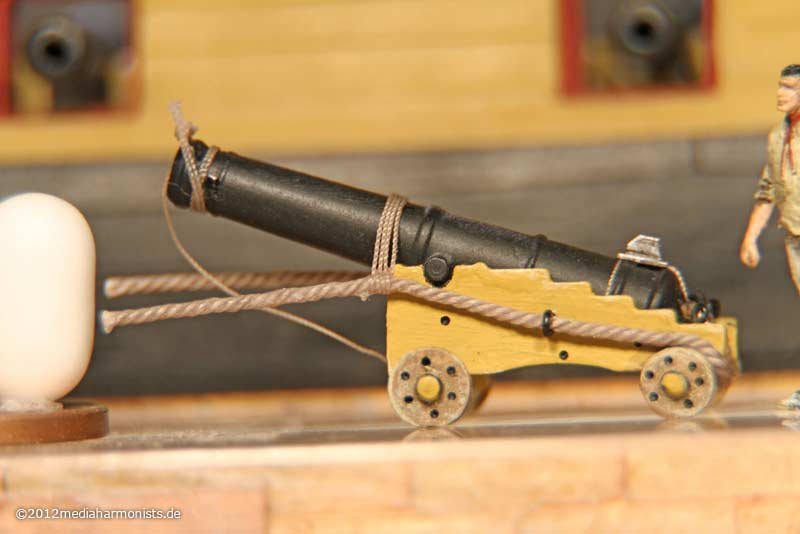 ... I do remember why :-)Lieber Gruß, Daniel
... I do remember why :-)Lieber Gruß, Daniel -
Baby feel the thread...don't fear the Reeper
... and now we are going through the thick ;-)Some of the samples that came out:Here are the different raw materials that were used from right to left:No 20 crochet thread - the thinnest from the wool shop -, a 0,4 mm metal thread for comparison, the fuzzy yarn from the supermarket, the 3/0 Uni, the 6/0 Uni, das 8/0 Uni, the 17/0 uni and the fil au chinois.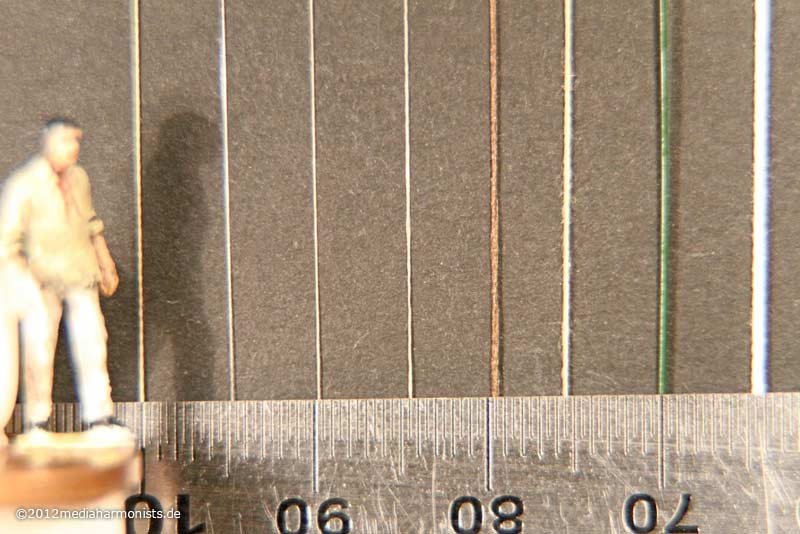 Here the macros from the tests (the laid ropes were done in an early stage, so they are still quite uneven), the numbers indicate the number of strands.Supermarkets´yarn
Here the macros from the tests (the laid ropes were done in an early stage, so they are still quite uneven), the numbers indicate the number of strands.Supermarkets´yarn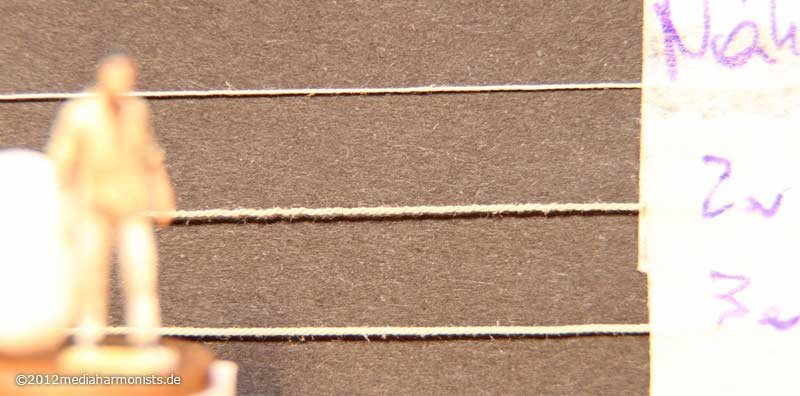 Fil au chinois
Fil au chinois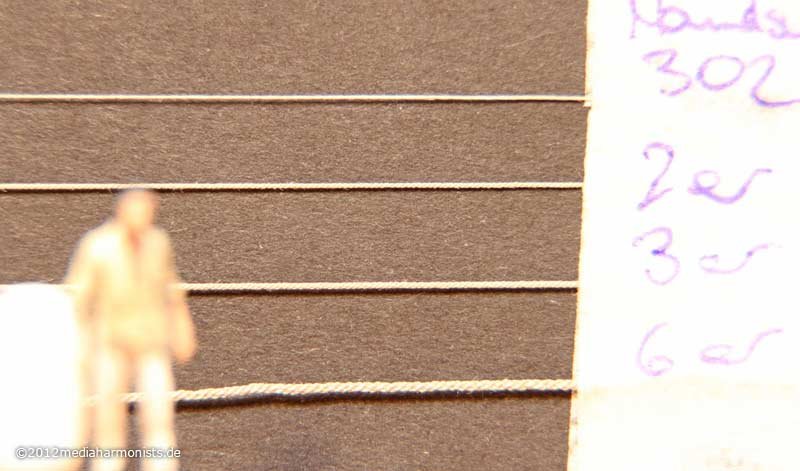 8/0er Uni
8/0er Uni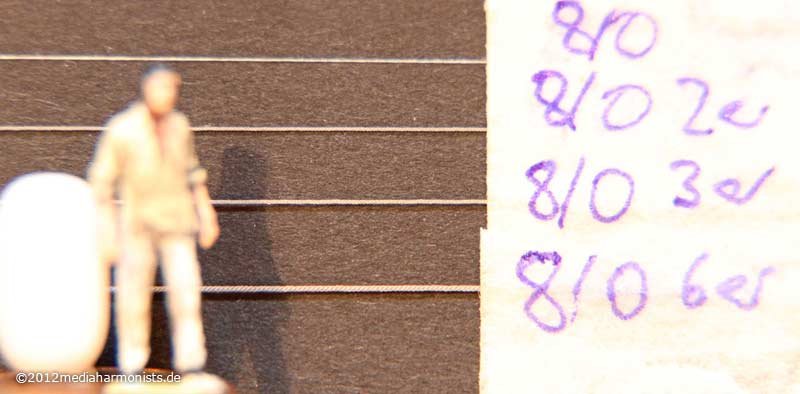 After I found no color scale in the shop, I ordered all colors that were not unsuitable for sure. So I used the surplus colors for the tests, here the Rusty Brown:The great result is, that I can do everything I need with the Uni 8/0 :-) :-) :-)
After I found no color scale in the shop, I ordered all colors that were not unsuitable for sure. So I used the surplus colors for the tests, here the Rusty Brown:The great result is, that I can do everything I need with the Uni 8/0 :-) :-) :-)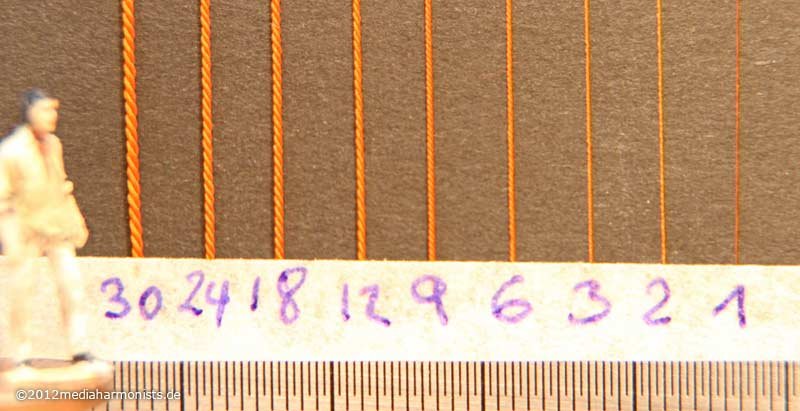 And again the numbers indicate the number of single strands. The AOTS of the Vic shows a nice tablature about all the ropes and their required sizes. And once again I see, that we often take too thick lines for the rigging ...The lower shrouds should be a 30, the ratlines the pure yarn!!!Twists and turnsApart from the 2 and 3 stranded rope it is possible to make Z and S laid ropes as required :-) Those two ones mentioned have first to be untwisted, which results in a more uneven rope. But as they are so thin that it is impossible to be seen in a model of that scale, there is always a possibility of cheating ;-) :-)ColorsOne of the reasons to do my own rope was to be able to choose the color. The available once for the standing rigging are too black, the one for the running rigging to colorful. Research in the reenactment-scene shows faded grey ropes: http://europe-today.ru/2012/03/stroitelstvo-kak-1200-let-nazad/.I choose the color Tan, as it is avaliable in 8/0 and 6/0 and I will help perhaps with a little bit of ink once it is installed.For the black I found a nice solution: I mix colors while laying :-)Black with dark brown gives exactely the shade I found on old tarred ropes :-)
And again the numbers indicate the number of single strands. The AOTS of the Vic shows a nice tablature about all the ropes and their required sizes. And once again I see, that we often take too thick lines for the rigging ...The lower shrouds should be a 30, the ratlines the pure yarn!!!Twists and turnsApart from the 2 and 3 stranded rope it is possible to make Z and S laid ropes as required :-) Those two ones mentioned have first to be untwisted, which results in a more uneven rope. But as they are so thin that it is impossible to be seen in a model of that scale, there is always a possibility of cheating ;-) :-)ColorsOne of the reasons to do my own rope was to be able to choose the color. The available once for the standing rigging are too black, the one for the running rigging to colorful. Research in the reenactment-scene shows faded grey ropes: http://europe-today.ru/2012/03/stroitelstvo-kak-1200-let-nazad/.I choose the color Tan, as it is avaliable in 8/0 and 6/0 and I will help perhaps with a little bit of ink once it is installed.For the black I found a nice solution: I mix colors while laying :-)Black with dark brown gives exactely the shade I found on old tarred ropes :-)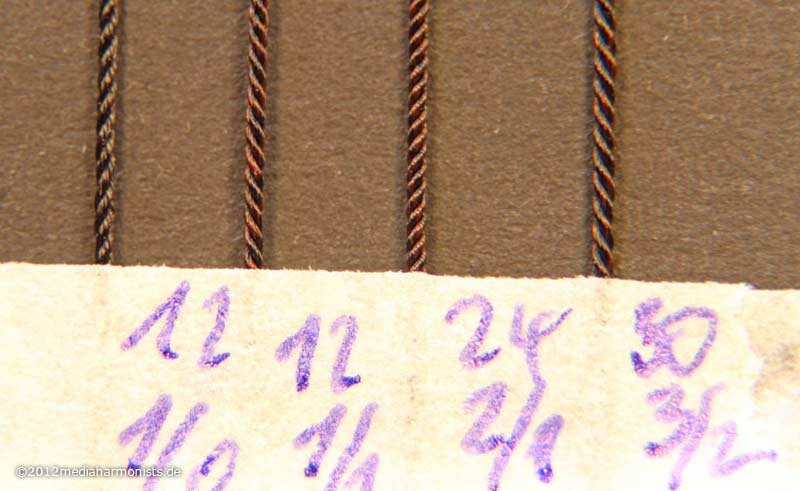 The color can be nicely adjusted by the quantities of the colors within the mixing. Also you can nicely see the different hands on the picture.As for the running rigging I will possibly also mix in some strands of a less colorful yarn.Laying cablesAnd then the hour of truth: Using the self made ropes to make cables for anchor and shrouds:
The color can be nicely adjusted by the quantities of the colors within the mixing. Also you can nicely see the different hands on the picture.As for the running rigging I will possibly also mix in some strands of a less colorful yarn.Laying cablesAnd then the hour of truth: Using the self made ropes to make cables for anchor and shrouds: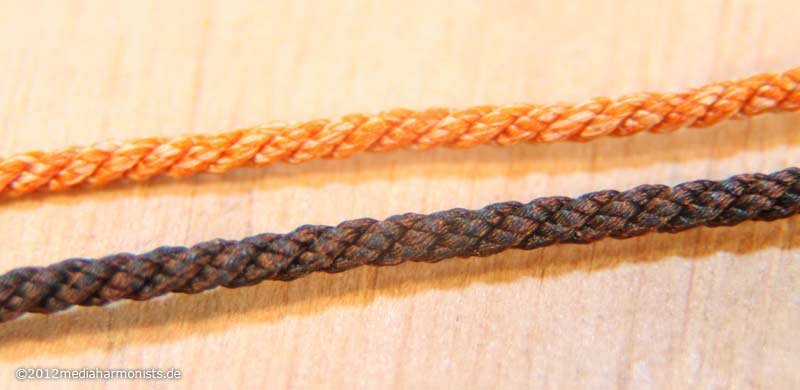 Looks promising ;-)Baby feel the thread...don't fear the ReeperThe best is, the production now goes so easily and uncomplicatedly that I will not prepare to much rope in advance and will lay it as "just in time production" in the needed quantity and thickness while rigging :-)So the first production for the lower deck is done ...
Looks promising ;-)Baby feel the thread...don't fear the ReeperThe best is, the production now goes so easily and uncomplicatedly that I will not prepare to much rope in advance and will lay it as "just in time production" in the needed quantity and thickness while rigging :-)So the first production for the lower deck is done ...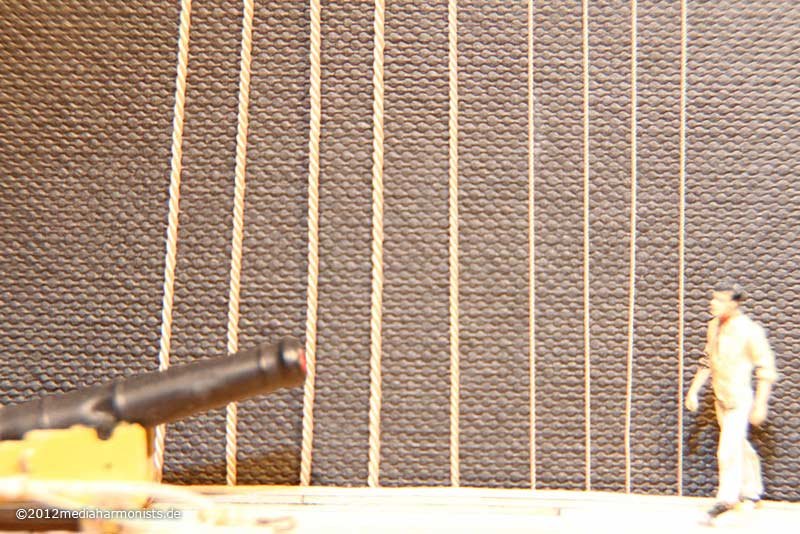 ... and please tune in again when we come to the next line of the famous song ...Come on baby...don't fear the ReeperBaby feel the thread...don't fear the ReeperWe'll be able to tie...don't fear the ReeperAlles Gute, Daniel
... and please tune in again when we come to the next line of the famous song ...Come on baby...don't fear the ReeperBaby feel the thread...don't fear the ReeperWe'll be able to tie...don't fear the ReeperAlles Gute, Daniel -
Come on baby...don't fear the ReeperBaby feel the thread...don't fear the ReeperIf one is stuck one should do what should have been done in the start - Listen to your inner voice and listen to the others :-)Not: "I-wanna-have-a-ropewalk-and-do-same-nice-ropes-as-seen-on-the-modelling-exhibition" but "I-need-great-ropes-for-my-Vic" :-)That changes a lot as I am building a completely different scale. Changes a lot towards the materials and the usage of the walk. So freshly focussed back to work:First listen to the others: Oli/Modellbaumechaniker and Holger/Pollux from my german forums gave me the right hints for the right materials. Fil au chinois and flyfishing lines were the right hints!
And this is what came:The bigger bobbins are the fil au chinois, numbers for the colors see the pictureThe smaller bobbin sare from the flyfishing, Uni-Thread green 8/0 the thin one, orange 6/0 the middle one, the thick 3/0 and the superthin 17/0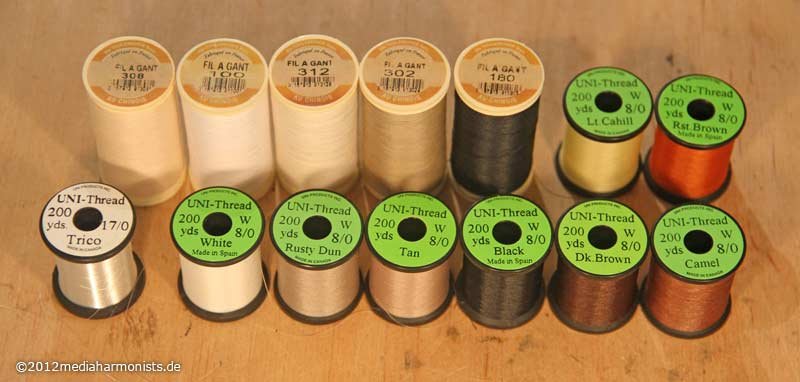
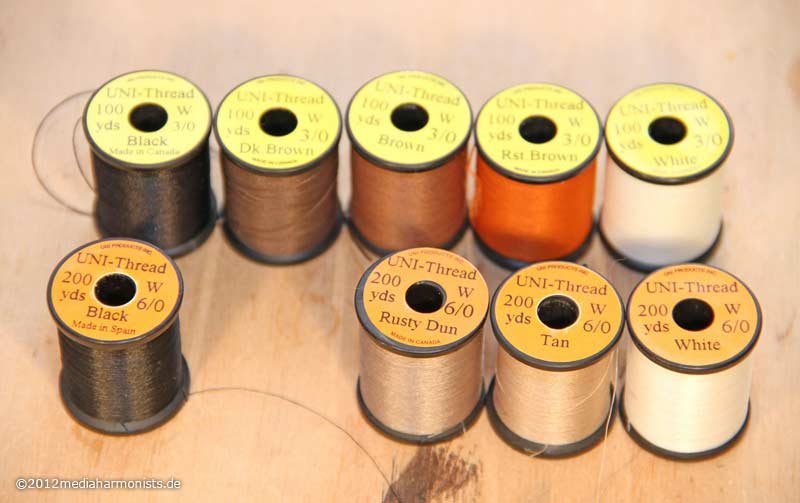 The fil au chinois is cotton with very little fussy bits, the Uni is free of fuzz :-)The Uni has a large range of colors avaliable, unfortunately not all colors in all sizes. The 8/0 and 6/0 are great for my purpose, the 3/0 has the great appearence of colored dental floss and the 17/0 is also quite uneven and transparent.First tests proved to be the right direction sizewise :-)Left the fuzzy thread from the supermarket, my thinnest possibility before this date. Then comes the fil au chinois, the Uni 8/0 and the Uni17/0, always the original strand, then two, 3 and 6 stranded with blocks of 3 mm, 2 mm and 1,5 mm for comparison.
The fil au chinois is cotton with very little fussy bits, the Uni is free of fuzz :-)The Uni has a large range of colors avaliable, unfortunately not all colors in all sizes. The 8/0 and 6/0 are great for my purpose, the 3/0 has the great appearence of colored dental floss and the 17/0 is also quite uneven and transparent.First tests proved to be the right direction sizewise :-)Left the fuzzy thread from the supermarket, my thinnest possibility before this date. Then comes the fil au chinois, the Uni 8/0 and the Uni17/0, always the original strand, then two, 3 and 6 stranded with blocks of 3 mm, 2 mm and 1,5 mm for comparison.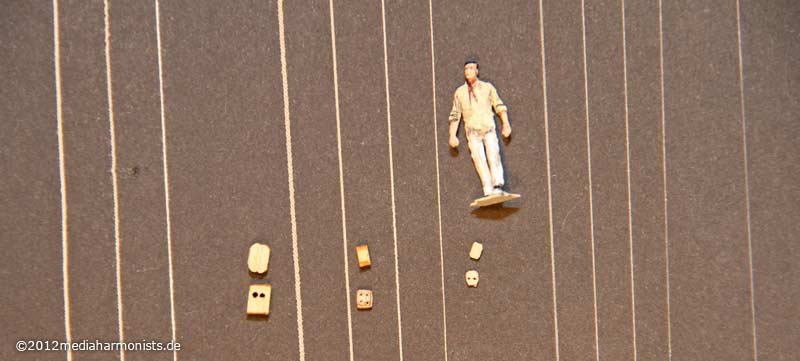 And the first test also showed that turning the axis by hand is a tad tiring and the cordless screwdriver is a little bit unhandy and also too insensitive ......So ...... reopening the Fischertechnik box from my youth, getting the motors out, glueing them with double sided tape onto the machinery, here the pretwisting side to be seen ...
And the first test also showed that turning the axis by hand is a tad tiring and the cordless screwdriver is a little bit unhandy and also too insensitive ......So ...... reopening the Fischertechnik box from my youth, getting the motors out, glueing them with double sided tape onto the machinery, here the pretwisting side to be seen ...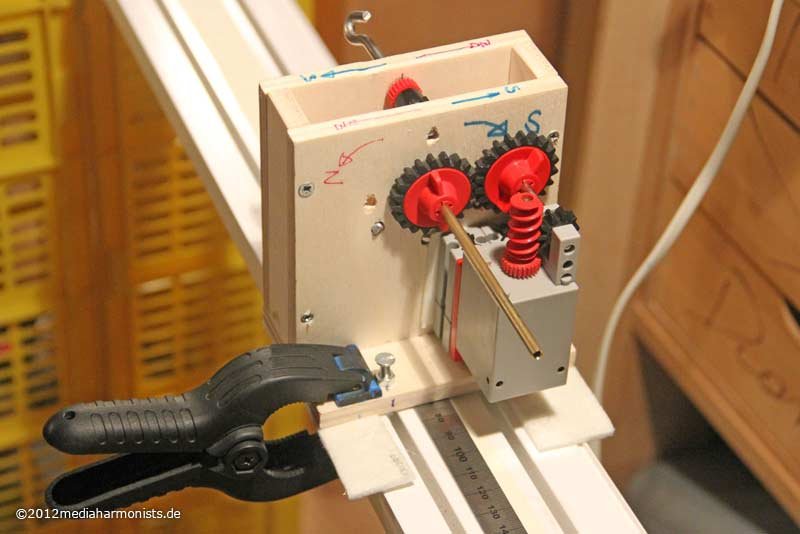 ... and the laying side ...
... and the laying side ...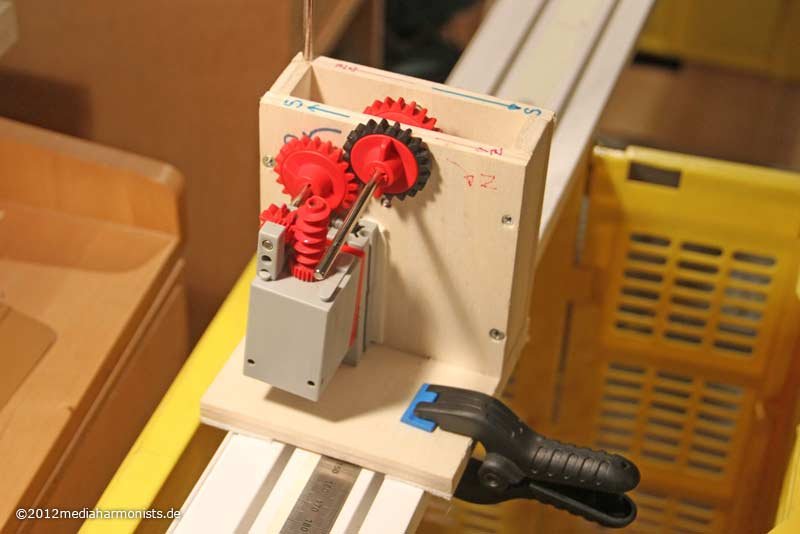 ... the motor can be turned sideways to reposition the hooks ...
... the motor can be turned sideways to reposition the hooks ...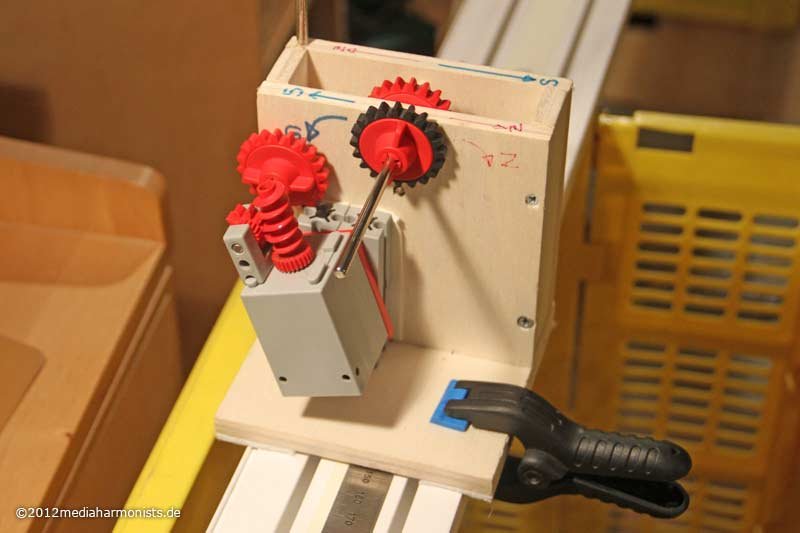 ... and felt was put untderneath for easy gliding, and a steel ruler in the middle to control the movements of the sliding parts :-)Both sides were clampedto the rail to be able to put the yarn properly. After chasing behind the bobbin for several times, a holder like the sewing machines ones was introduced, and from there the the yarn was brought to the hooks of the pretwisting side - I am showing a 6-stranded rope - ...
... and felt was put untderneath for easy gliding, and a steel ruler in the middle to control the movements of the sliding parts :-)Both sides were clampedto the rail to be able to put the yarn properly. After chasing behind the bobbin for several times, a holder like the sewing machines ones was introduced, and from there the the yarn was brought to the hooks of the pretwisting side - I am showing a 6-stranded rope - ...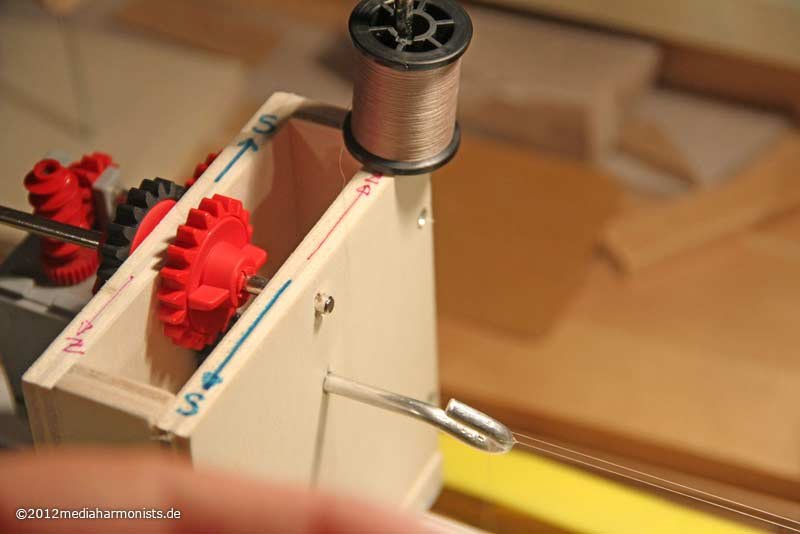 ... and after 3 times twice forth and back ...
... and after 3 times twice forth and back ...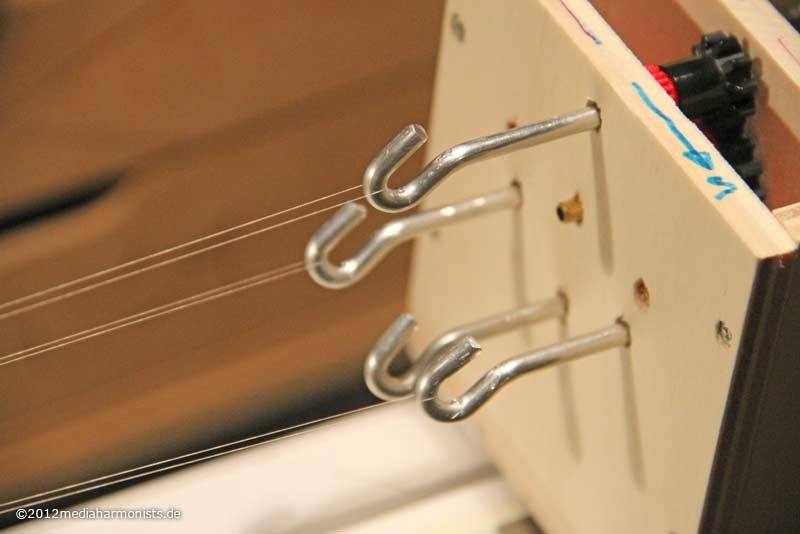 ... the yarn was fixed on the laying side.
... the yarn was fixed on the laying side.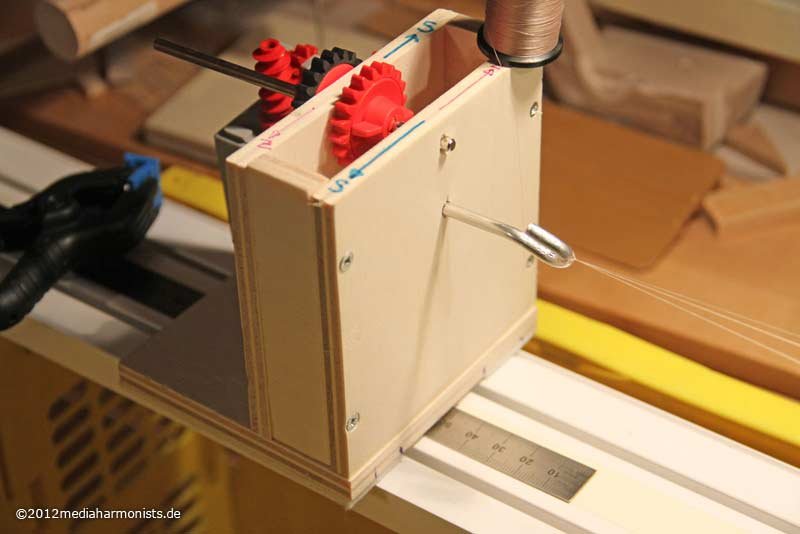 The steel ruler shows the movement of the slide - I use 10% on this rope - loosen the clamp on the laying side, the pretwisting hooks start turning and the opposite slide starts moving miraculously towards the predrilling slide :-)
The steel ruler shows the movement of the slide - I use 10% on this rope - loosen the clamp on the laying side, the pretwisting hooks start turning and the opposite slide starts moving miraculously towards the predrilling slide :-)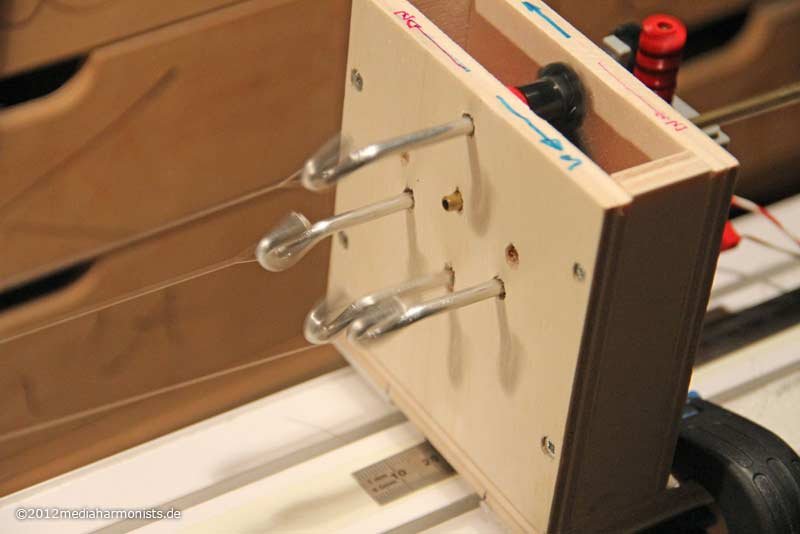 If the required distance is achieved, I clamp both sides onto the rail, and the three strands are laid until the required tension is achieved ...
If the required distance is achieved, I clamp both sides onto the rail, and the three strands are laid until the required tension is achieved ...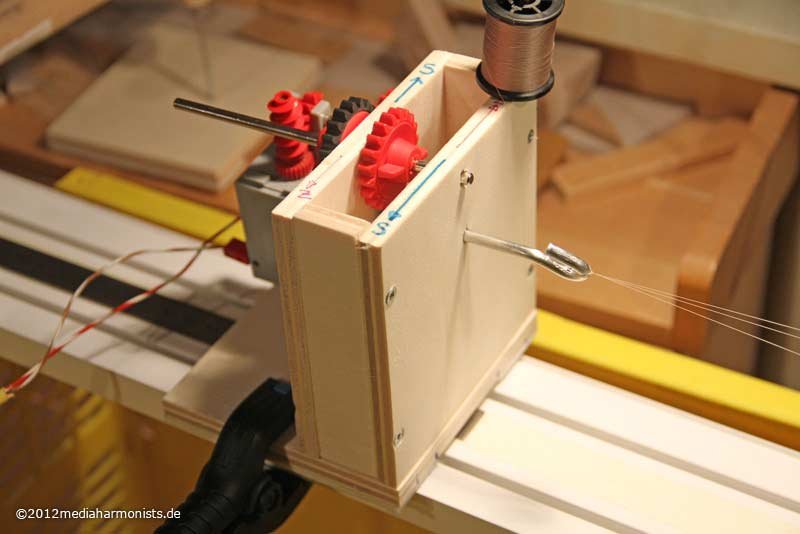 ... some CA for fixing ...
... some CA for fixing ...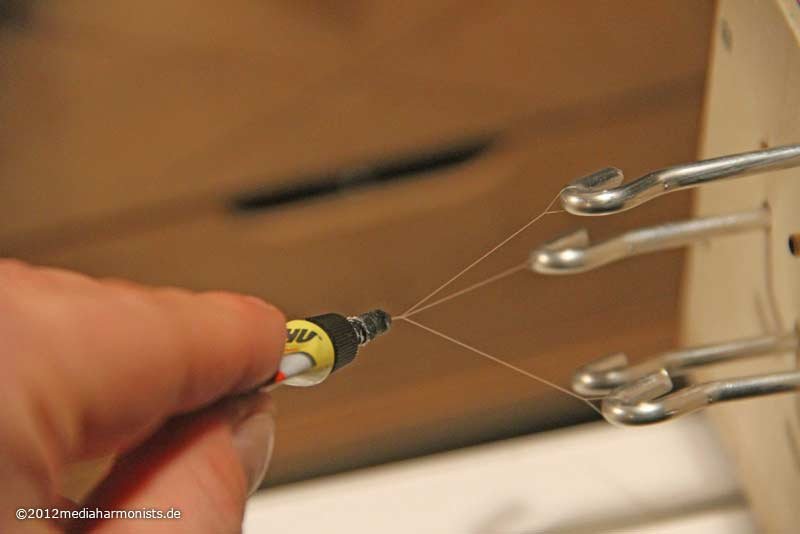 ...going with the fingernails over to release unwanted tension ...
...going with the fingernails over to release unwanted tension ...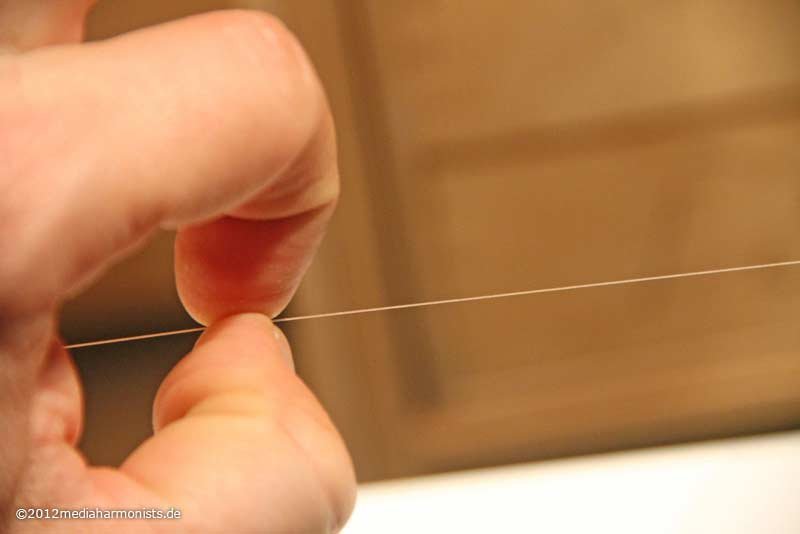 ... and you can make a clean cut :-)Lessons learnedYou can see two things:First: I am not using any more the little guide block :-)No difference to be seen apart from that it is much more even ;-)Secondly: I am fixing both sides while laying the rope! In the first trials I had the trouble, that the start of the rope was coming out nicely tight and the second half was much more loose ...I realised that at the start of laying the pretwisting slide does not move, and the shortening of the rope is only compensated by the lateral spreading of the yarn. Just later on the slide starts moving. But it was not just after I forgot once to remove the clamp of this slide and got out a great and even clean cable that I realised, that the loosness of the rope came from the missing tension on the other side.The next tests without the guide and fixed slides prooved to be successful :-) Just if the motor is having to work too hard, I stop it and I loosen the tension a tad by carefully moving the slide and then contimue.Come on baby...don't fear the ReeperBaby feel the thread...don't fear the Reeper... and the part that should be pronounced is: feel the thread :-)XXXDAn
... and you can make a clean cut :-)Lessons learnedYou can see two things:First: I am not using any more the little guide block :-)No difference to be seen apart from that it is much more even ;-)Secondly: I am fixing both sides while laying the rope! In the first trials I had the trouble, that the start of the rope was coming out nicely tight and the second half was much more loose ...I realised that at the start of laying the pretwisting slide does not move, and the shortening of the rope is only compensated by the lateral spreading of the yarn. Just later on the slide starts moving. But it was not just after I forgot once to remove the clamp of this slide and got out a great and even clean cable that I realised, that the loosness of the rope came from the missing tension on the other side.The next tests without the guide and fixed slides prooved to be successful :-) Just if the motor is having to work too hard, I stop it and I loosen the tension a tad by carefully moving the slide and then contimue.Come on baby...don't fear the ReeperBaby feel the thread...don't fear the Reeper... and the part that should be pronounced is: feel the thread :-)XXXDAn -
Come on baby...don't fear the Reeper...Let´s go back to the glorious days, when a little dafi was all proud reporting about his own-build Reeperbahn (ropewalk) ...
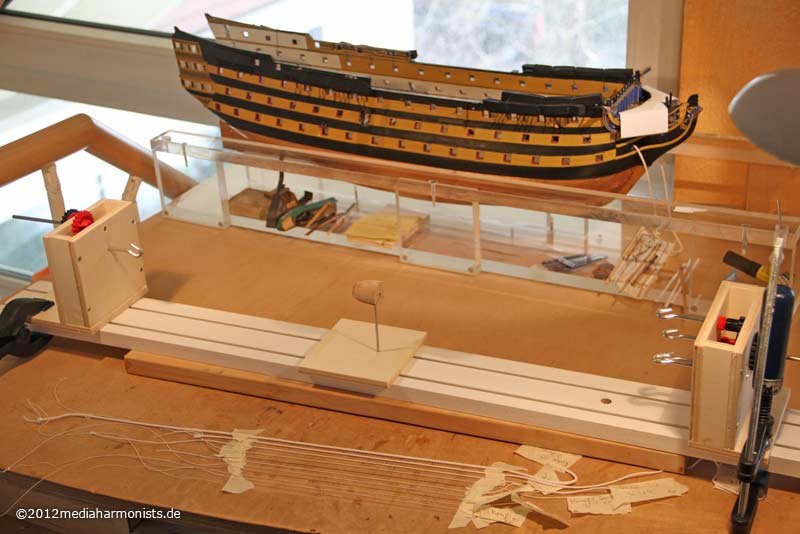 ... showing happily his first ropes ...
... showing happily his first ropes ...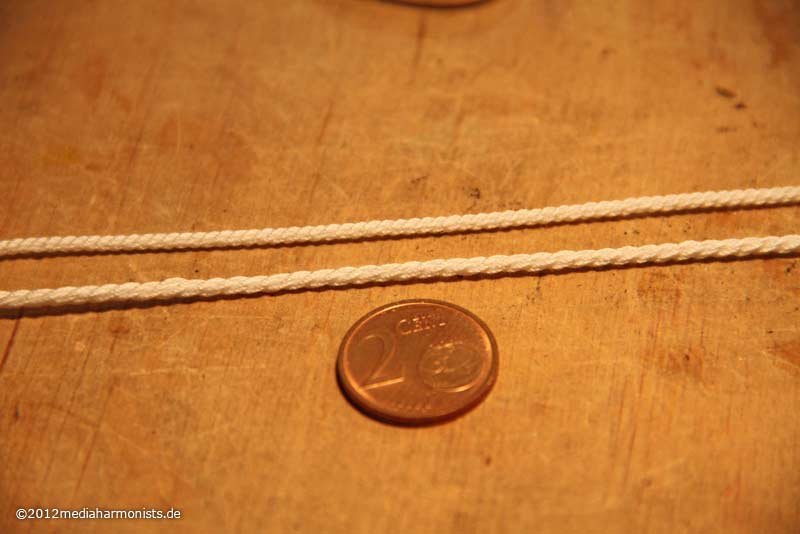 ... and all the crochet threads he bought in the neighbourhood and the world-wide-web ...
... and all the crochet threads he bought in the neighbourhood and the world-wide-web ... ... and how he rope-walked and walked the rope ...
... and how he rope-walked and walked the rope ...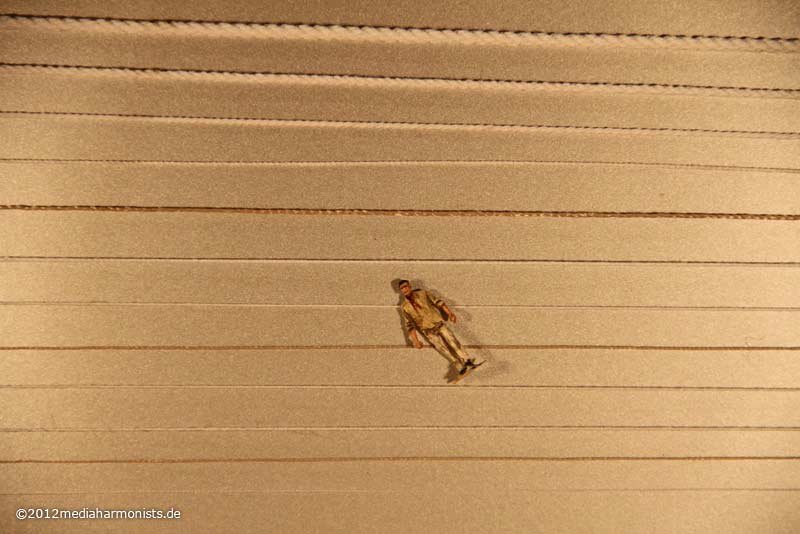 ... changed his place into a painters place ...
... changed his place into a painters place ...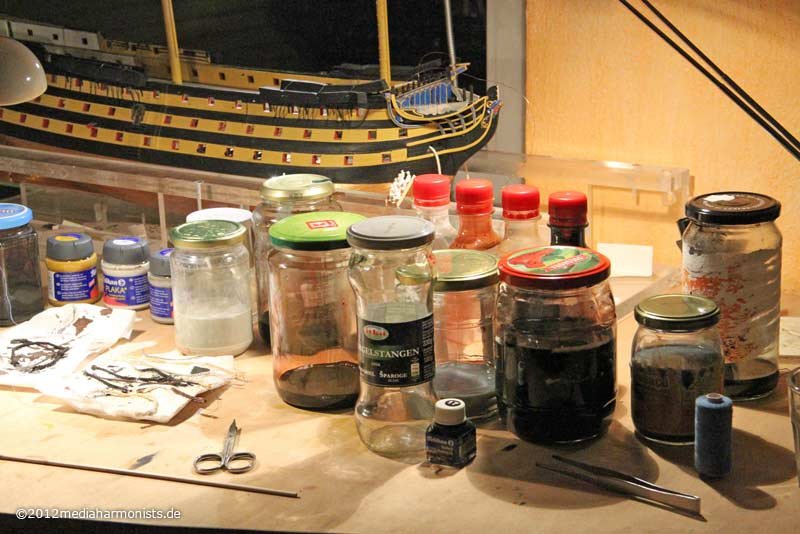 ... and did many-many-many test to find the one and only right and trueful color for his new ropes ...
... and did many-many-many test to find the one and only right and trueful color for his new ropes ...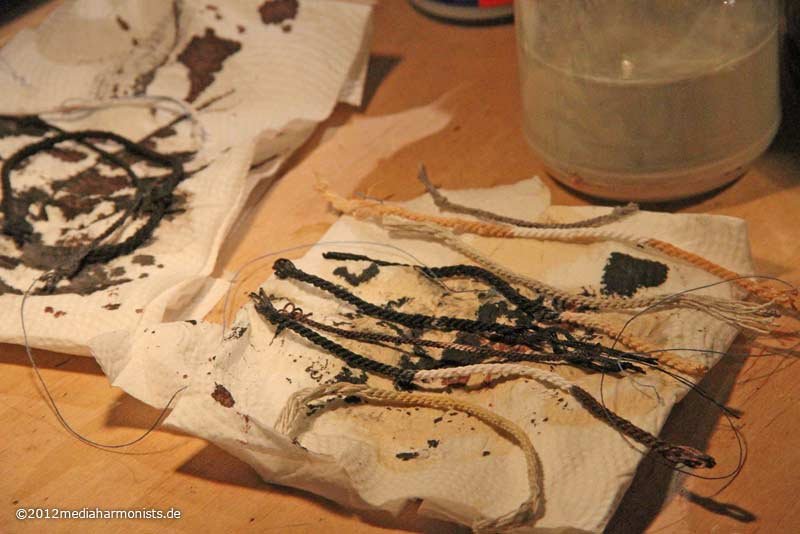 ... until he questioned:What am I doing here?As nicely to be seen ...... everything much to thick for his purpose ... :-(And the colors? Did not work either ... the pure stain wrong colors, mixing did not work ... the black was too blueish, mixing with dark brown resulted in blueish blackish ropes with a brown core as the brown penetrated and the black resided just on the surface ... other paints and inks were not so successful either ...
... until he questioned:What am I doing here?As nicely to be seen ...... everything much to thick for his purpose ... :-(And the colors? Did not work either ... the pure stain wrong colors, mixing did not work ... the black was too blueish, mixing with dark brown resulted in blueish blackish ropes with a brown core as the brown penetrated and the black resided just on the surface ... other paints and inks were not so successful either ...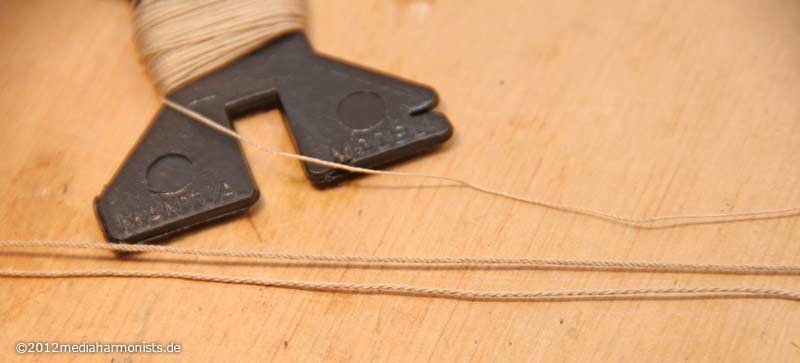 ... and also the ropes were too uneven, the start always tighter done than the end, as can be seen, the middle line is the start and the one underneath is the same rope, just the end ...... ok, think it over ...... and especially ...Don´t fear the Reeper
... and also the ropes were too uneven, the start always tighter done than the end, as can be seen, the middle line is the start and the one underneath is the same rope, just the end ...... ok, think it over ...... and especially ...Don´t fear the Reeper -
These thimbles were a side product of having to paint the white sheaves of my micro blocks. Thinking how to do them out of black material. Remembered a trick from the WW1 plane builders, that do the locks of the bracing wires by heating up a Q-Tit and pulling it to the needed diameter. The same system as we use to du with sprue it keeps the hole inside in the right proportion to the diameter.This in mind I thought this could also work in a bigger diameter, slipped some 8 mm sprue into the machine ...
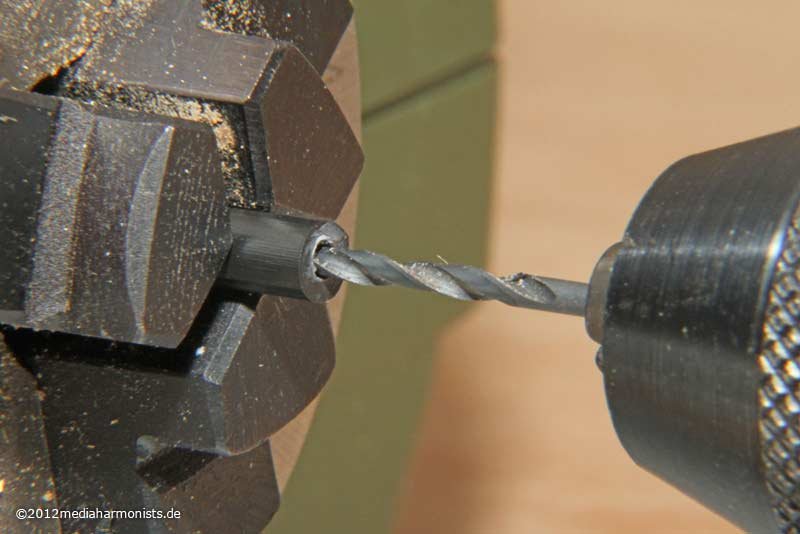 ... drilled slowly with 4 mm turning the chuck by hand ...
... drilled slowly with 4 mm turning the chuck by hand ...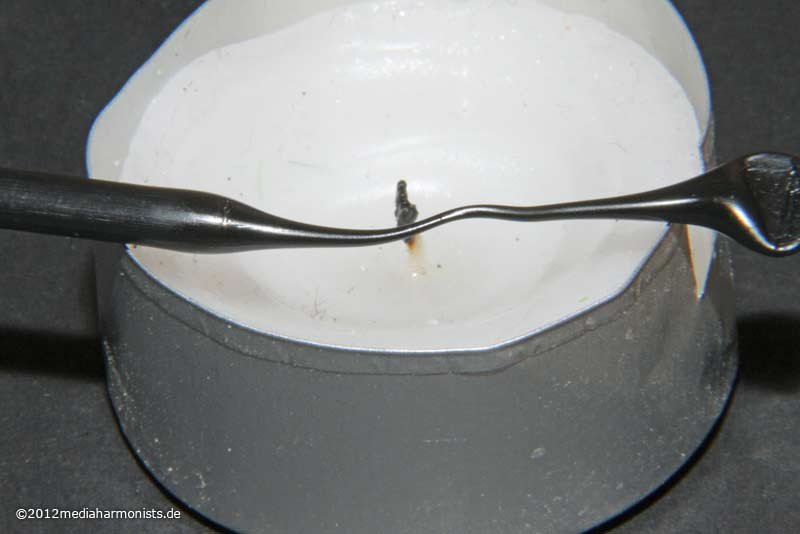 ...heated up and pulled (ok could be done more evenly) ...
...heated up and pulled (ok could be done more evenly) ...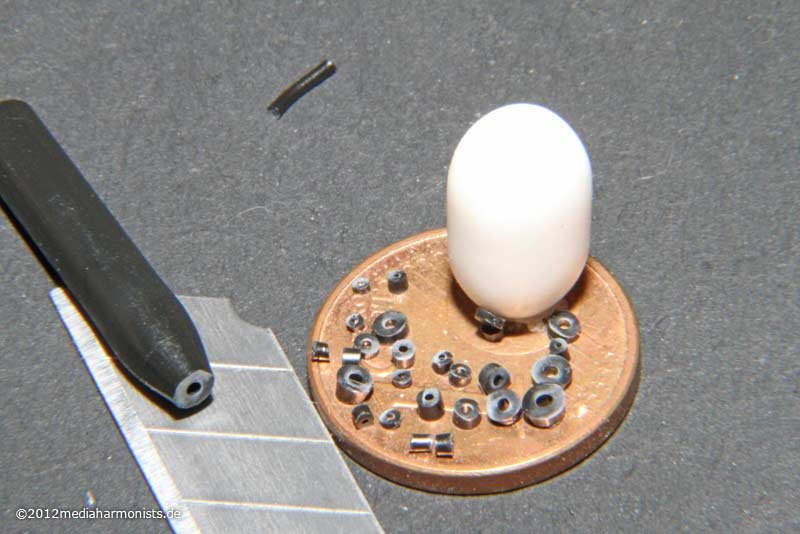 ... and cut onto the right lengths and got a nice variety of discs, sheaves and raw material for thimbles :-)Tried to enlarge the ring by using the cone of the drill did not really work.
... and cut onto the right lengths and got a nice variety of discs, sheaves and raw material for thimbles :-)Tried to enlarge the ring by using the cone of the drill did not really work.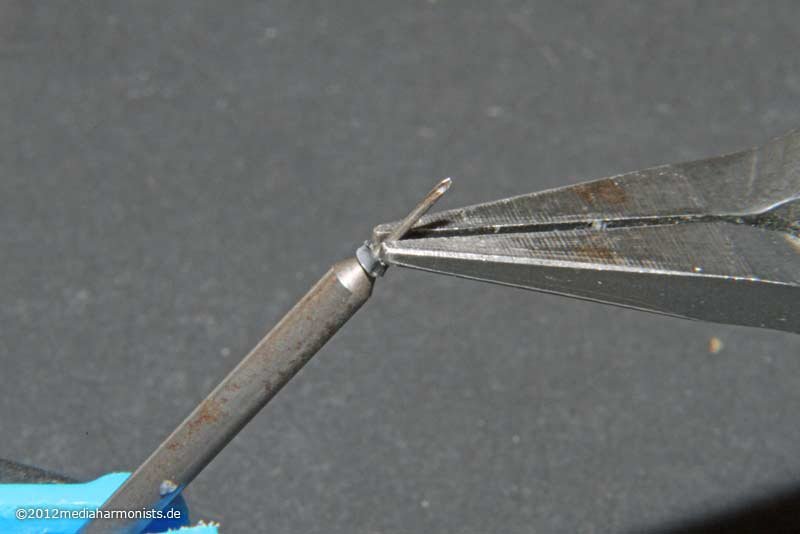 Used two needles as marlinspikes to do a splice ...
Used two needles as marlinspikes to do a splice ... ... put the required disc in, tacked it with a drop of CA, adjusted and finally glued it properly in position and opened the hole carefully a little bit more with a drill ...
... put the required disc in, tacked it with a drop of CA, adjusted and finally glued it properly in position and opened the hole carefully a little bit more with a drill ...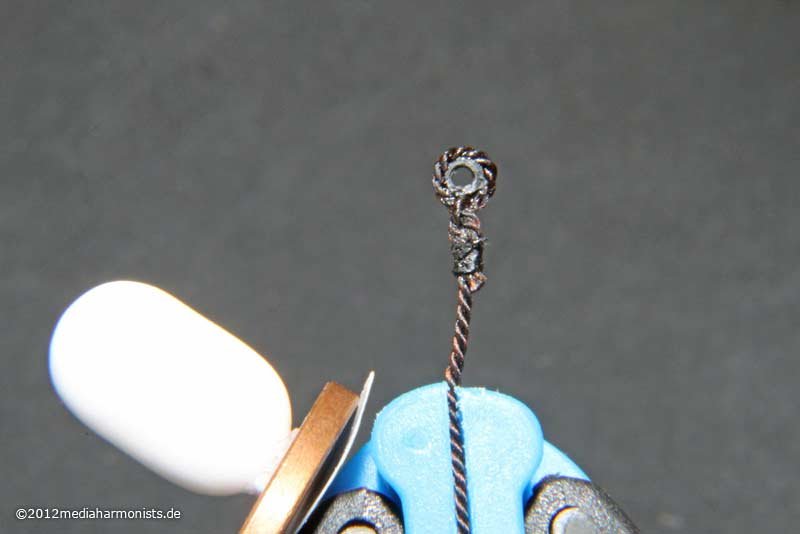 ... and worked on the edges with the 1 mm cherry miller.
... and worked on the edges with the 1 mm cherry miller.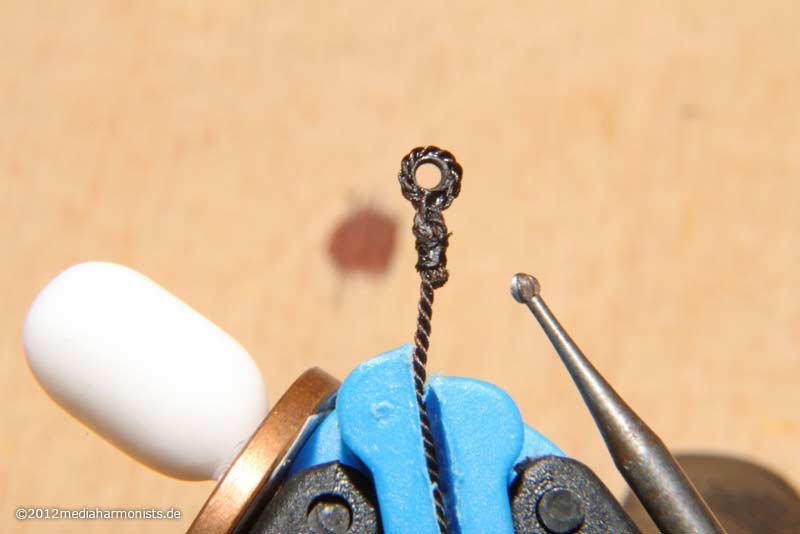 The proportions still could be improved, but I found a nice solution for myself for the thimbles :-)In the size I am building it is a little bit difficult to do them out of metal tube or injection needles.All the best, DanielI hope to not bother you too much - in last case we have to found a self-help group, something like "dafinists anonymus" or so ...:-) :-) :-)XXXDAn
The proportions still could be improved, but I found a nice solution for myself for the thimbles :-)In the size I am building it is a little bit difficult to do them out of metal tube or injection needles.All the best, DanielI hope to not bother you too much - in last case we have to found a self-help group, something like "dafinists anonymus" or so ...:-) :-) :-)XXXDAn
- Archi, mtaylor and Blue Ensign
-
 3
3
-
And it continued with an answer from Jan here in MSW:You will drive yourself insane!My guess is that your next "problem" will be to get these tiny blocks stropped according the rule book
 Next you will realize that blocks have sheaves,that sheaves are held into position by iron pins,that these pins have nail like heads,that.... etc.We will follow your route to insanity with ever increasing admiration!JanOK-OK-OK, Jan´s challenge was accepted :-) The stropping we had already, so the next is ...
Next you will realize that blocks have sheaves,that sheaves are held into position by iron pins,that these pins have nail like heads,that.... etc.We will follow your route to insanity with ever increasing admiration!JanOK-OK-OK, Jan´s challenge was accepted :-) The stropping we had already, so the next is ...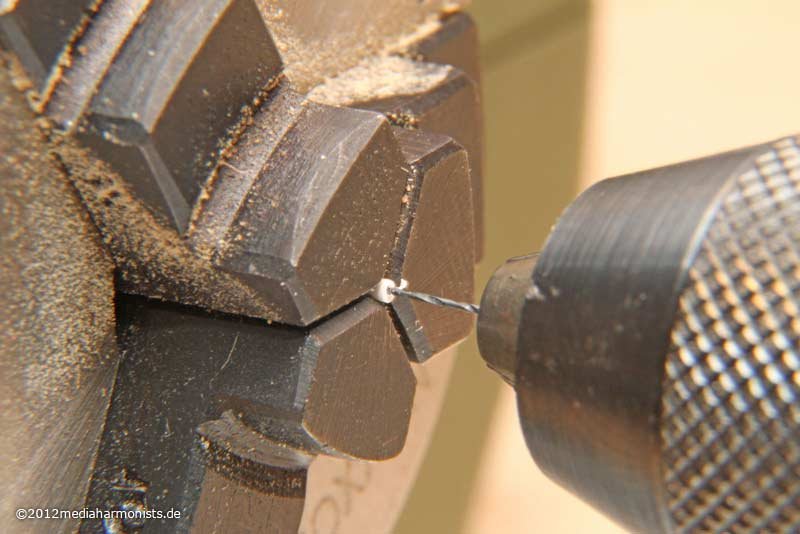 ... put a 1 mm poly rod into the machine, drill with 0,4 mm, turning the chuck of the lathe of course by hand ...
... put a 1 mm poly rod into the machine, drill with 0,4 mm, turning the chuck of the lathe of course by hand ...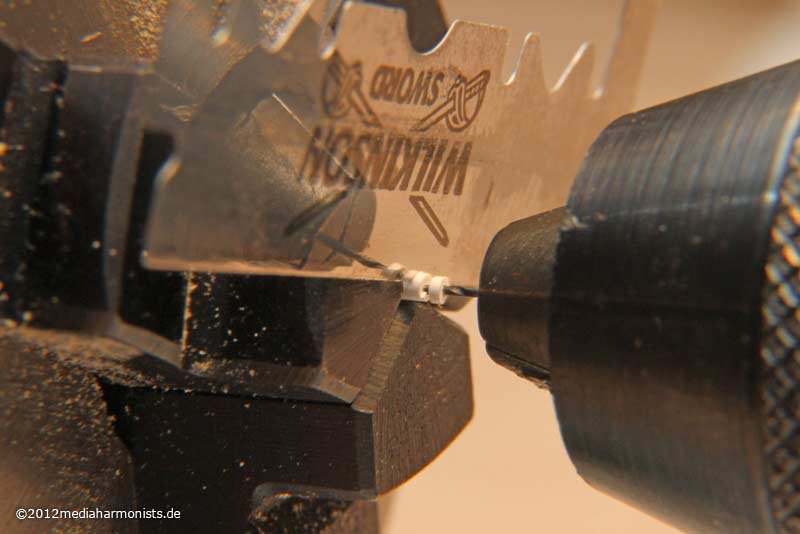 ... and cutting it off still on the drill to 0,5 mm slices ...
... and cutting it off still on the drill to 0,5 mm slices ...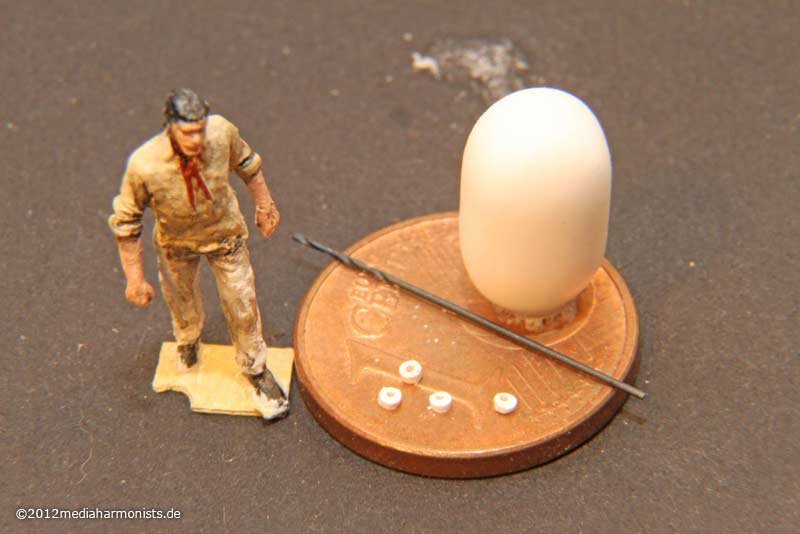 ... and this is the result of the production.So what is missing next for some good blocks? The casing:So milling a double slot and a single slot into a 2,5 mm x 1 mm batten ...
... and this is the result of the production.So what is missing next for some good blocks? The casing:So milling a double slot and a single slot into a 2,5 mm x 1 mm batten ...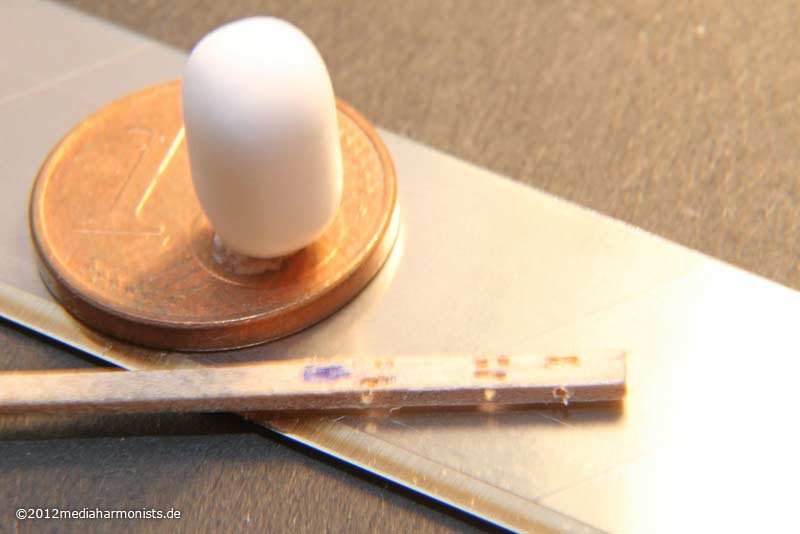 ... doing some carving ...
... doing some carving ...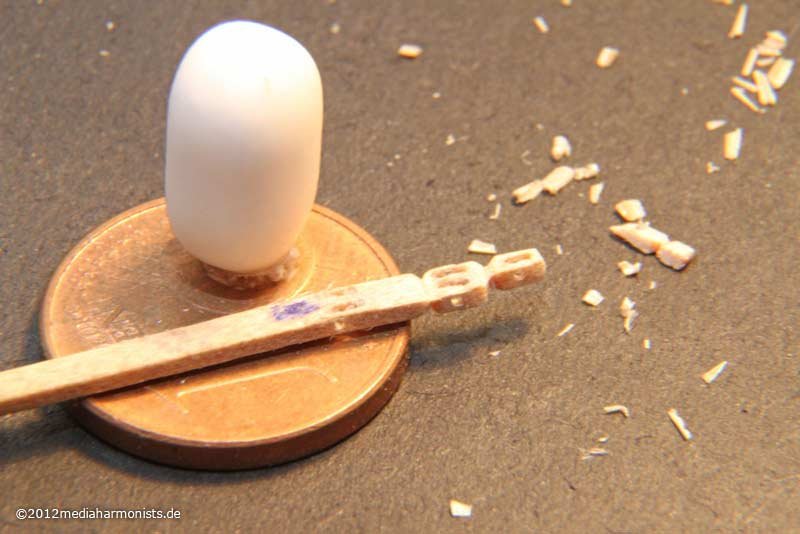 ... colored the disks with marker for not adding to the thickness ...
... colored the disks with marker for not adding to the thickness ... ... inserted the disks and the axles ...
... inserted the disks and the axles ...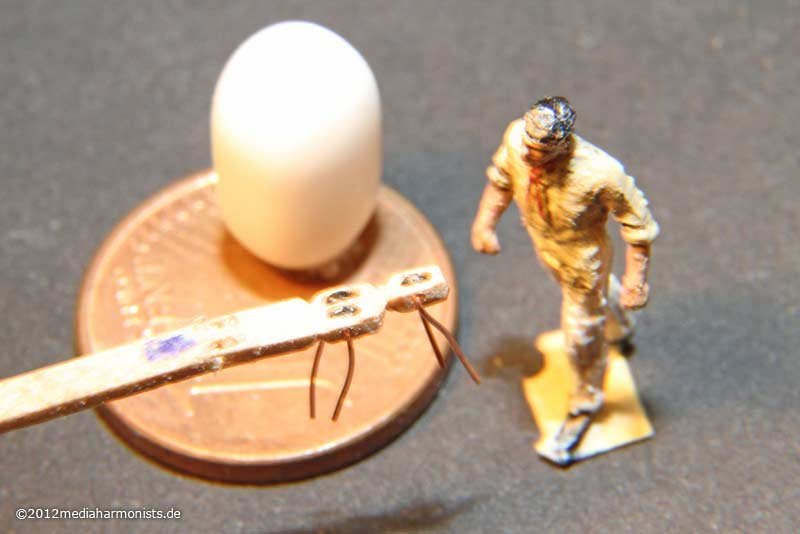 ... and cleared it up.
... and cleared it up.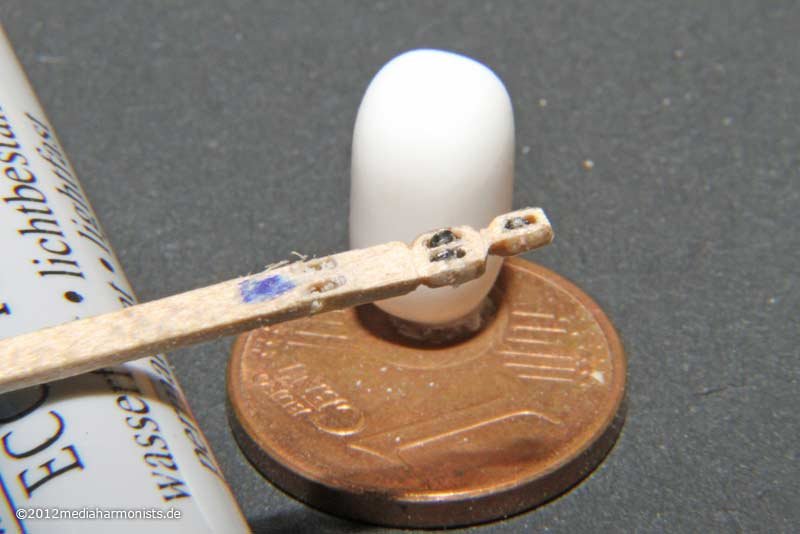 And here the family shot with the benchmark, the wonderful 2 x 2 x 2 mm block from JB.
And here the family shot with the benchmark, the wonderful 2 x 2 x 2 mm block from JB.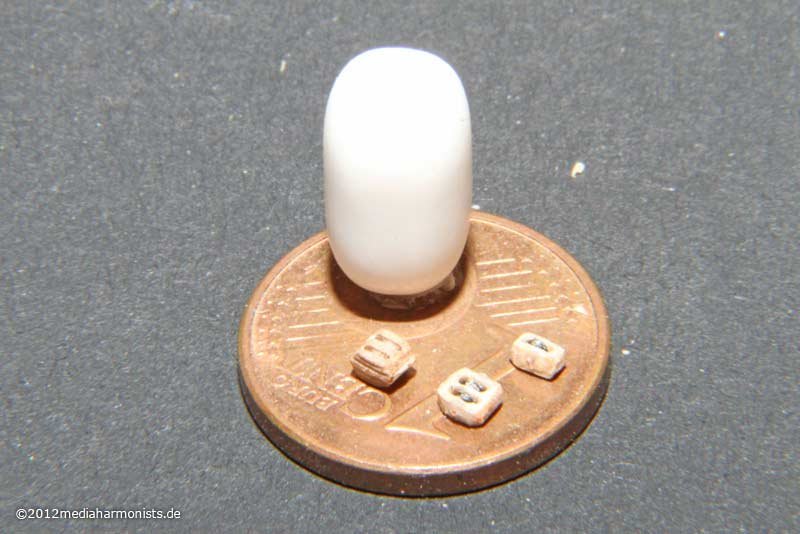 While stropping I finally re-remembered the great power-splice, which makes things easier and cleaner, prepared a loop ...
While stropping I finally re-remembered the great power-splice, which makes things easier and cleaner, prepared a loop ...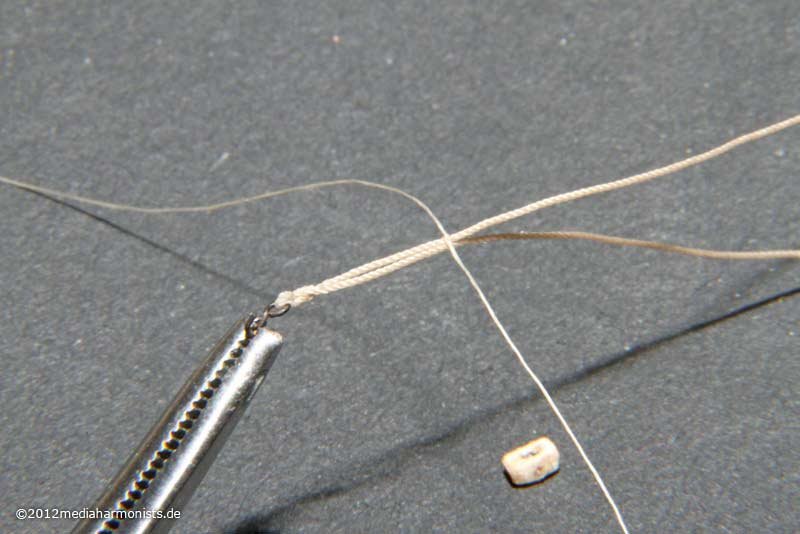 ... and slid the block into it, secured with glue and ...*drummrollandsmallfanfare*
... and slid the block into it, secured with glue and ...*drummrollandsmallfanfare*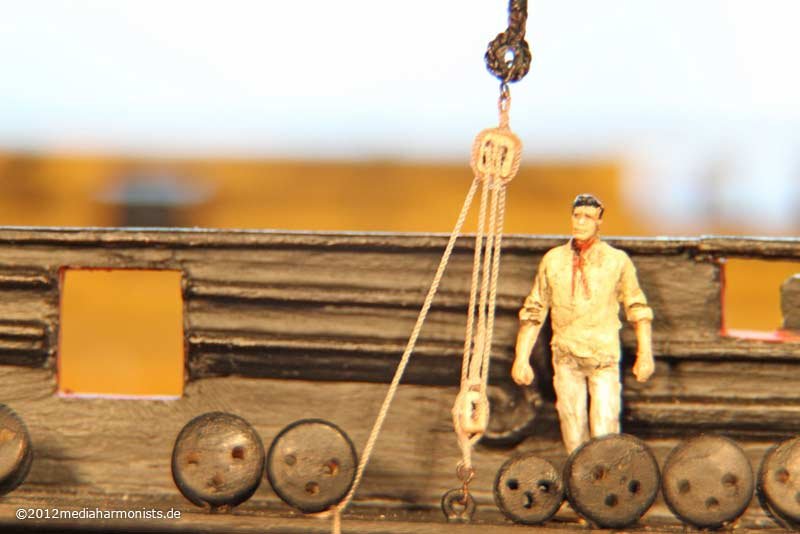 ... and the thing on place :-)Lessons learned:It is really possible to make blocks of 2,5 x 2,5 x 1 mm with turning sheaves! And by pulling on the loose end, the tackle works much easier than the other ones without :-) :-) :-)The most difficult? Checking if the sheaves are turning after securing the axles with glue. Managed to do this with the point of a needle. Confirmed positivly!;-)Liebe Grüße Daniel
... and the thing on place :-)Lessons learned:It is really possible to make blocks of 2,5 x 2,5 x 1 mm with turning sheaves! And by pulling on the loose end, the tackle works much easier than the other ones without :-) :-) :-)The most difficult? Checking if the sheaves are turning after securing the axles with glue. Managed to do this with the point of a needle. Confirmed positivly!;-)Liebe Grüße Daniel -
And some more basic work. To do the side takles of my guns in 1:100 I need small blocks. The smallest commercially available are the 2 mm from JB, great stuff but still a little bit to big for my taste. So I wanted to see what there is still possible :-)Literature shows several ways of doing blocks, most of them done in a similar way, so I am following that, just have to take out most of the machinery because of the size.First I prepared a batten of 1,5 mm high and 1 mm thick, and marked it all 2 mm which gave the basic size of these ambitious project ...
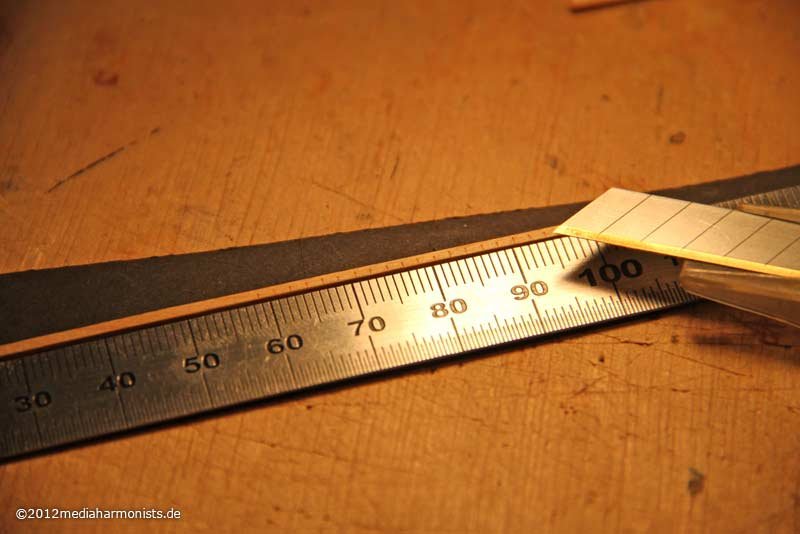 ... each of these marks got a diagonal cut in one direction and after all done, the batten was turned and the other side cut, so the grooves on one side were finished. Repeated on all four sides ...
... each of these marks got a diagonal cut in one direction and after all done, the batten was turned and the other side cut, so the grooves on one side were finished. Repeated on all four sides ...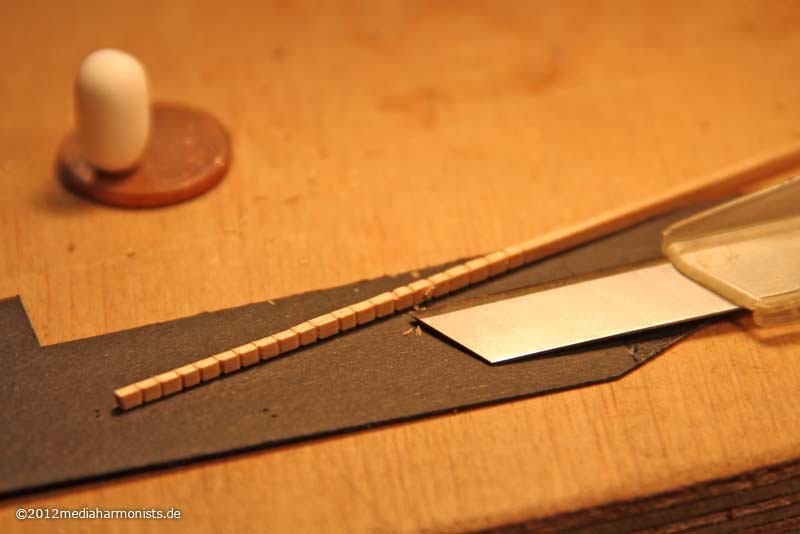 ... and this was achieved rather fast, some matt varnish to strengthen the edges ...
... and this was achieved rather fast, some matt varnish to strengthen the edges ...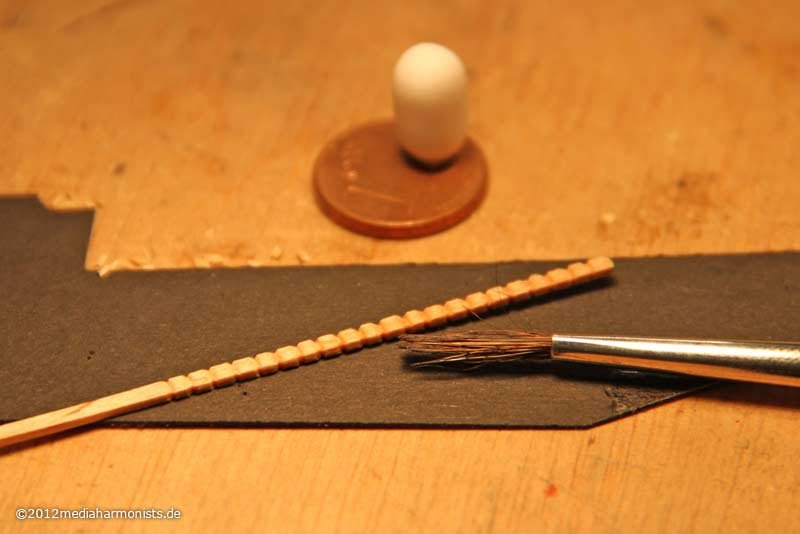 ... and first drilling tests ...
... and first drilling tests ...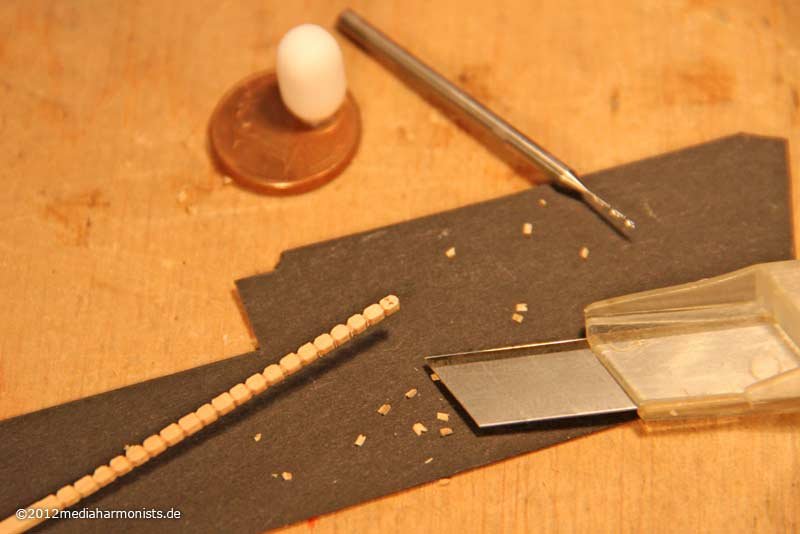 ... with the 0,5er drill. Result, difficult to get the right place, so more testing until it looked like in a swiss cheese factory ...
... with the 0,5er drill. Result, difficult to get the right place, so more testing until it looked like in a swiss cheese factory ...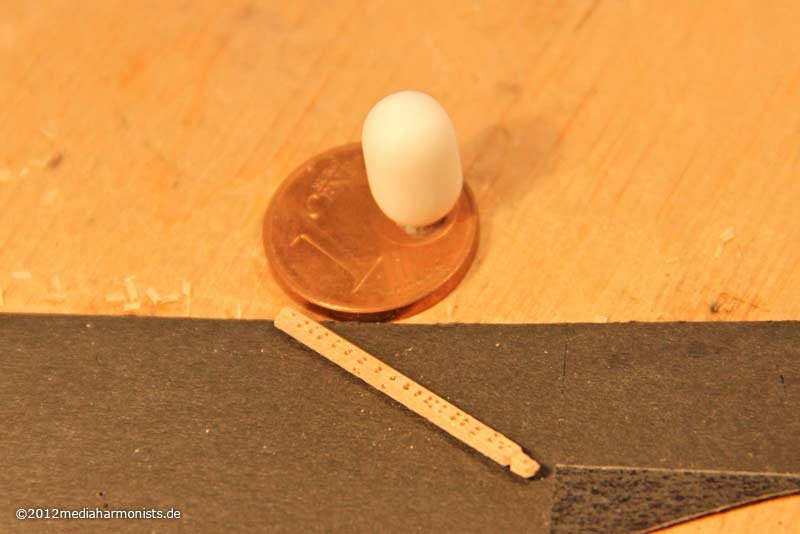 ... and finally the enlightenment: 0,5 mm drill fixed in the stand, a stop in 0,5 mm distance is fixed. The stop has the width of 2 mm which facilitates positioning.Now hold the batten tight and near at both sides and slide it up the stop until drilled ...
... and finally the enlightenment: 0,5 mm drill fixed in the stand, a stop in 0,5 mm distance is fixed. The stop has the width of 2 mm which facilitates positioning.Now hold the batten tight and near at both sides and slide it up the stop until drilled ...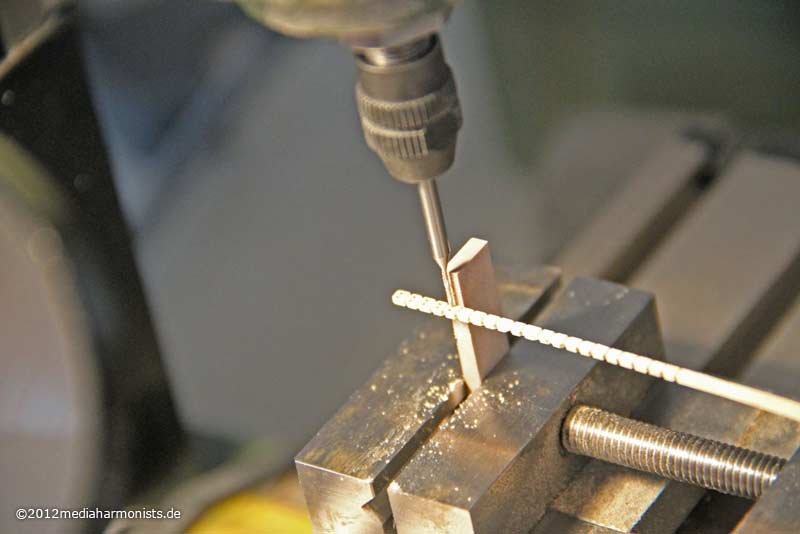 ... move down and turn the batten 180° around the longitudinal axis, slide up and drill the second hole :-)(I spared you the fingers on the picture :-)Looks already ok, the four blocks left of my little worker are the single blocks of 1 mm x 1 mm x 2 mm - hihihihihi - ...
... move down and turn the batten 180° around the longitudinal axis, slide up and drill the second hole :-)(I spared you the fingers on the picture :-)Looks already ok, the four blocks left of my little worker are the single blocks of 1 mm x 1 mm x 2 mm - hihihihihi - ...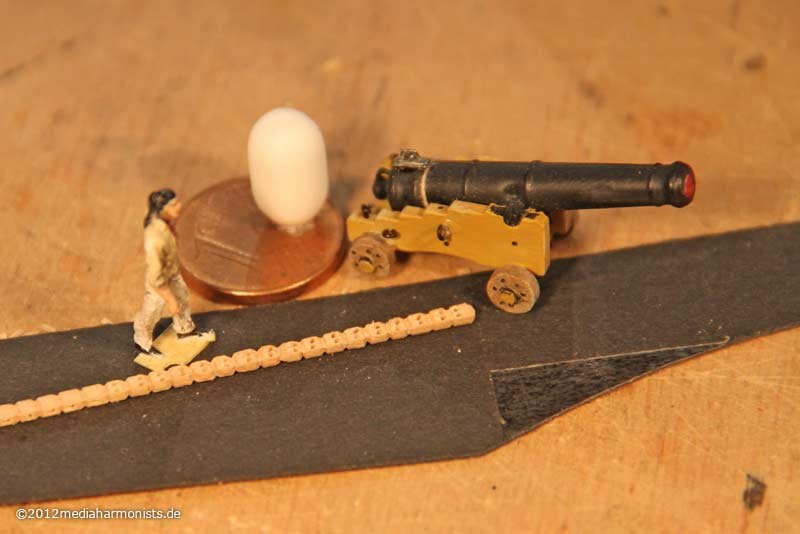 ... a second coat of varnish, the cutter makes the groove on the side for the line - the most difficult part on the whole action - some sanding off of the edges, some more varnish and done. They stay on the batten and will be cut just prior to production for not getting lost - just in time production :-)
... a second coat of varnish, the cutter makes the groove on the side for the line - the most difficult part on the whole action - some sanding off of the edges, some more varnish and done. They stay on the batten and will be cut just prior to production for not getting lost - just in time production :-)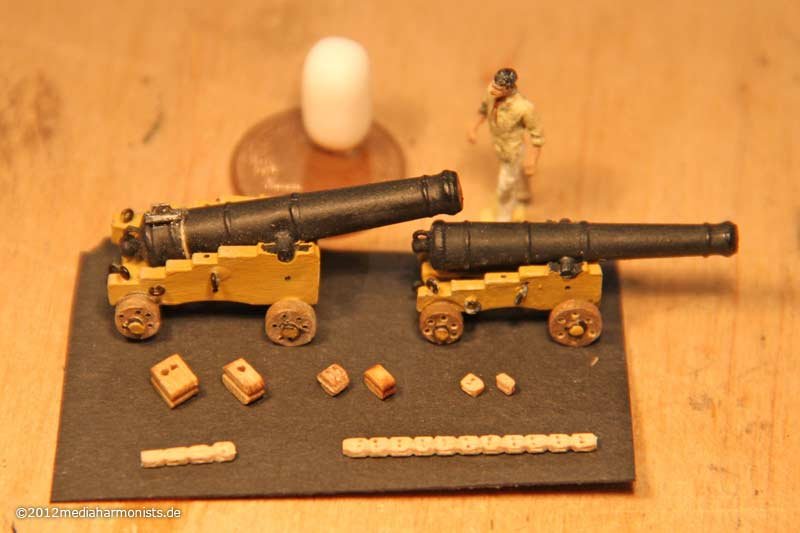 Just a family picture: the Krick 3 mm, the JB 2 mm and Microline from dafi, and as it looks nice a macro shot.
Just a family picture: the Krick 3 mm, the JB 2 mm and Microline from dafi, and as it looks nice a macro shot.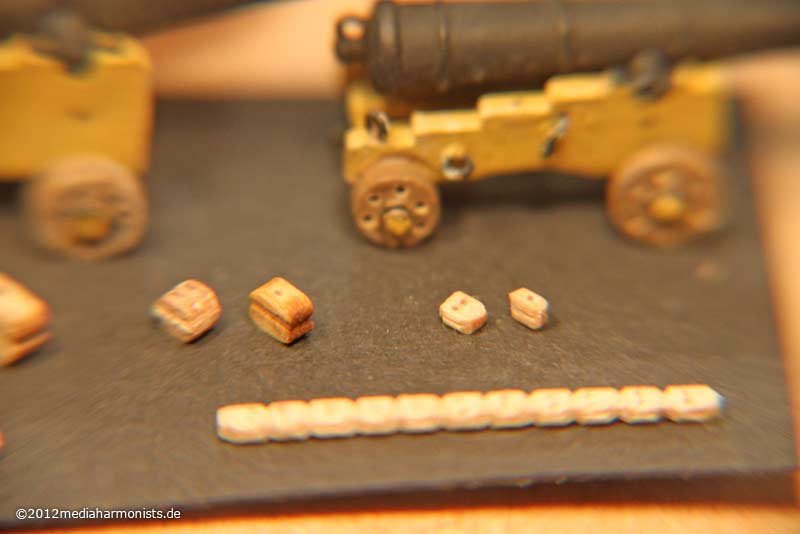 So I already see the crowd out there laughing in anticipation of the knots in dafis fingers, while trying to tying some rigging onto these littel bits ...... and this was the result with a descent rope:
So I already see the crowd out there laughing in anticipation of the knots in dafis fingers, while trying to tying some rigging onto these littel bits ...... and this was the result with a descent rope: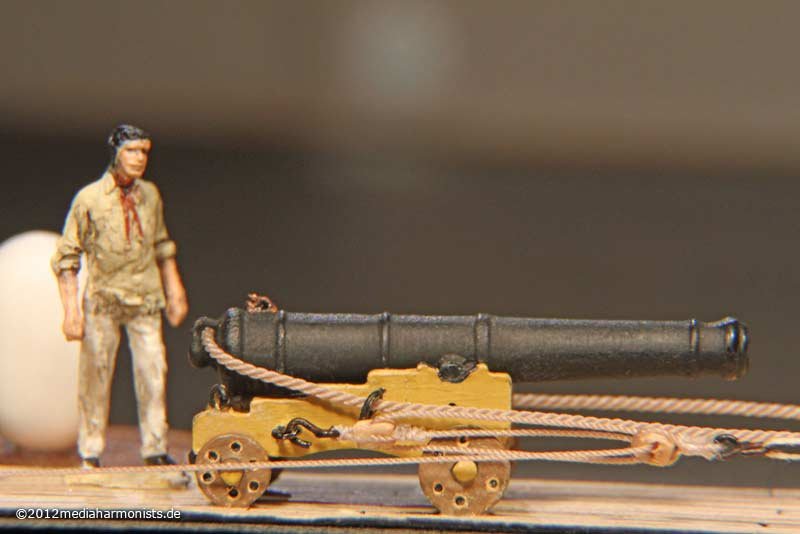 *jumpingofhappiness*Not yet perfect, but the direction is right :-)Lieber Gruß, Daniel
*jumpingofhappiness*Not yet perfect, but the direction is right :-)Lieber Gruß, Daniel
- shihawk, src, Mirabell61 and 6 others
-
 9
9
-
And now to something completely different - the strops ...First threading test ...
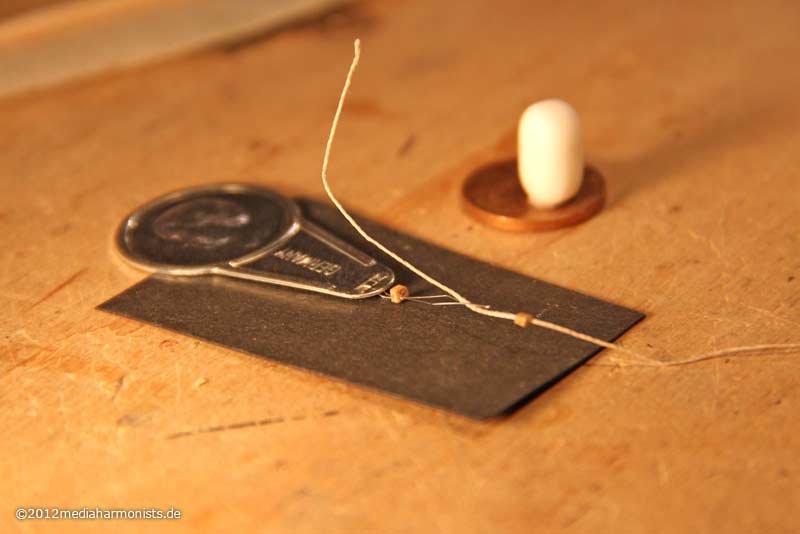 ... first had to squeeze the tip of my threading help to a smaller diameter, then pulled gently with brutal force this thickish 0,3 line through ...
... first had to squeeze the tip of my threading help to a smaller diameter, then pulled gently with brutal force this thickish 0,3 line through ... ... and test step N° 1 completed :-)More difficult is the stropping as I remember from the tiller, so taking the line out again for security reasons as some glueing will be required ...
... and test step N° 1 completed :-)More difficult is the stropping as I remember from the tiller, so taking the line out again for security reasons as some glueing will be required ... ... fix the stropping line with one drop of CA in the groove on one side, carry once around the block, fix the extra strop for the hook, prepare the loop of thin line for securing the ensemble, fix it with Uhu Plast, - good fix but can be reopened if necessary - position the knots and ends properly, fix for good with CA, and once more I do a good cut :-)And then with good hope and high expectations back to the scene of crime ...
... fix the stropping line with one drop of CA in the groove on one side, carry once around the block, fix the extra strop for the hook, prepare the loop of thin line for securing the ensemble, fix it with Uhu Plast, - good fix but can be reopened if necessary - position the knots and ends properly, fix for good with CA, and once more I do a good cut :-)And then with good hope and high expectations back to the scene of crime ...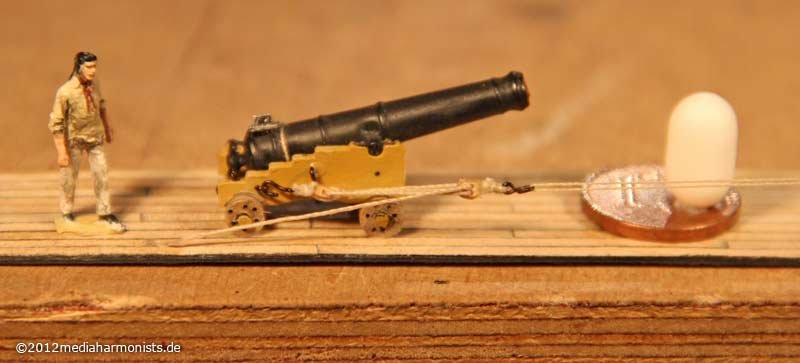 ... and not tooo bad - and there are really two separate holes in the 1,5 mm block :-)
... and not tooo bad - and there are really two separate holes in the 1,5 mm block :-)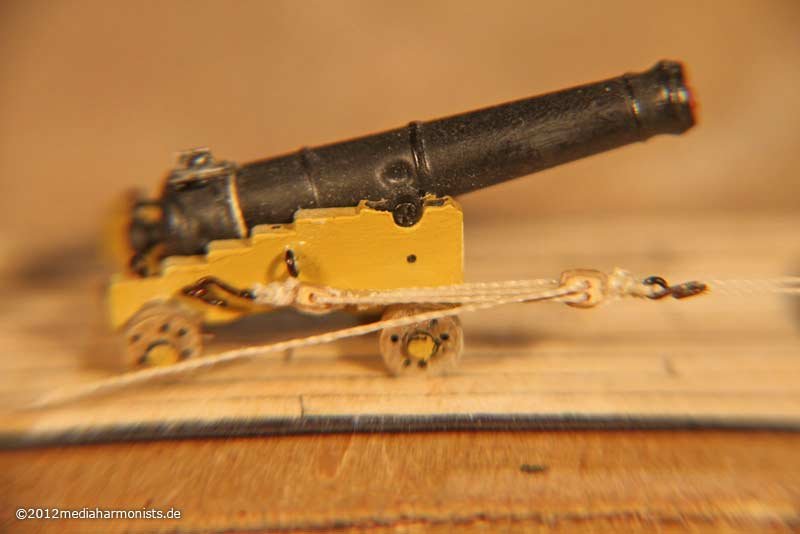 Okokok, the back hook still is too long, the line a packet string and the splices worth 24 with the cat´o´24-tails ...... but the direction is right :-)Disclaimer 1: This was a test, I wont do thaaaaaat for the lower deck guns ;-)Disclaimer 2: I took a barrel with a sinking mark to remind you of the provenience of this model ...;-)Lieber Gruß, Daniel
Okokok, the back hook still is too long, the line a packet string and the splices worth 24 with the cat´o´24-tails ...... but the direction is right :-)Disclaimer 1: This was a test, I wont do thaaaaaat for the lower deck guns ;-)Disclaimer 2: I took a barrel with a sinking mark to remind you of the provenience of this model ...;-)Lieber Gruß, Daniel
-
And some more basic work. To do the side takles I need small blocks. The smallest commercially available are the 2 mm from JB, great stuff but still a little bit to big for ma taste. So I wanted to see what there is still possible :-)Literature shows several ways of doing blocks, most of them done in a similar way, so I am following that, just have to take out most of the machinery because of the size.First I prepared a batten of 1,5 mm high and 1 mm thick, and marked it all 2 mm which gave the basic size of these ambitious project ...
 ... each of these marks got a diagonal cut in one direction and after all done, the batten was turned and the other side cut, so the grooves on one side were finished. Repeated on all four sides ...
... each of these marks got a diagonal cut in one direction and after all done, the batten was turned and the other side cut, so the grooves on one side were finished. Repeated on all four sides ... ... and this was achieved rather fast, some matt varnish to strengthen the edges ...
... and this was achieved rather fast, some matt varnish to strengthen the edges ... ... and first drilling tests ...
... and first drilling tests ... ... with the 0,5er drill. Result, difficult to get the right place, so more testing until it looked like in a swiss cheese factory ...
... with the 0,5er drill. Result, difficult to get the right place, so more testing until it looked like in a swiss cheese factory ... ... and finally the enlightenment: drill fixed in the stand, a stop in 0,5 mm distance is fixed. The stop has the width of 2 mm which facilitates positioning.Now hold the batten tight and near at both sides and slide it up the stop until drilled ...
... and finally the enlightenment: drill fixed in the stand, a stop in 0,5 mm distance is fixed. The stop has the width of 2 mm which facilitates positioning.Now hold the batten tight and near at both sides and slide it up the stop until drilled ... ... move down and turn the batten 180° around the longitudinal axis, slide up and drill the second hole :-)(I spared you the fingers on the picture :-)Looks already ok, the four blocks left of my little worker are the single blocks of 1 mm x 1 mm x 2 mm - hihihihihi - ...
... move down and turn the batten 180° around the longitudinal axis, slide up and drill the second hole :-)(I spared you the fingers on the picture :-)Looks already ok, the four blocks left of my little worker are the single blocks of 1 mm x 1 mm x 2 mm - hihihihihi - ... ... a second coat of varnish, the cutter makes the groove on the side for the line - the most difficult part on the whole action - some sanding off of the edges, some more varnish and done. They stay on the batten and will be cut just prior to production for not getting lost - just in time production :-)
... a second coat of varnish, the cutter makes the groove on the side for the line - the most difficult part on the whole action - some sanding off of the edges, some more varnish and done. They stay on the batten and will be cut just prior to production for not getting lost - just in time production :-) Just a family picture: the Krick 3 mm, the JB 2 mm and Microline from dafi, and as it looks nice a macro shot.
Just a family picture: the Krick 3 mm, the JB 2 mm and Microline from dafi, and as it looks nice a macro shot. So I already see the crowd out there laughing in anticipation of the knots in dafis fingers, while trying to tying some rigging onto these littel bits ...Stay tuned, Daniel
So I already see the crowd out there laughing in anticipation of the knots in dafis fingers, while trying to tying some rigging onto these littel bits ...Stay tuned, Daniel -
Holy impatience ...... still not happy with the self made lines ...... the thick ones no problem, the thin ones are a drag ...... but big want to continue. The best result was a 0,3 mm Krick-line, that I unraveled and laid from new :-)But first came sorting the rings ...
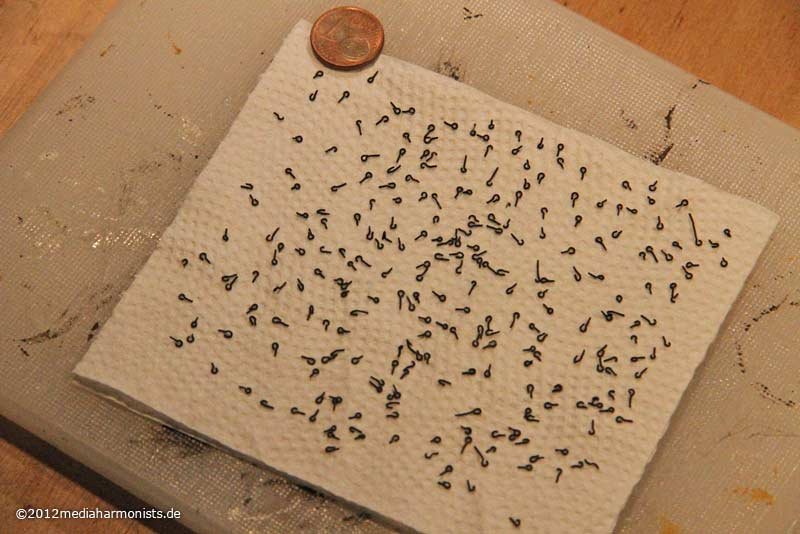 ... by size and form, served hot on tape ...
... by size and form, served hot on tape ...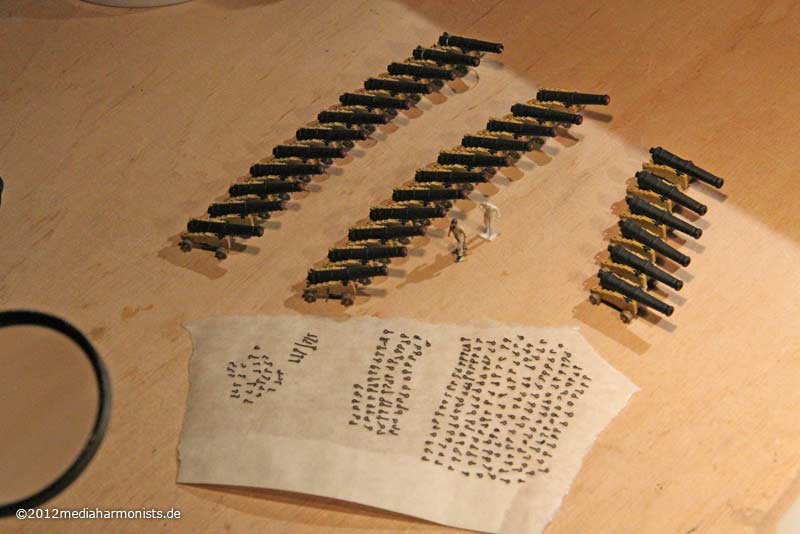 ... and fixed on the lower deck guns. Then came the lead aprons for the gun locks ...
... and fixed on the lower deck guns. Then came the lead aprons for the gun locks ...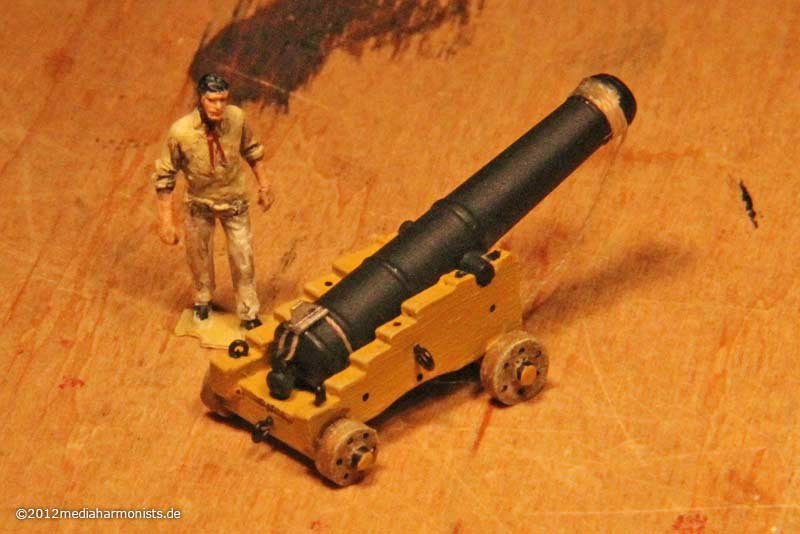 ... the line for the tompions and some turns around the muzzle.
... the line for the tompions and some turns around the muzzle.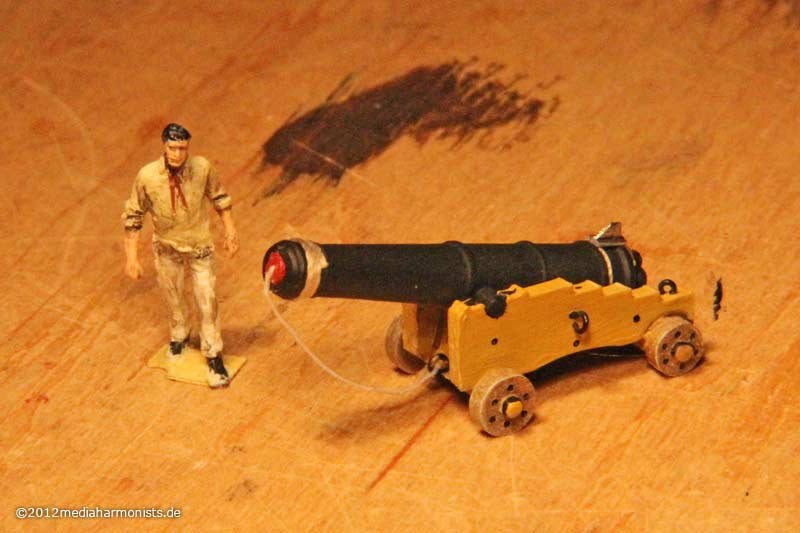 As I had to preassemble the gun outside, the task was that all the lengths for the rig are different due to the tumbledome and the different breadth of the deck.First fixing a template ...
As I had to preassemble the gun outside, the task was that all the lengths for the rig are different due to the tumbledome and the different breadth of the deck.First fixing a template ...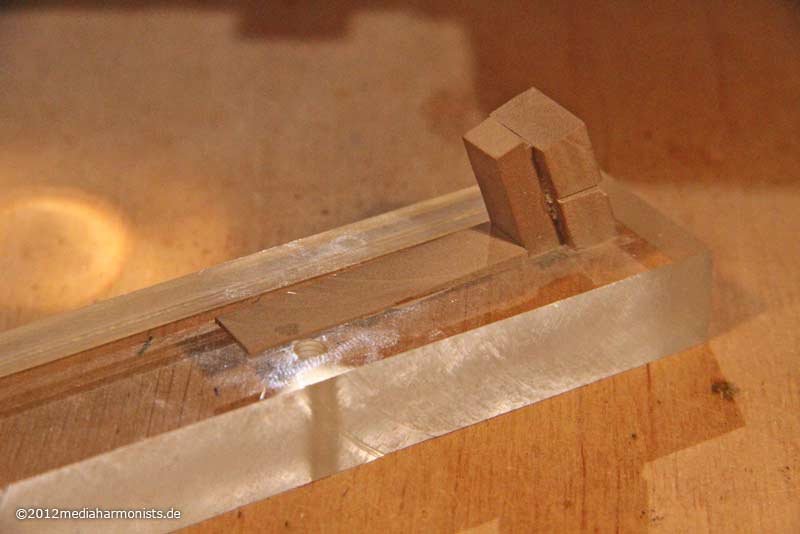 ... and it fits :-)
... and it fits :-)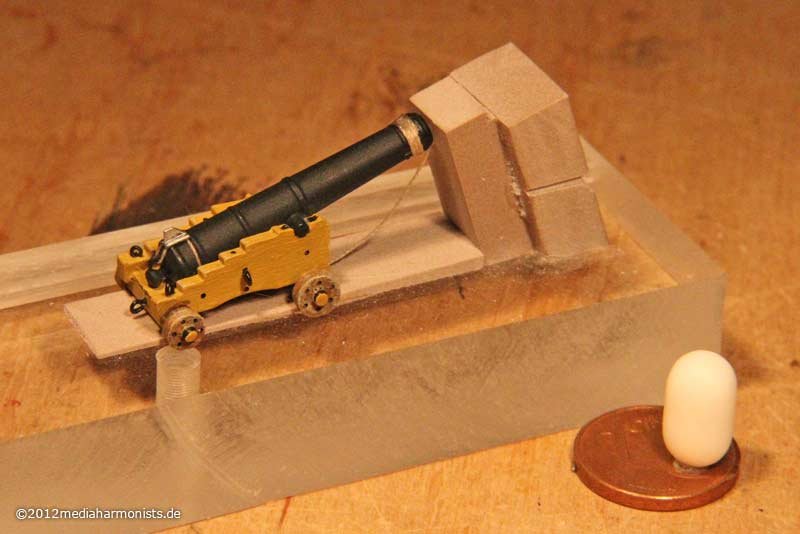 Now some bondage - I like making some guns happy ;-)First the breechline around the bum, fixing with CA ...
Now some bondage - I like making some guns happy ;-)First the breechline around the bum, fixing with CA ...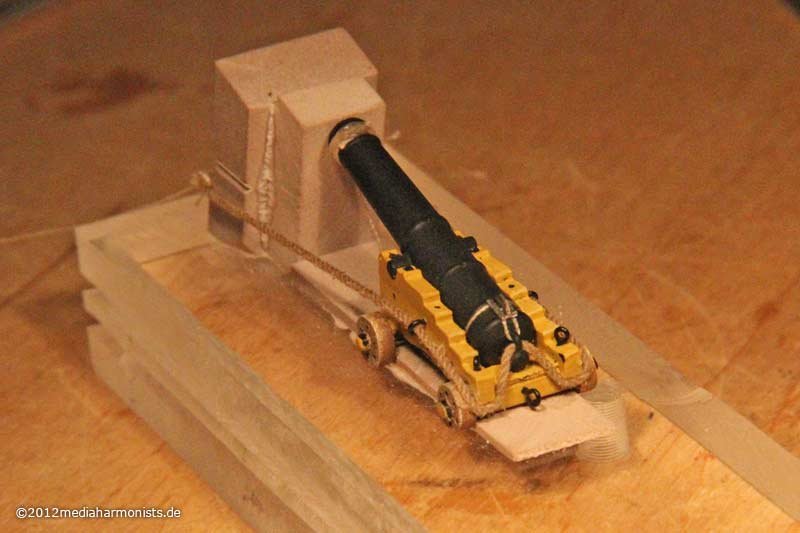 ... knotted in the front, the groove on the side helps as a guide for the height ...
... knotted in the front, the groove on the side helps as a guide for the height ...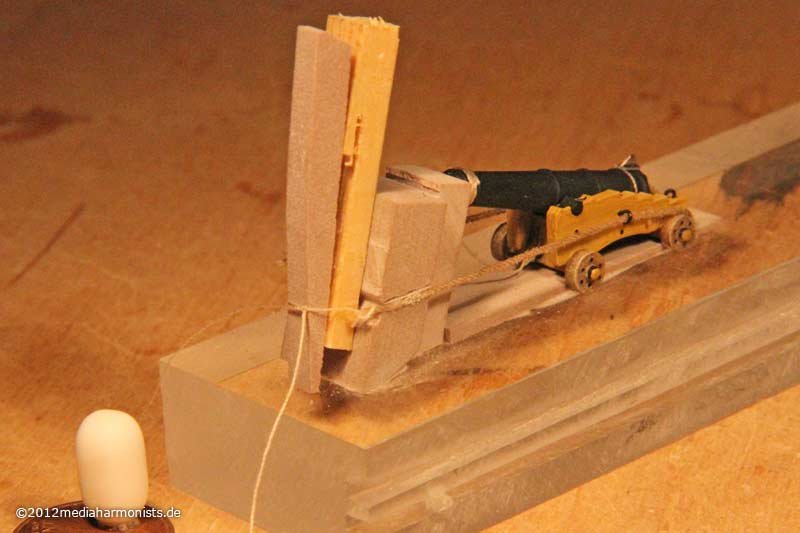 ... and two wedges to make it tight. Then flooded the breechline with CA and phase 1 done :-)Phase 2 some more bondage, a shortened needle is a good help ...
... and two wedges to make it tight. Then flooded the breechline with CA and phase 1 done :-)Phase 2 some more bondage, a shortened needle is a good help ...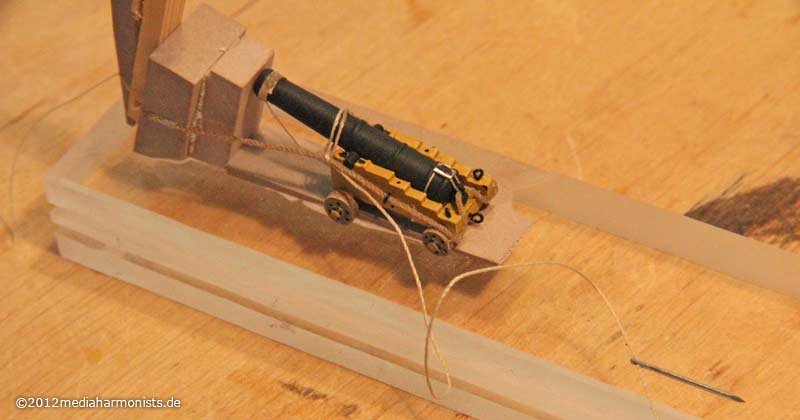 ... and well bound and done too.
... and well bound and done too.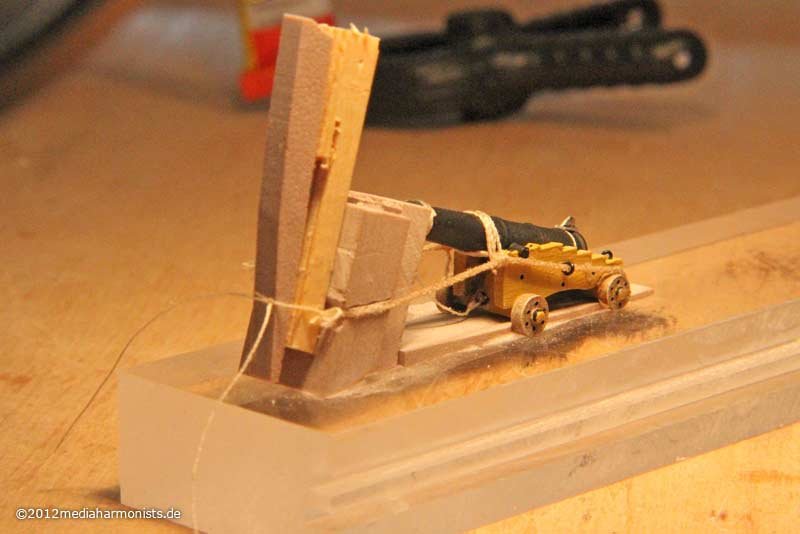 Then still fixed a gauge for the upper lashing ...
Then still fixed a gauge for the upper lashing ...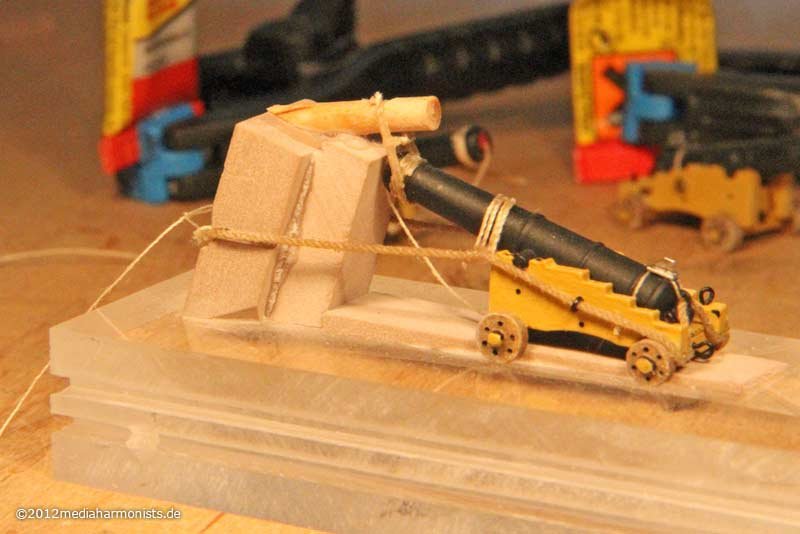 ... some CA-flooding and phase 3 done too :-)After freeing the whole thing it stands nicely there ...
... some CA-flooding and phase 3 done too :-)After freeing the whole thing it stands nicely there ...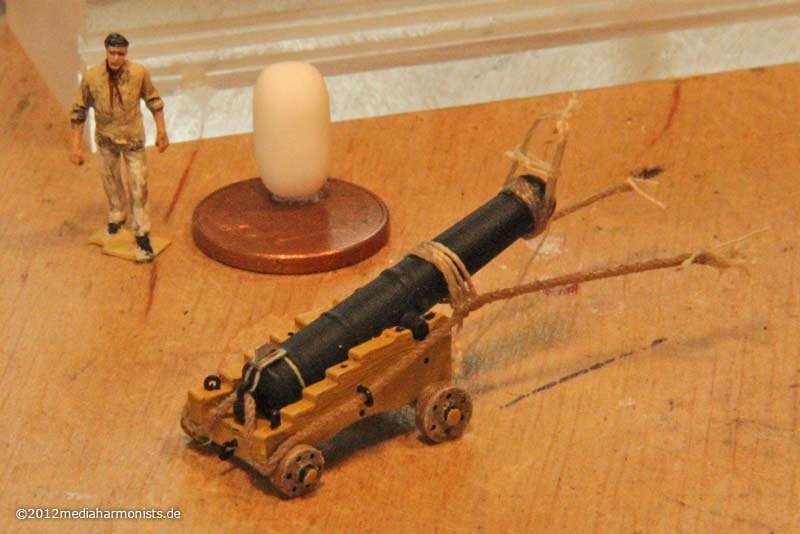 ... held to its final place and shortened the over lenghts. Fixed some rings as they might be seen by the open gunports.
... held to its final place and shortened the over lenghts. Fixed some rings as they might be seen by the open gunports.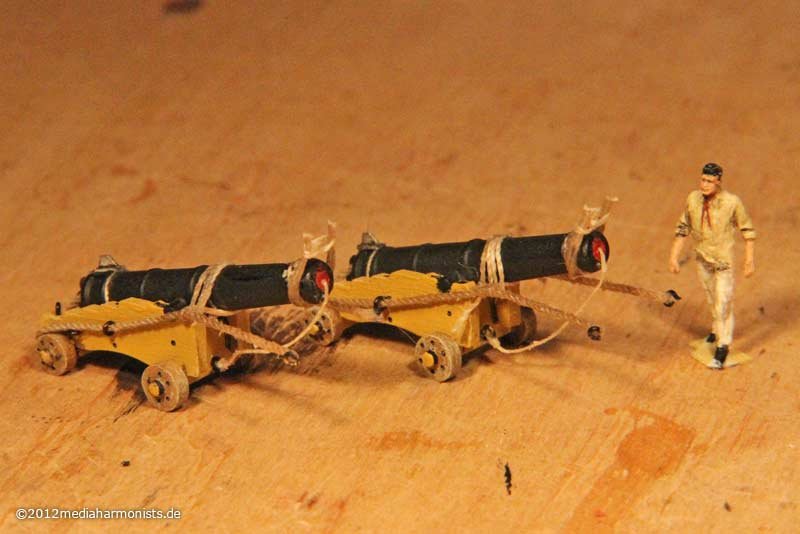
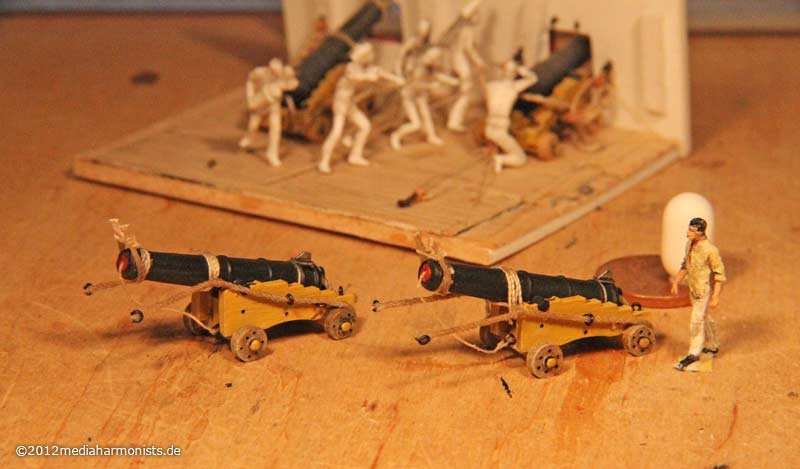 And finalemente the whole in place. That is what I was looking for.
And finalemente the whole in place. That is what I was looking for.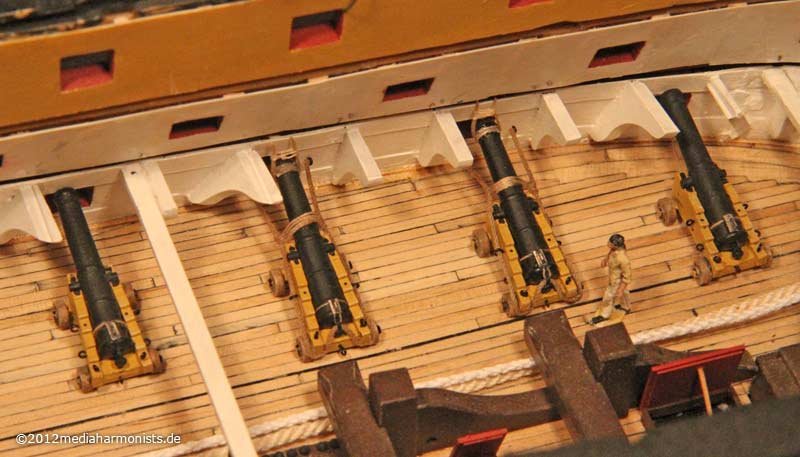 Small check from the outside:
Small check from the outside: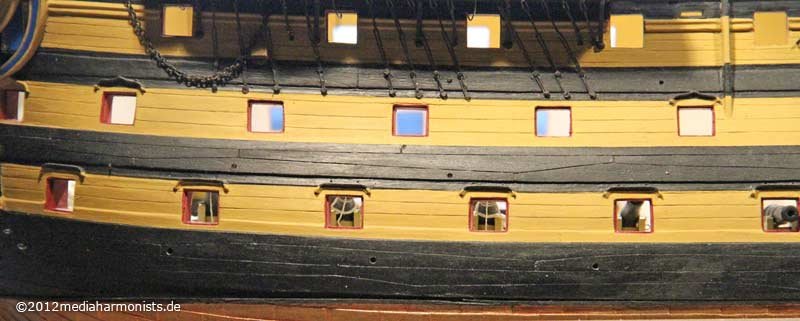 The side takles will still be set, but this will be the next story :-)Lieber Gruß, Daniel
The side takles will still be set, but this will be the next story :-)Lieber Gruß, Daniel -
Hello Michiel,
it is always warned about lead corrosion. The lead can disintegrate into white powder. Museums usually refuse taking models with this material because of that reason. I saw some nice effects already in the different forums about this issue.
In the MSW.1 there was an article about it. Can anybody reproduce this one and start as a new topic?
Daniel
-
Nothing exaggeratingly new, business as usual ...... main mast done, together with the oob-version ...
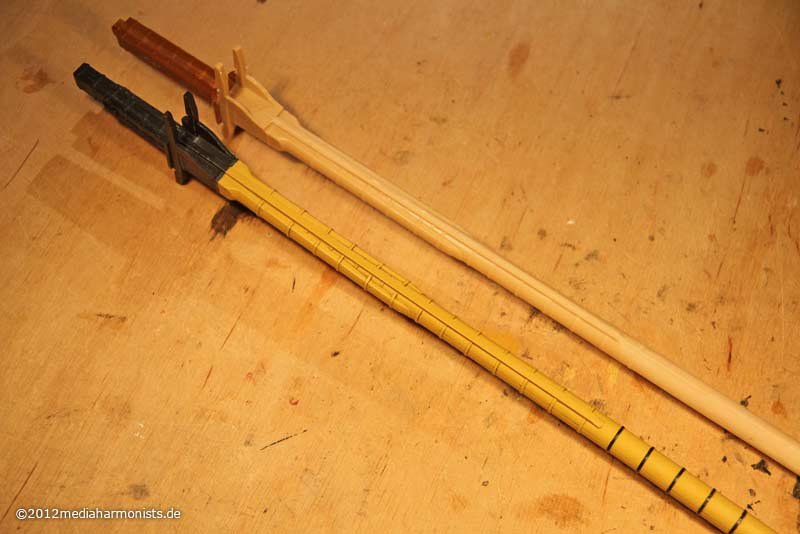
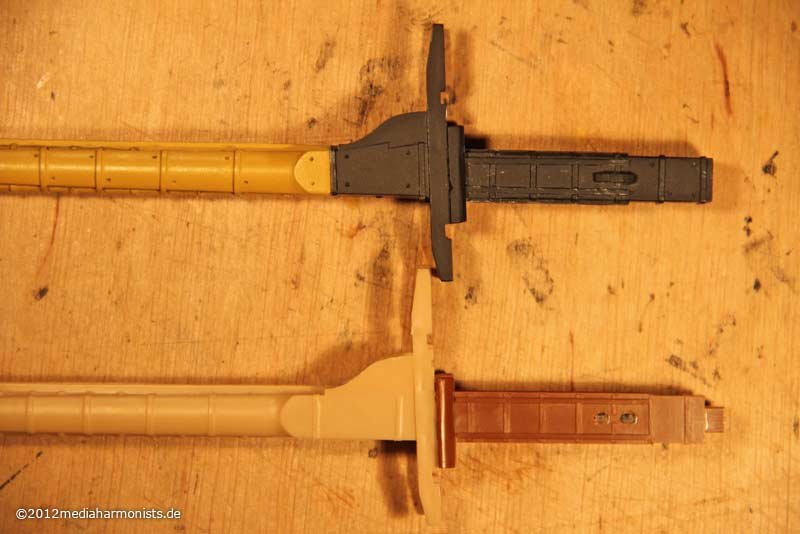
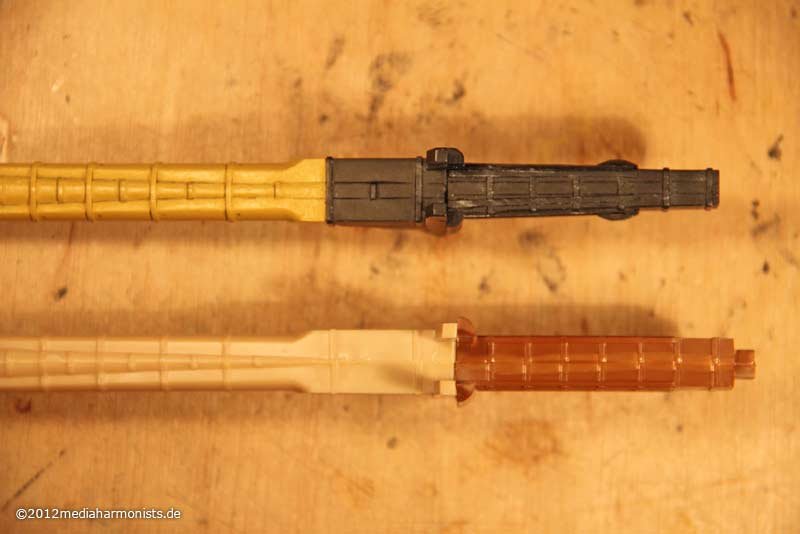
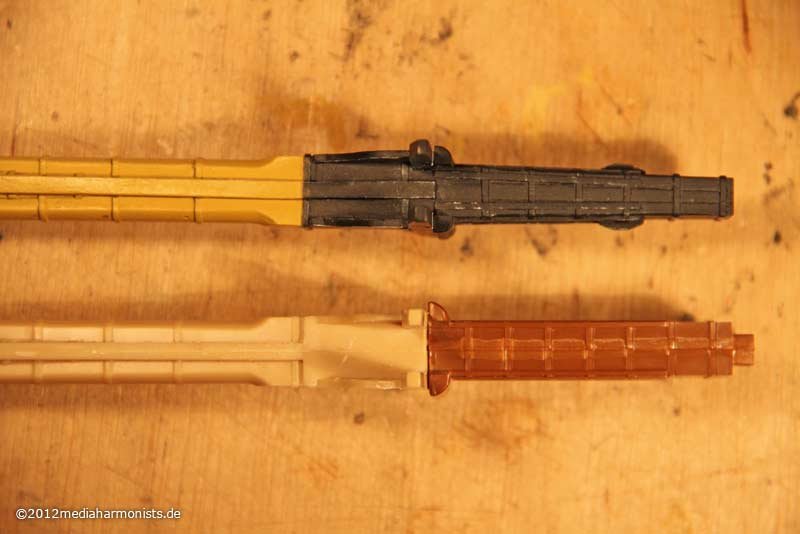 ... and the mizzen got his split lines.
... and the mizzen got his split lines.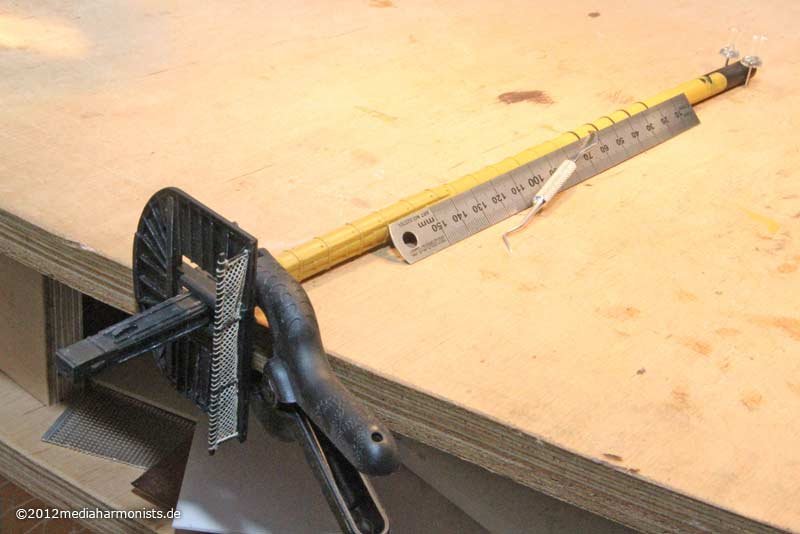 Happy rest-eastern, Daniel
Happy rest-eastern, Daniel -
I was looking at the pictures above. They looked great, but something was disturbing. I was looking at the pictures in of the V. in P. ...... they looked the same....... until I asked myself, why do I display steel masts?!?What makes the visible difference in this scale in between a painted steel and painted wooden masts? The wooden ones are made up of four parts around a core, showing the splitlines :-)Ok, operation on the open heart, means on the finished painted mizzen mast ...
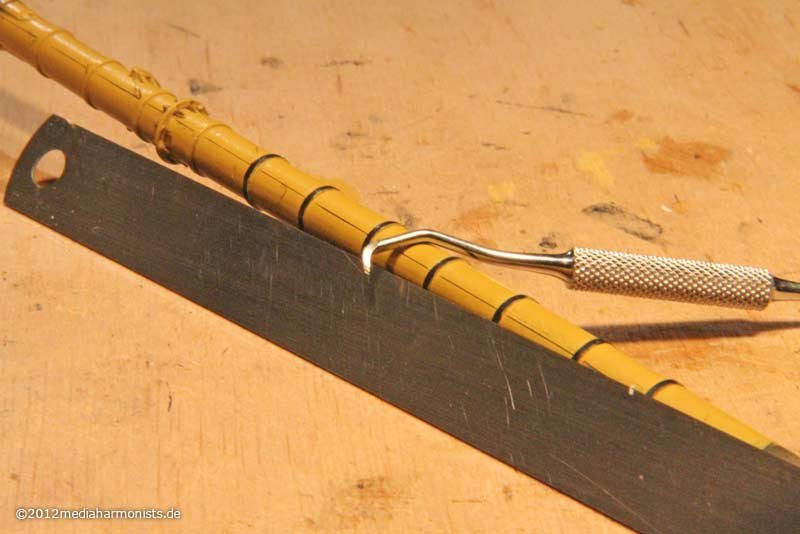 ... carving the split lines, restoring the paint and the inking and retaking the pictures :-)
... carving the split lines, restoring the paint and the inking and retaking the pictures :-)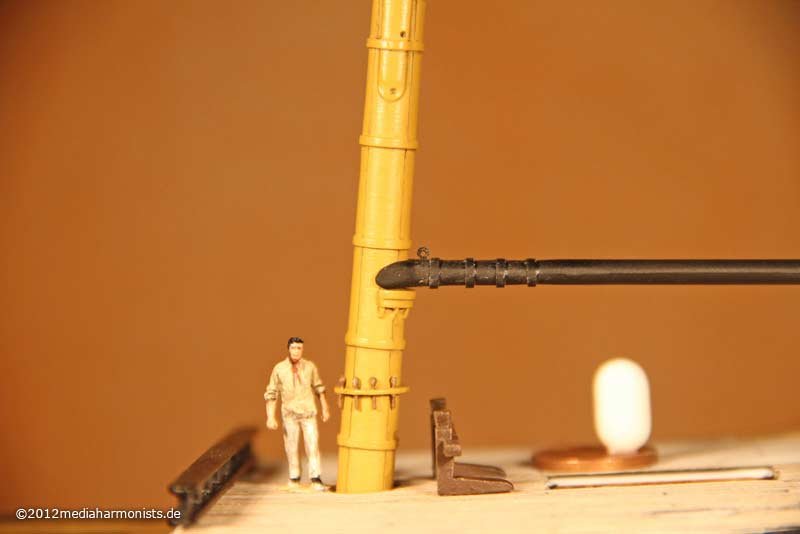
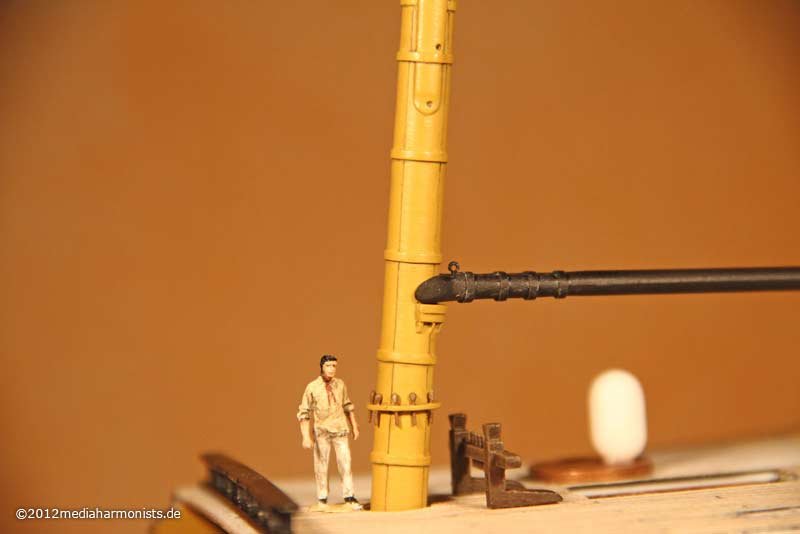 Much more what my heart desired!So this was the open heart surgery, soon there will be the brain surgery on the fore mast with the top already fixed, that will be fun too ;-)And by the way, Dave at MSW realised, that I fixed the boom the wrong side up on the saddle ...... already fixed too.All the best, Daniel
Much more what my heart desired!So this was the open heart surgery, soon there will be the brain surgery on the fore mast with the top already fixed, that will be fun too ;-)And by the way, Dave at MSW realised, that I fixed the boom the wrong side up on the saddle ...... already fixed too.All the best, Daniel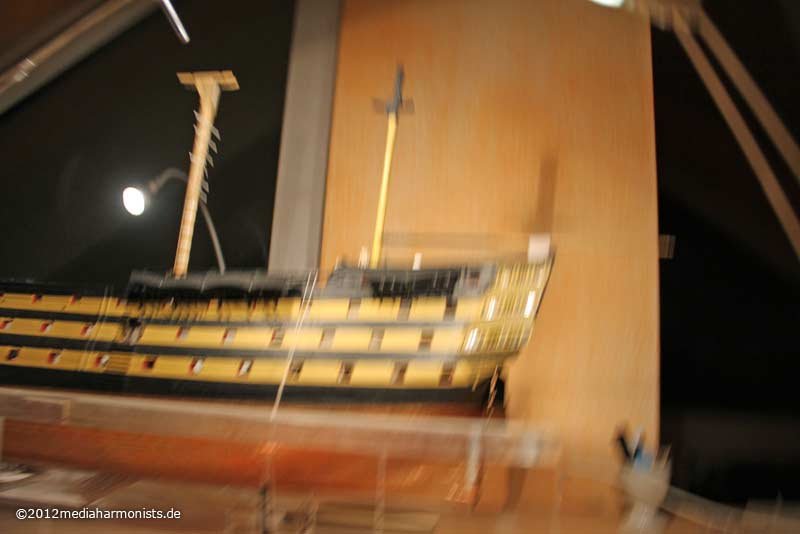
-
As usual it started with making a small pile of rubbish ...
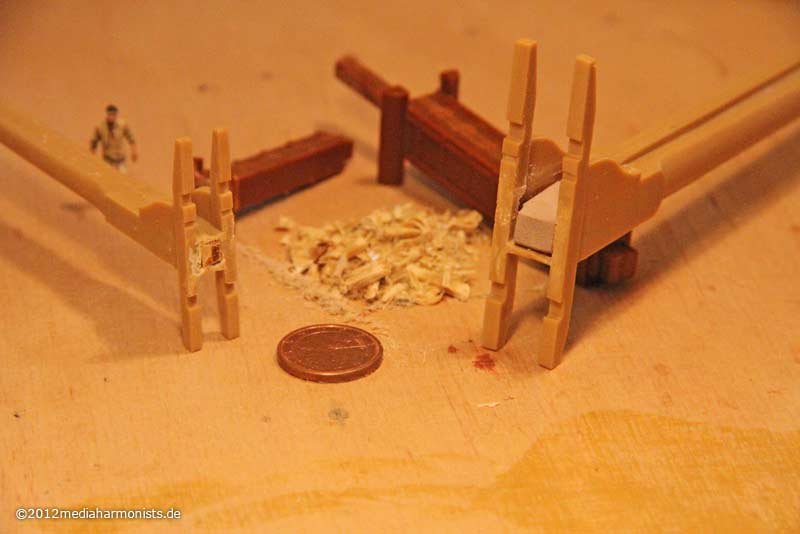 ... than marking the positions for the new mast hoops on the now naked masts, fixing the start and bending round with some hair clamps.
... than marking the positions for the new mast hoops on the now naked masts, fixing the start and bending round with some hair clamps.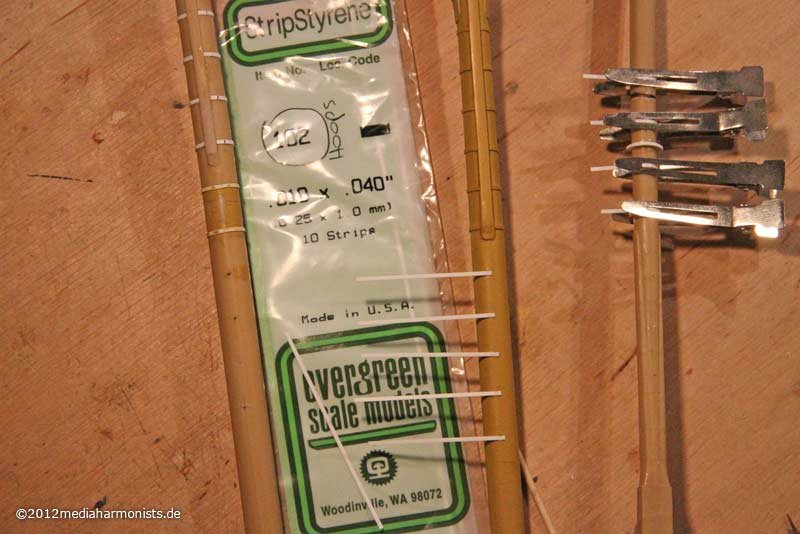 .Small quizz: whats that:
.Small quizz: whats that: Gettit?
Gettit?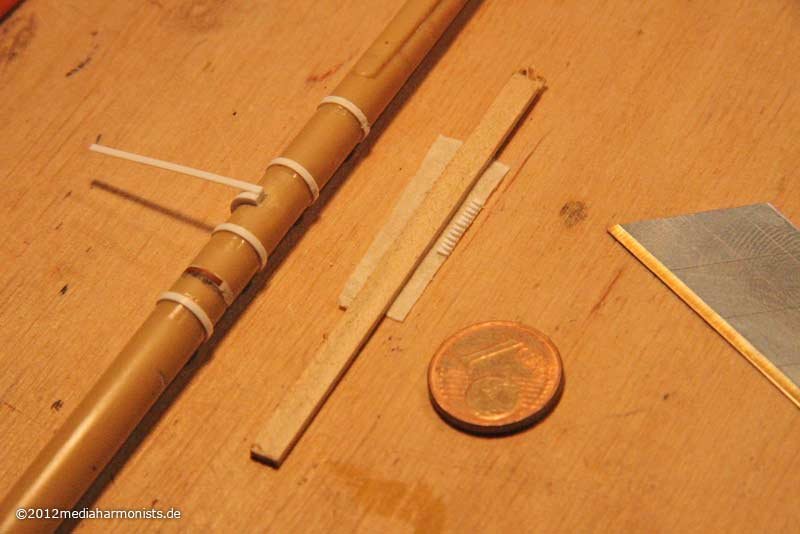 The supports of the boom´s saddle.
The supports of the boom´s saddle.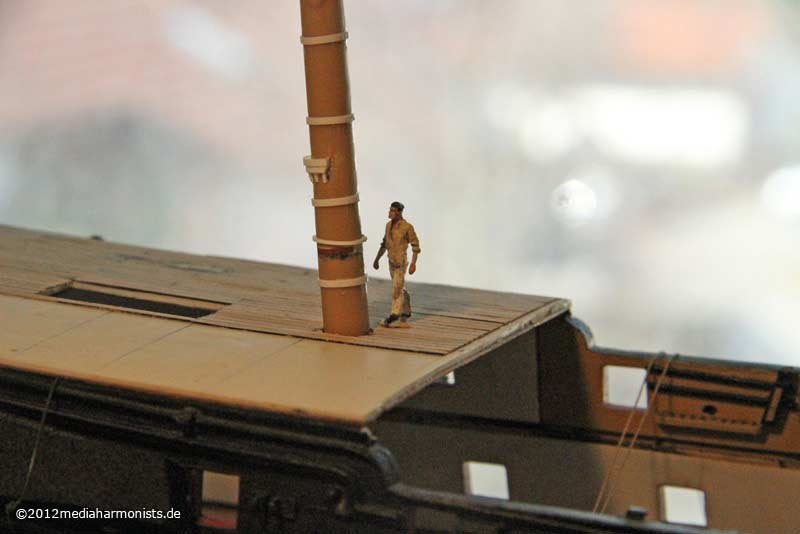 Also renewed the ring for the belay pins and brought it into a horizontal orientation and checked the height with the old trial poop deck.Refined the edges and corners of the cheecks, hounds and fishes ...
Also renewed the ring for the belay pins and brought it into a horizontal orientation and checked the height with the old trial poop deck.Refined the edges and corners of the cheecks, hounds and fishes ...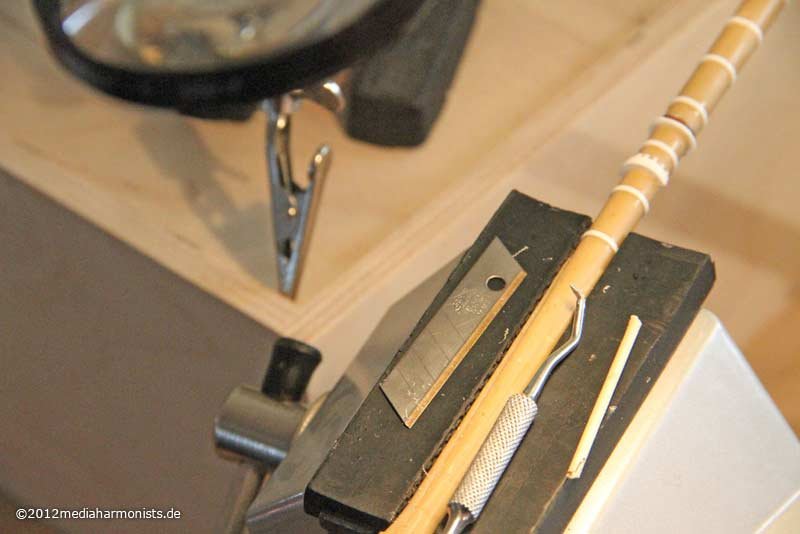 ...painted, inked and highlighted as usual, and the mizzen mast was done, here compared to the fore.
...painted, inked and highlighted as usual, and the mizzen mast was done, here compared to the fore.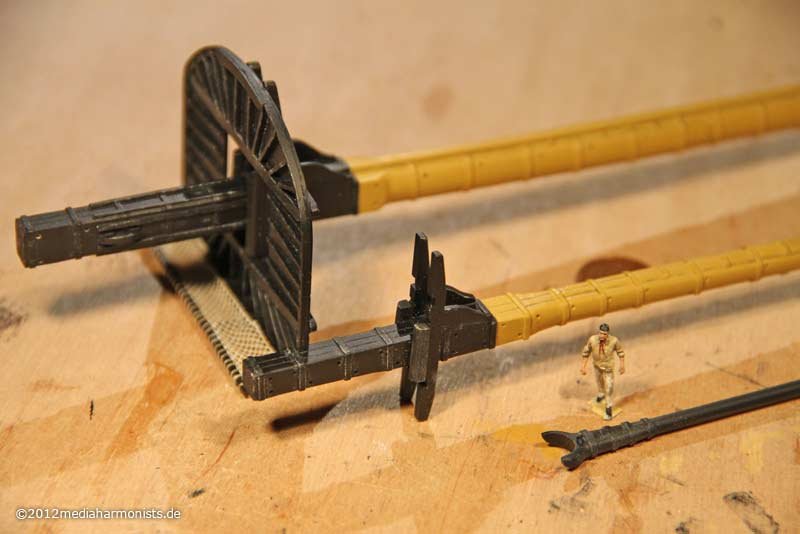 One can nicely see the more ladylike proportions, the different angle of the testle trees, the missing rubbing fish in the front and the missing of tapering and rubbing battens on the all new top.
One can nicely see the more ladylike proportions, the different angle of the testle trees, the missing rubbing fish in the front and the missing of tapering and rubbing battens on the all new top.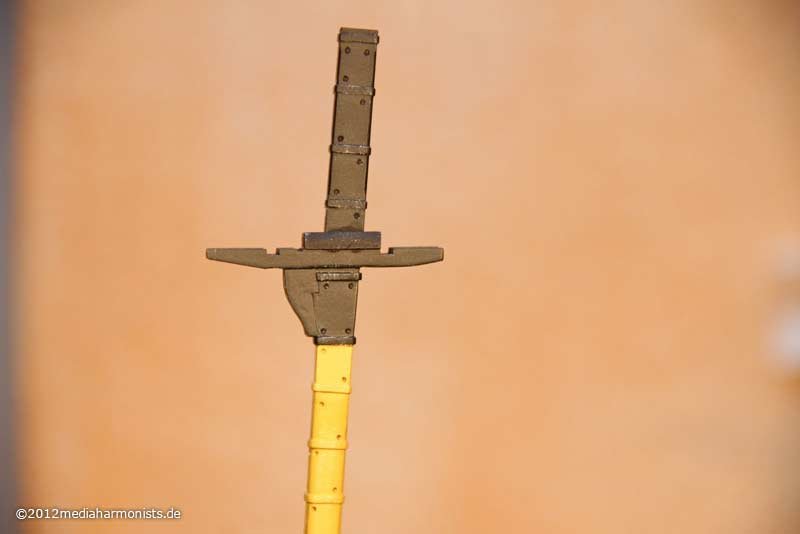
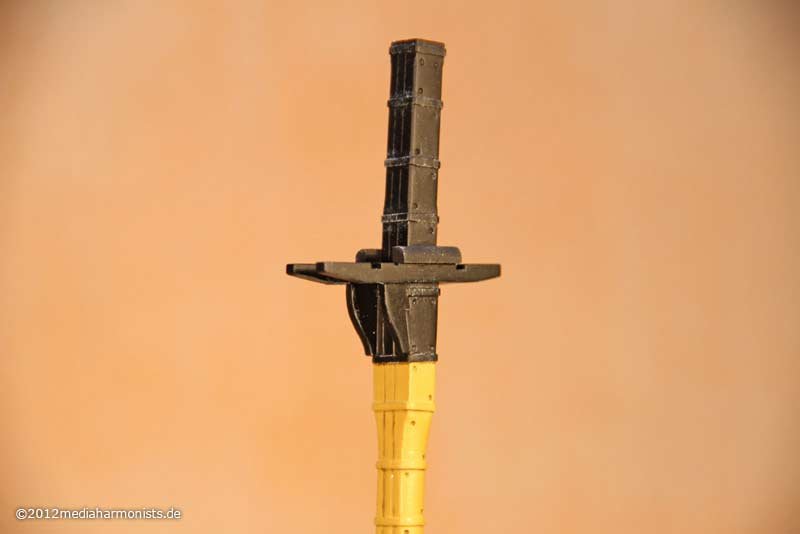 And also this joke I could not resist: Usually the masthoops were painted black as a standard. Nelson gave order to repaint them in buff according the rest of the masts for recognition reasons. But as the painters were lazy - or better said economical - the hoops underneath the quarterdeck stayed black :-)
And also this joke I could not resist: Usually the masthoops were painted black as a standard. Nelson gave order to repaint them in buff according the rest of the masts for recognition reasons. But as the painters were lazy - or better said economical - the hoops underneath the quarterdeck stayed black :-)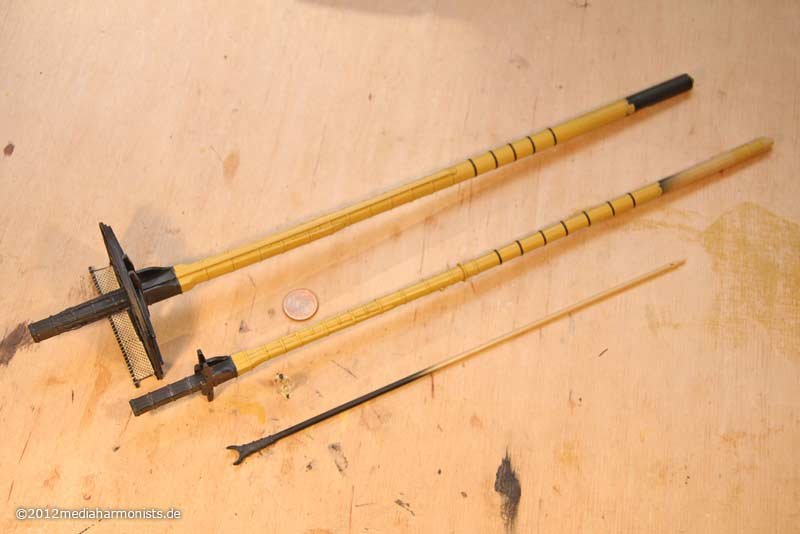 But stop, something elementary was missing, the belay pins ...Okok, making some new ones in 1:100 ...
But stop, something elementary was missing, the belay pins ...Okok, making some new ones in 1:100 ...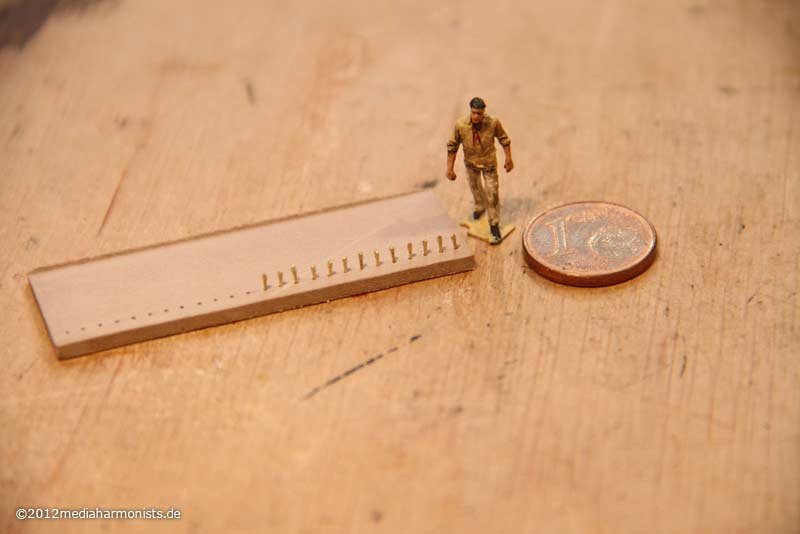 ... some wire, put in a stand, some white glue to form a drop on the top and some paint spilt over it. All exactly 4 mm long, just standing a little bit messy in the stand.
... some wire, put in a stand, some white glue to form a drop on the top and some paint spilt over it. All exactly 4 mm long, just standing a little bit messy in the stand.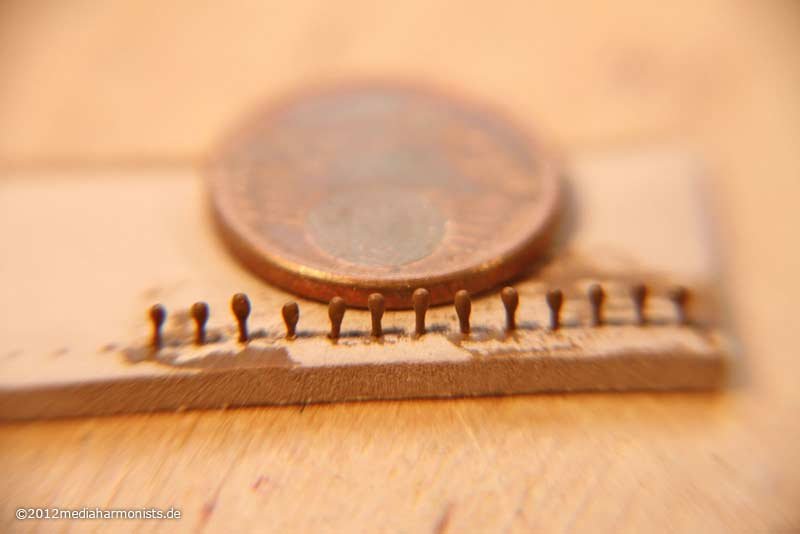 Things got stuck together - pins with rail and pins-rail-mast together with trial poop deck ...
Things got stuck together - pins with rail and pins-rail-mast together with trial poop deck ...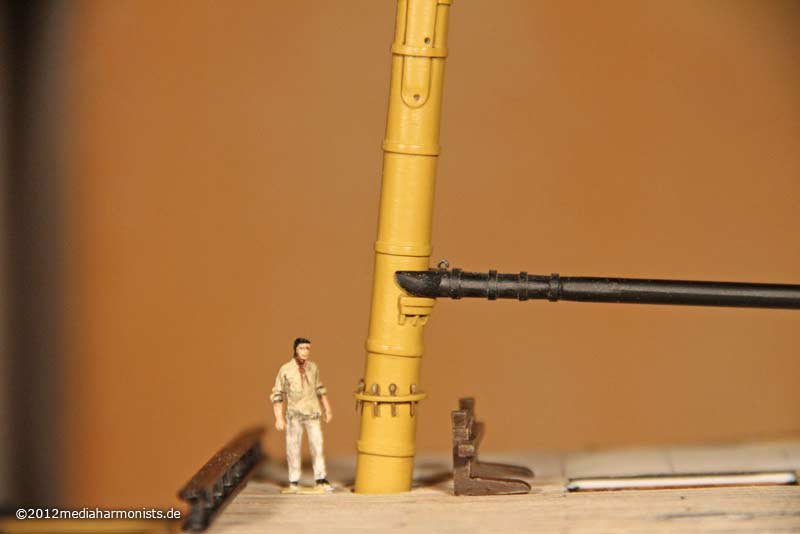 ... it goes deep down ...
... it goes deep down ...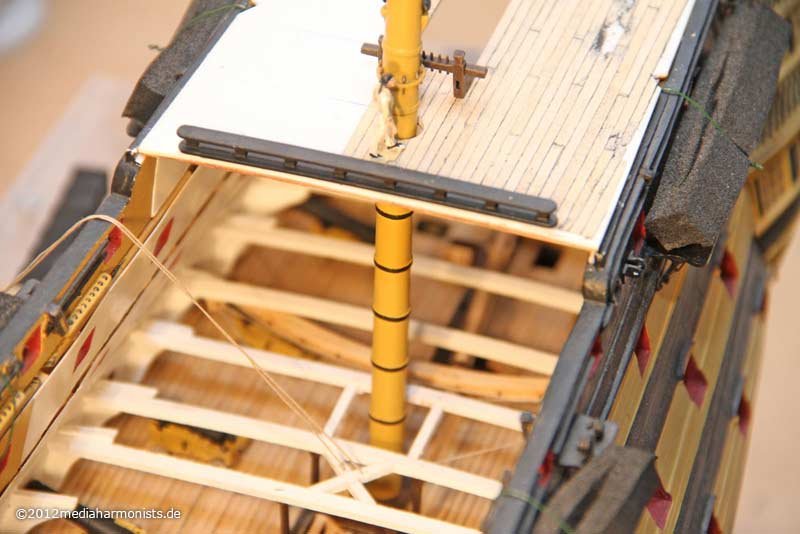 ... and much up :-)
... and much up :-)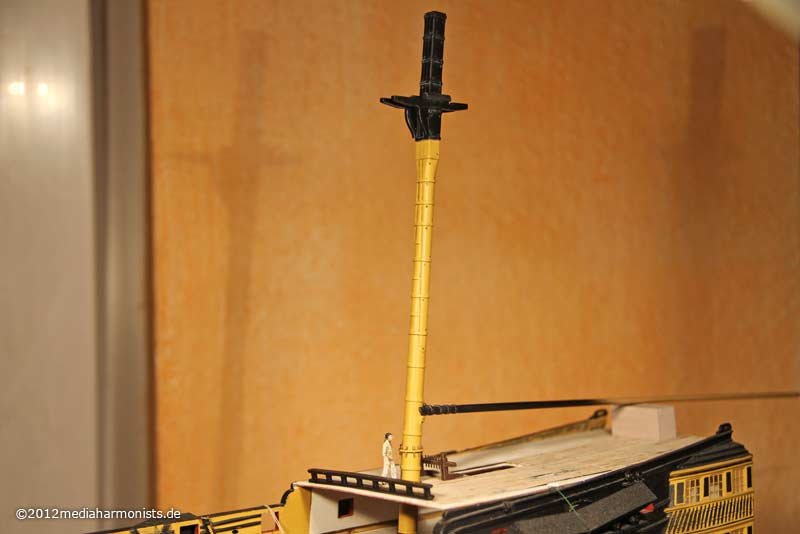 All the best, Daniel
All the best, Daniel -
Even me, even I do stupid things ...
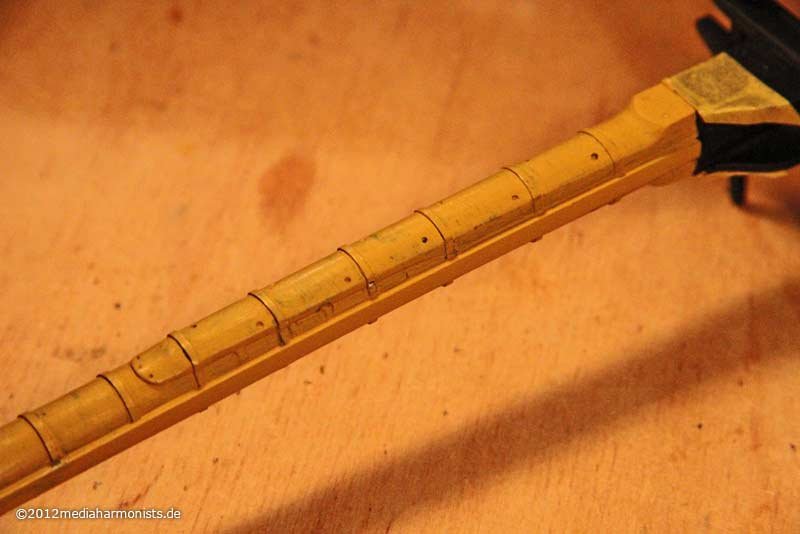 ... uneven groud, color first too thin - than too thick - then too thin, wrong brush, uneven application, airbubbles and especially too late night and hurry to go to bed ...... bad mixture ...... okokok, as a punishment and not as an excercise sanding lesson ...
... uneven groud, color first too thin - than too thick - then too thin, wrong brush, uneven application, airbubbles and especially too late night and hurry to go to bed ...... bad mixture ...... okokok, as a punishment and not as an excercise sanding lesson ...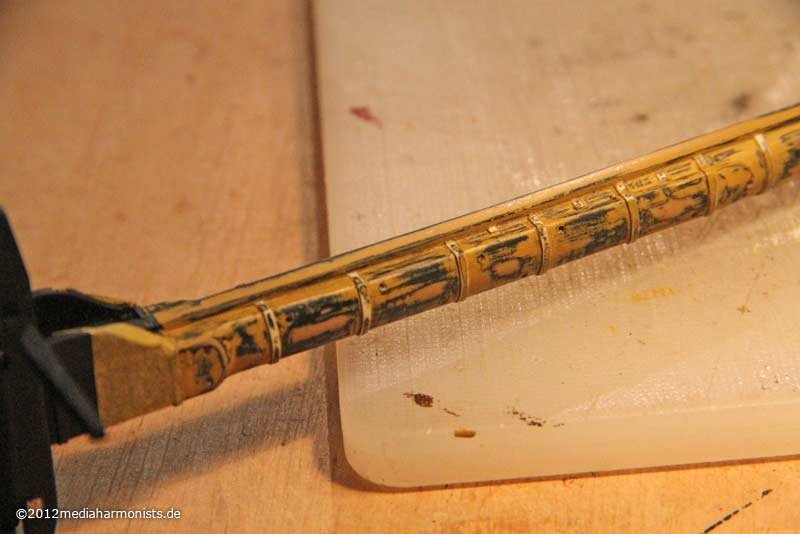 ......but next session a little bit more competent and concentrated ...... after fixing the buff, also the new top got its paint ...
......but next session a little bit more competent and concentrated ...... after fixing the buff, also the new top got its paint ...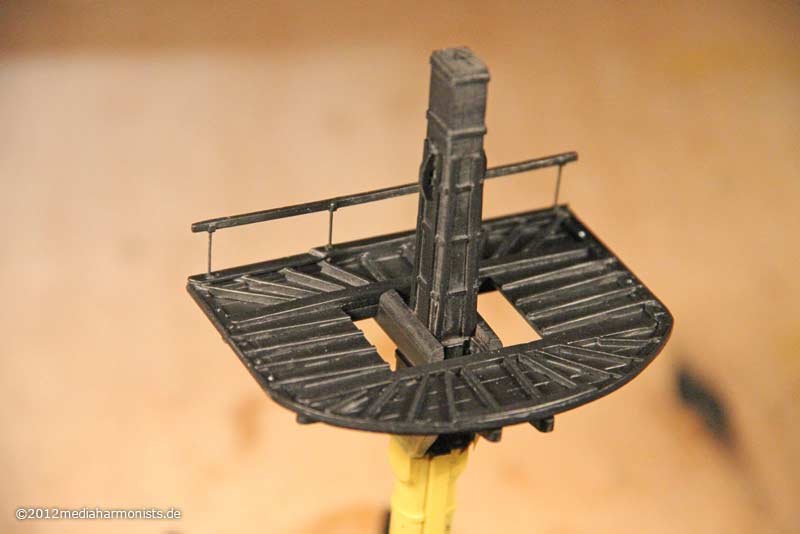 ... you can see nicely the slots underneath the gunwhale.
... you can see nicely the slots underneath the gunwhale.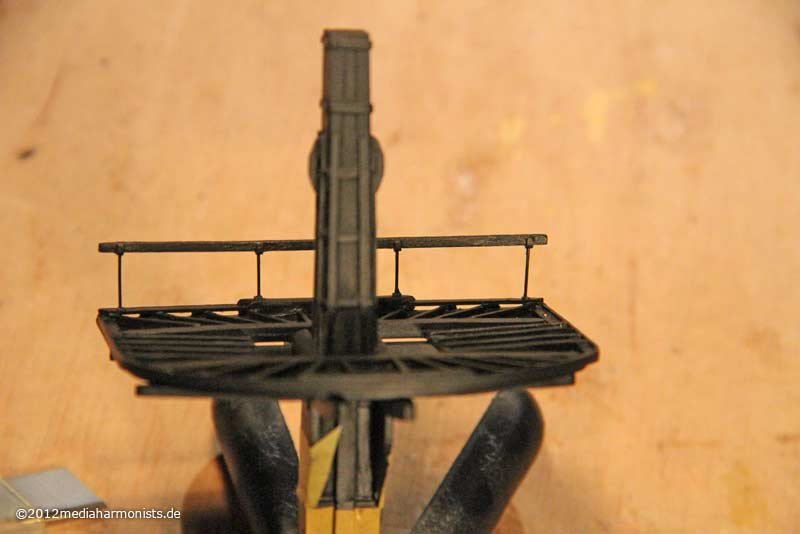 As a result of the freshly introduced quality management our little a able-bodied seaman checks the fitting of the rail ...
As a result of the freshly introduced quality management our little a able-bodied seaman checks the fitting of the rail ...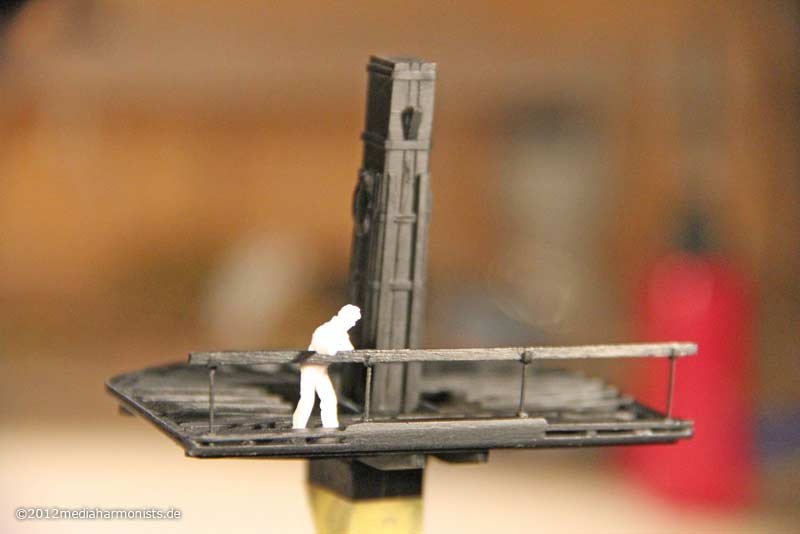 ... fixes the netting as demanded by the trade unions and insures himself about the stability of the planks of the platform..
... fixes the netting as demanded by the trade unions and insures himself about the stability of the planks of the platform..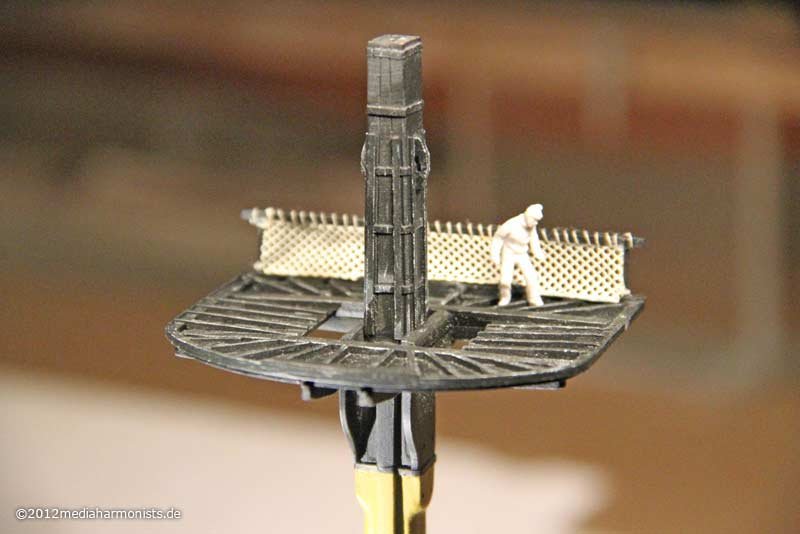 Then came my usual drybrush and incing session, looks rather strong in the macro, but with the final viewing distance of min 40 cm it looks fine, especially to articulate the details with all the rigging still to come.
Then came my usual drybrush and incing session, looks rather strong in the macro, but with the final viewing distance of min 40 cm it looks fine, especially to articulate the details with all the rigging still to come.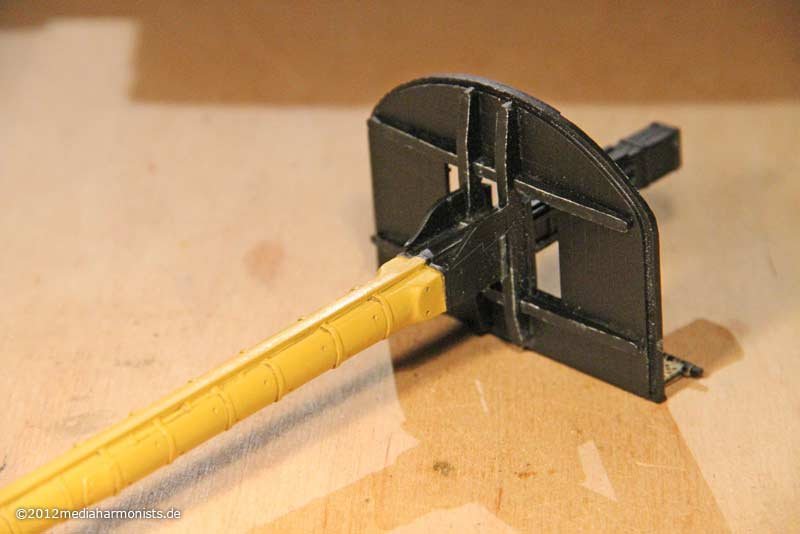
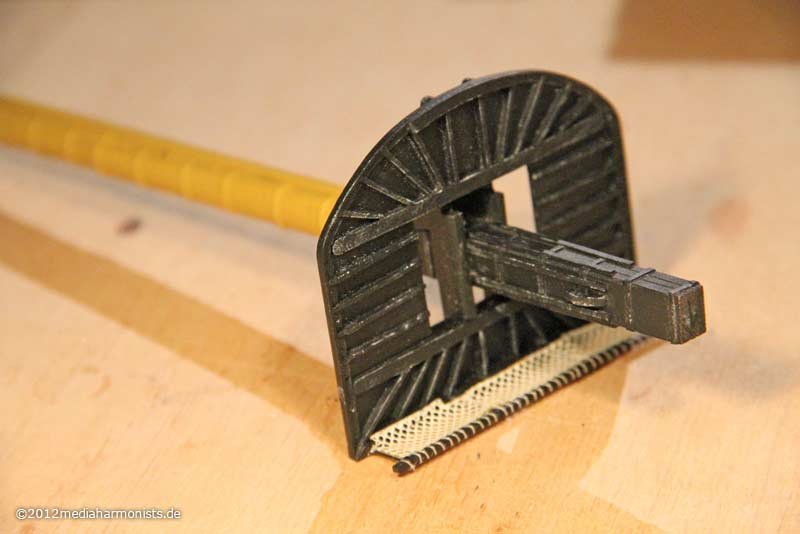
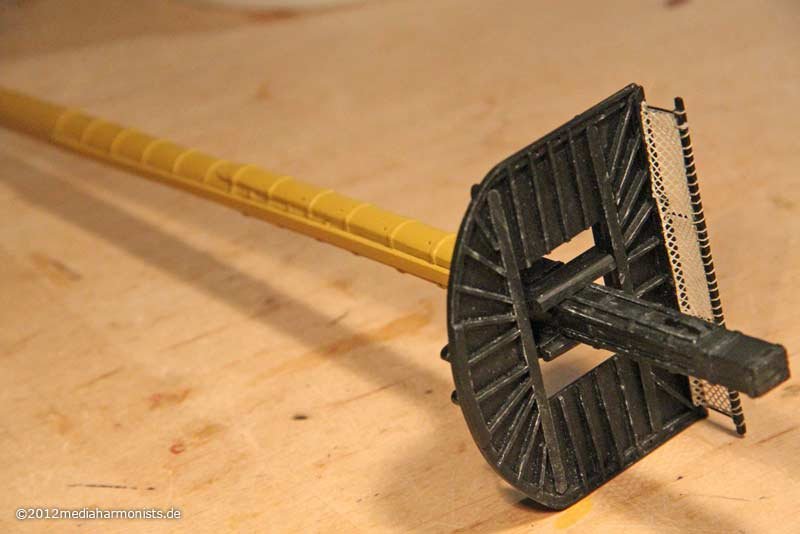
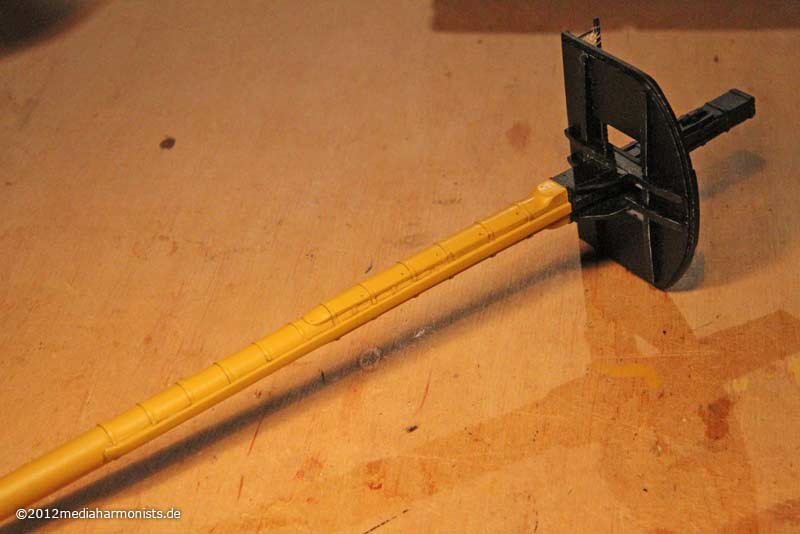
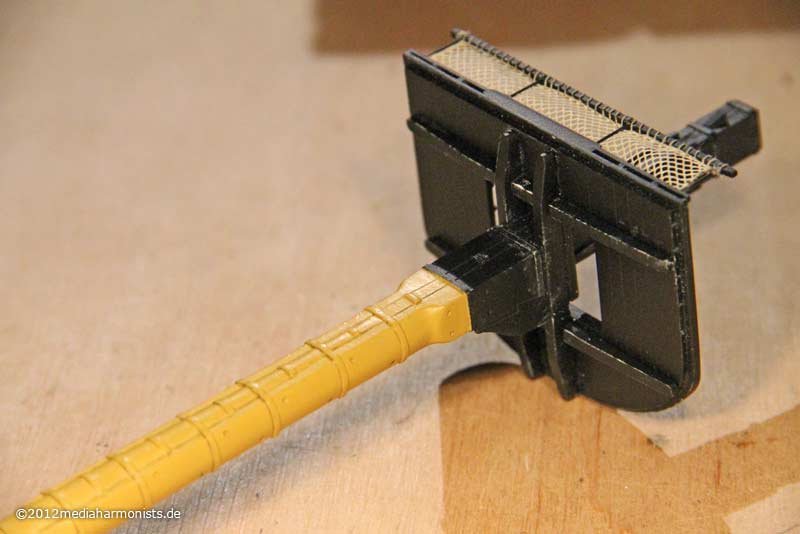
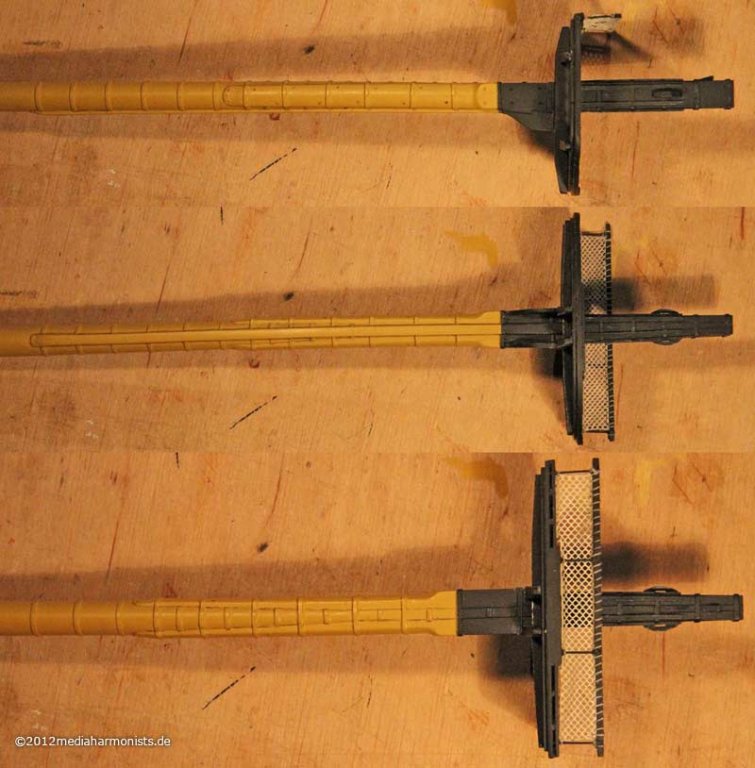 Soo dafi looking rather happy now again :-)Lieber Gruß, Daniel
Soo dafi looking rather happy now again :-)Lieber Gruß, Daniel -
After that much research I needed something easy to relax ...On the left Hellers version of the rudderwheel, right dafis version, just enjoy, no further explanations :-)
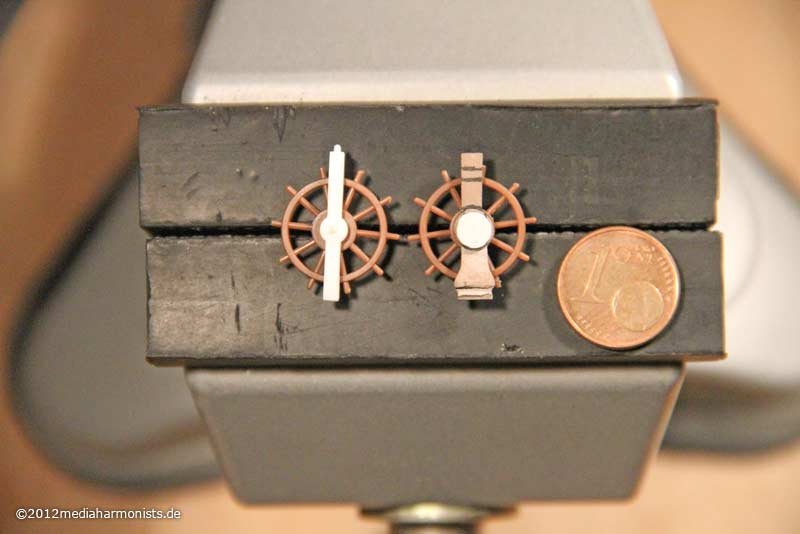
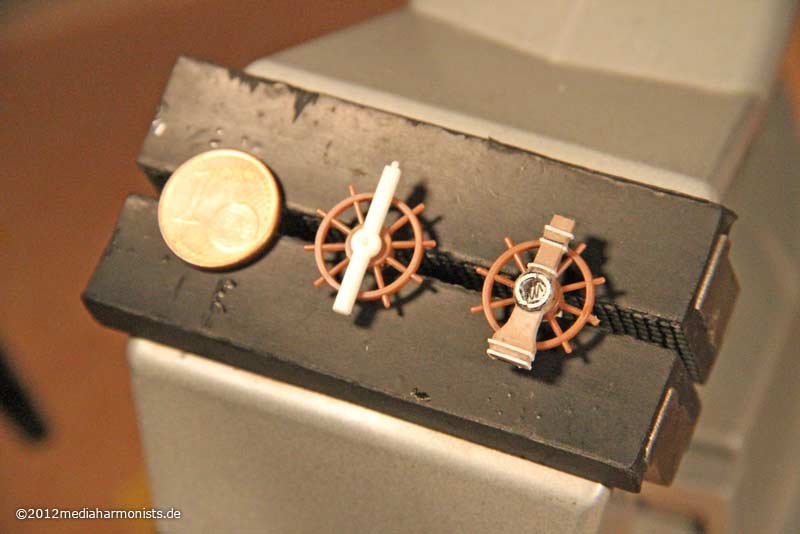
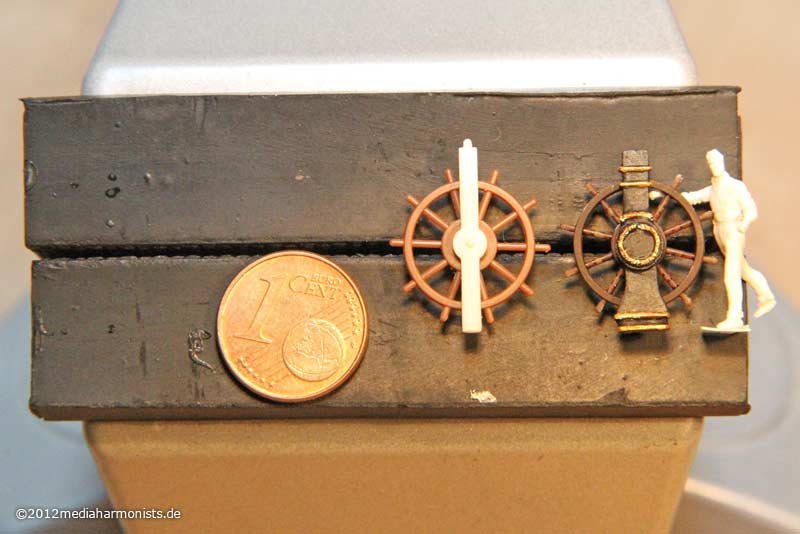
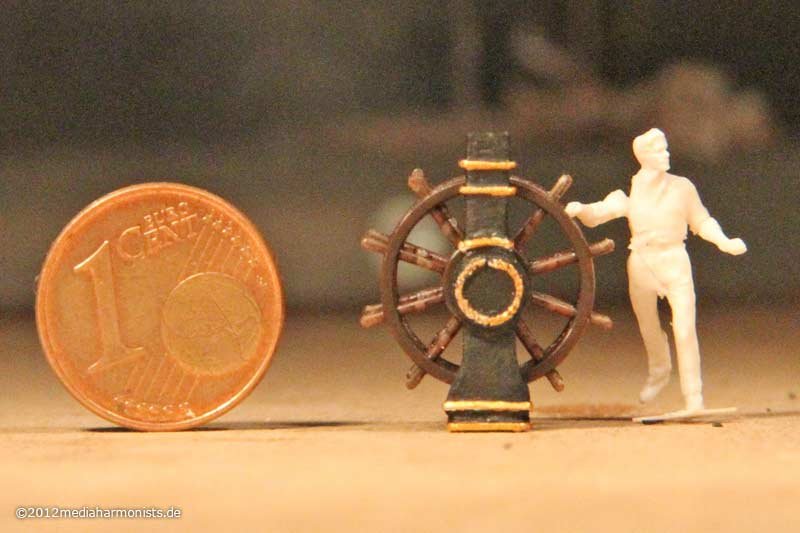
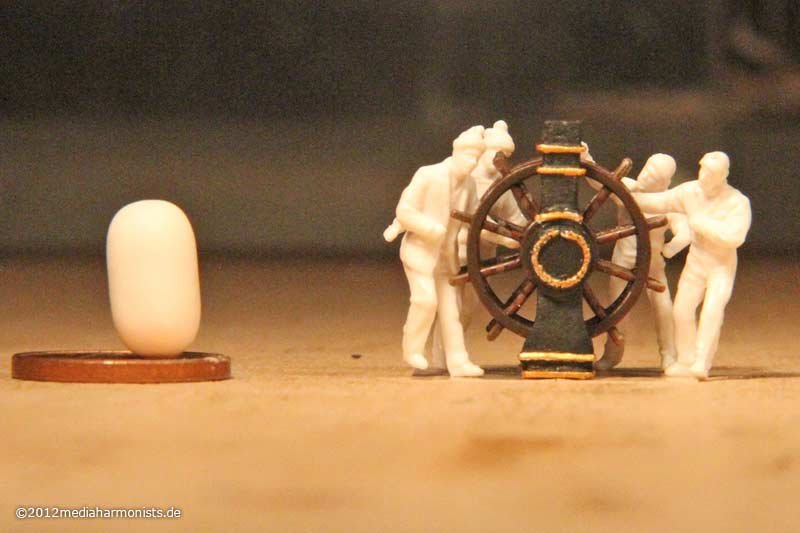
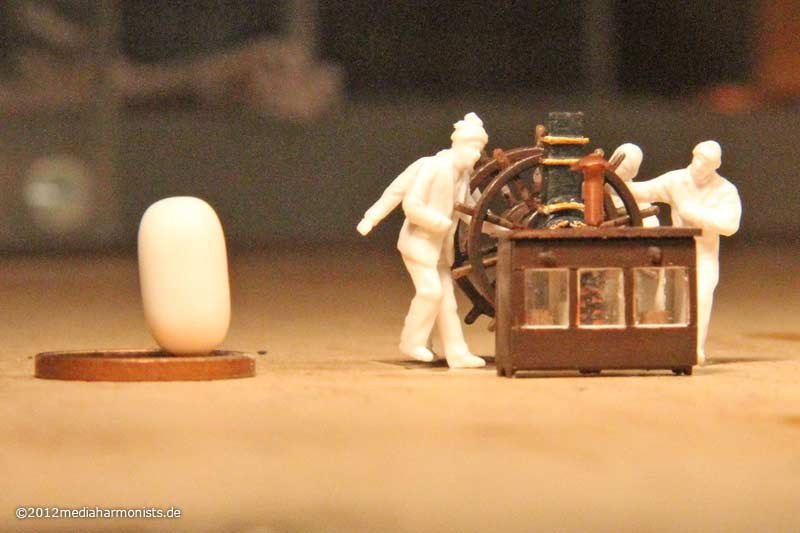
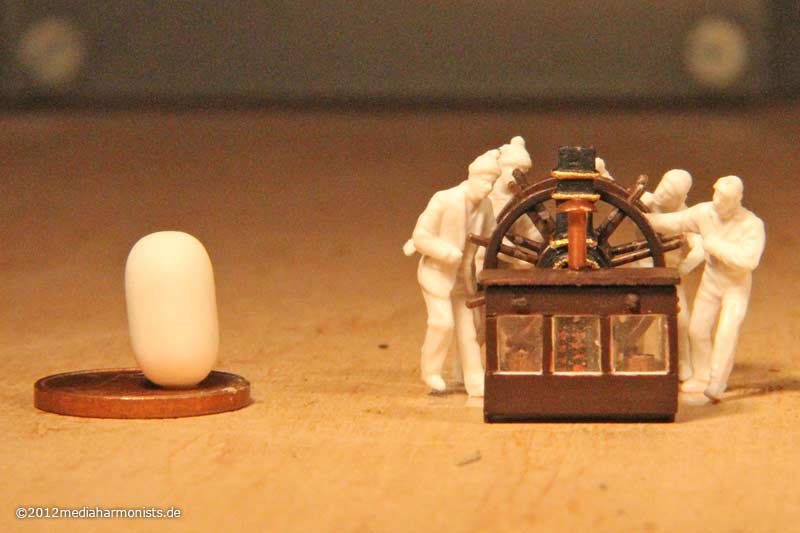
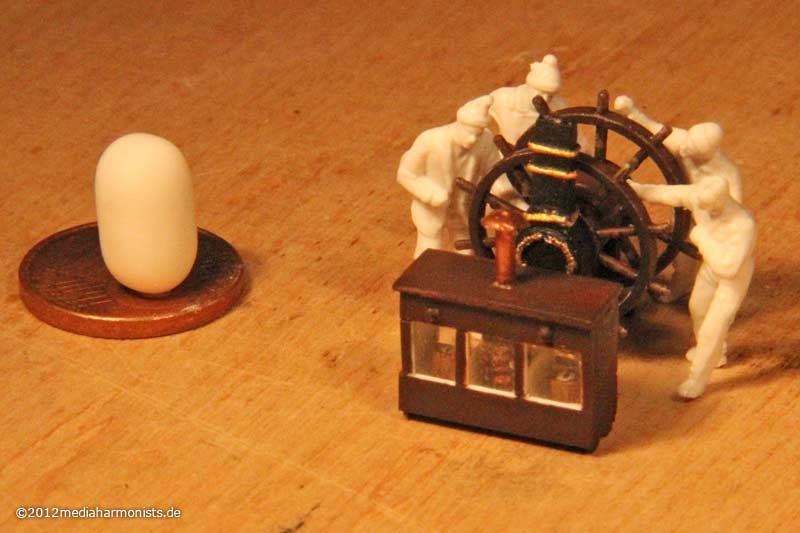 Gute Nacht, Daniel
Gute Nacht, Daniel -
Lee discribes on page 24 the use of additional crosstrees for tops of large ships. The timeframe is just the great repair and the Vic could be considered a "large ship", so seen by Lee this version could be qualified ;-)Aapproved by the admiralty from 1802 to 1815, these tops were made out of two pieces for easier replacement, these tops needed further strenghening by upper crosstrees/sleepers. This led too to a different layout for the battens.I already found some pictures of top of todays Victory mast tops, they all are done the "Heller way" :-)Neither Marquard or Schrage show this arrangement. But I found in Goodwins HMS Victory: her construction, career and restauration, he writes on page 21 that during the great repair of 1800 to 1803 the Vic was fitted with fighting tops "in two halves to make repair easier". This should be this version Lee talks about :-)And I found some sleepers on USS Constitutions 1930´s tops.
As pictures better show than long explanations can do, I made a fast model compared with the classical version.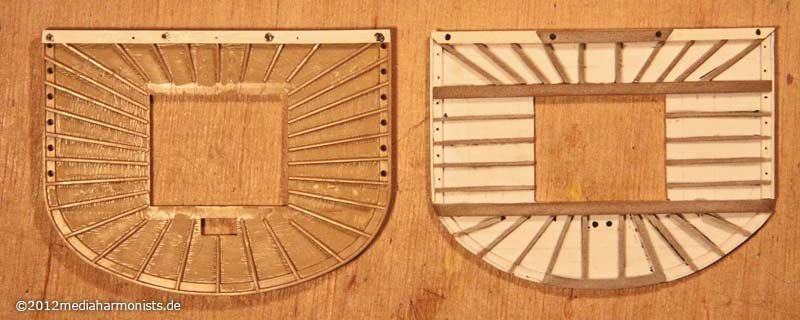 One can see the extra cross trees on the top side and the different layout of the battens. Just Lees drawing does not show all the details, also it does not correspond with the small cross section he is showing underneath the drawing.
One can see the extra cross trees on the top side and the different layout of the battens. Just Lees drawing does not show all the details, also it does not correspond with the small cross section he is showing underneath the drawing.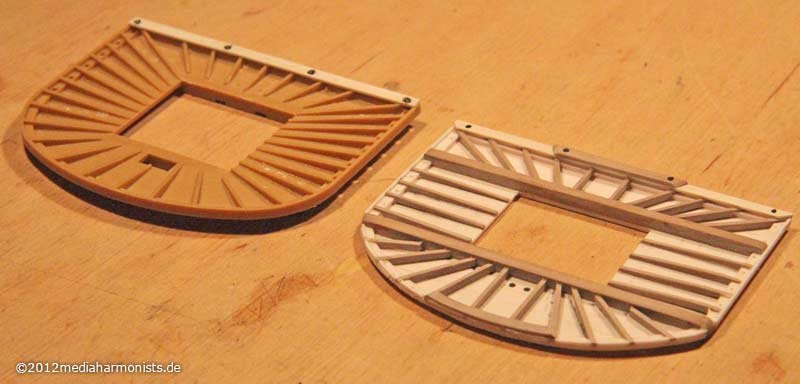
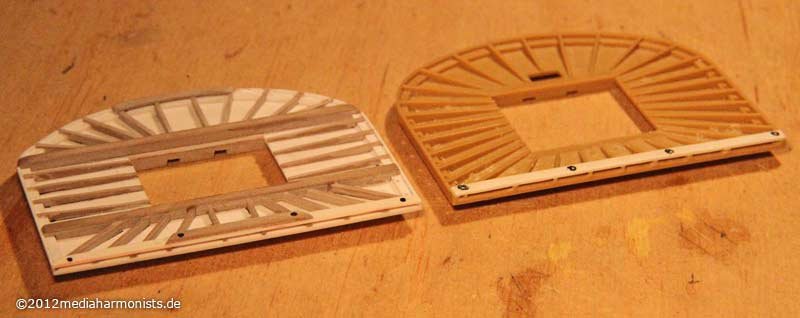
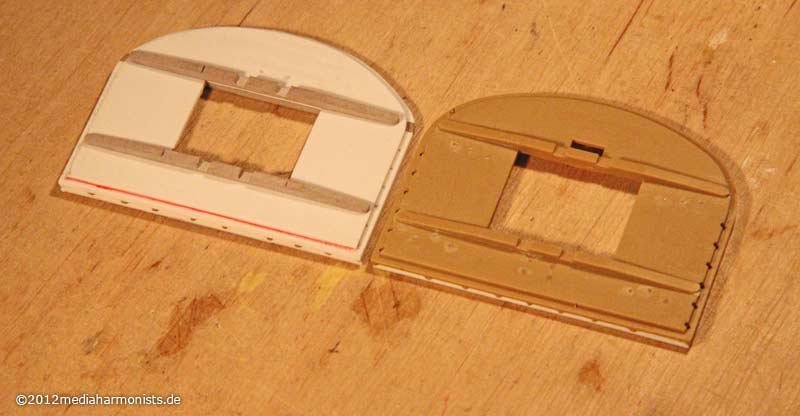 Here are the details that I am trying to find out:Is the back of the gunwhale open as the classical one is? How is the shape of the span piece?
Here are the details that I am trying to find out:Is the back of the gunwhale open as the classical one is? How is the shape of the span piece?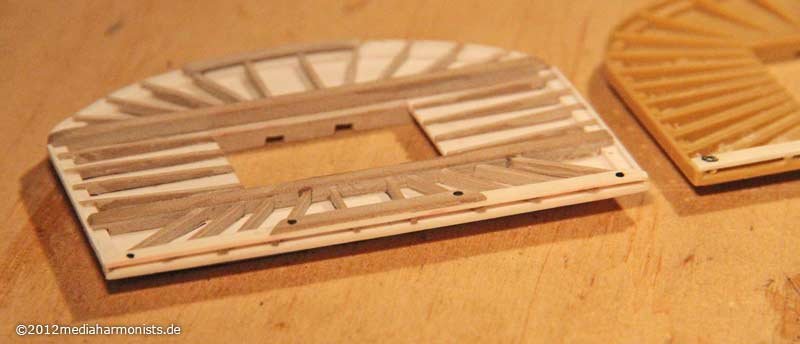
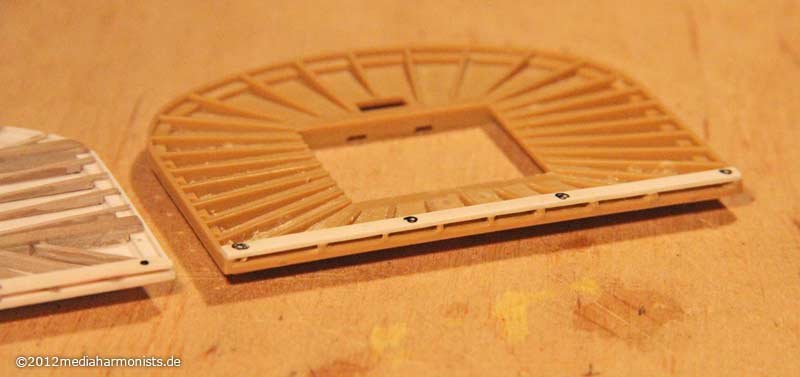 The battens are shown in the longitudinal section with no decreased height towards the center. As the battens that point towars the lumber hole have no second barrier, I decided to diminish the height as it is in the classical one. How is the form of the front span piece? Are there filling pieces underneath, is ther a slot like in the back or does the span piece go bdown to the rim?
The battens are shown in the longitudinal section with no decreased height towards the center. As the battens that point towars the lumber hole have no second barrier, I decided to diminish the height as it is in the classical one. How is the form of the front span piece? Are there filling pieces underneath, is ther a slot like in the back or does the span piece go bdown to the rim?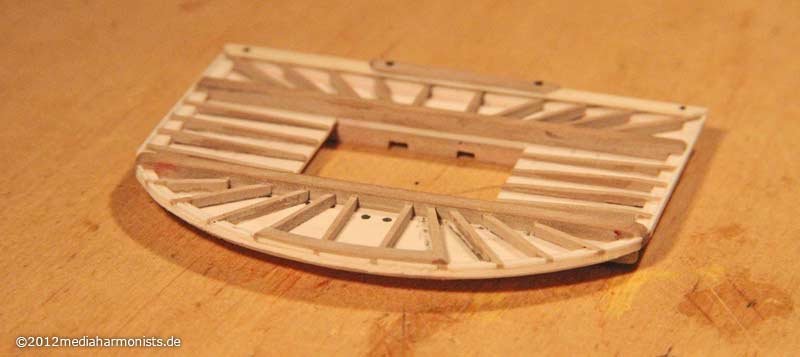 Also, do the upper crosspieces diminish height towards the outside as the lower ones do?Then came version two:Half of my questions were answered by Lee two pages later in the 1815 version of the tops, just he names them now Sleepers instead of upper crosstrees ...How should I know that ...So there is stated, that the sleepers have the same form as the lower crosstrees, just halve of the height. So three suggestions of mine have been proven: Same form as the lower cross trees with chamfering towards the outside, too thick in my version '#1 and the span pieces go down to the rim - 3 hits, not bad for the ego ;-)Ok, back to the machinery, slimming down the sleepers, giving them the chamfer towards the outside ...
Also, do the upper crosspieces diminish height towards the outside as the lower ones do?Then came version two:Half of my questions were answered by Lee two pages later in the 1815 version of the tops, just he names them now Sleepers instead of upper crosstrees ...How should I know that ...So there is stated, that the sleepers have the same form as the lower crosstrees, just halve of the height. So three suggestions of mine have been proven: Same form as the lower cross trees with chamfering towards the outside, too thick in my version '#1 and the span pieces go down to the rim - 3 hits, not bad for the ego ;-)Ok, back to the machinery, slimming down the sleepers, giving them the chamfer towards the outside ... ... rounded off the edges, cleaned up a bit, and it looks much more harmonic and so we get a little dance from ...
... rounded off the edges, cleaned up a bit, and it looks much more harmonic and so we get a little dance from ...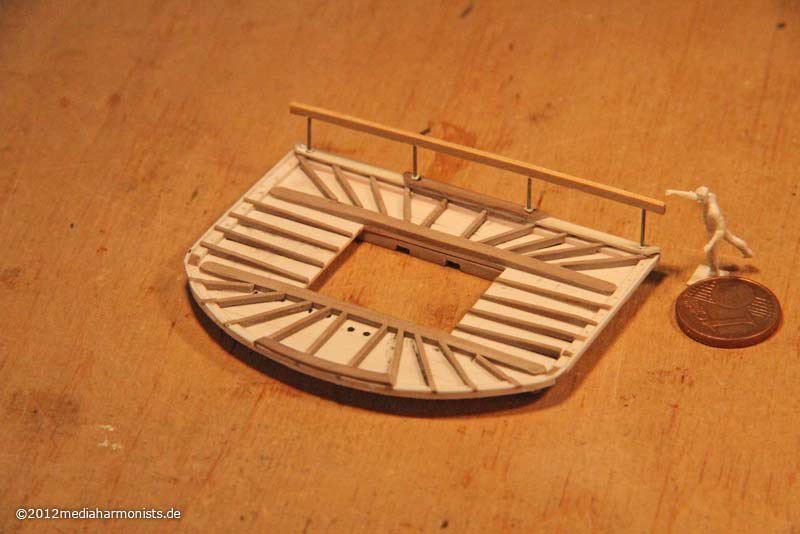 ... our beloved dancing sailor :-)Lieber Gruß, Daniel
... our beloved dancing sailor :-)Lieber Gruß, Daniel -
Actually I never got, that you striped the superstructure from the existing model ...
:-0
This beats all off my humble tearing down parties!
Love to see you back, Daniel
-
Hurrrray! After successful application and having passed the qualification test I was admitted for the final and terminal examination!!!So: Stacking spheres was in the past.The attentive follower might have realised that the sheaves at the sides of the sweep are still missing.They were easily carved out off some 2 mm x 2 mm square-shaped timber, strenghened with some CA and drilled twice . But how to fix them underneath the beam beside the sweep?This time just a short ...... thought ...... and fixed a handle out of wire ...
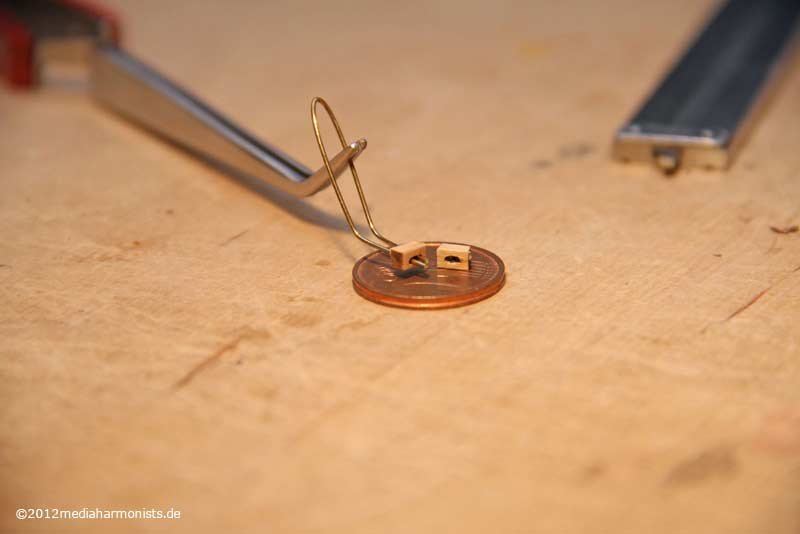 ... and placed it with some CA on place.
... and placed it with some CA on place.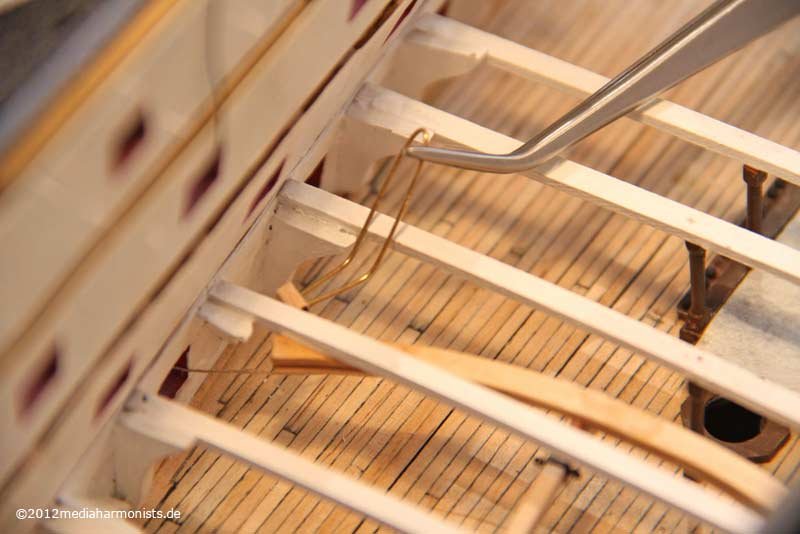 But that was just the warm up. How the hell to get the tiller rope through this now hidden sheave???And another time ...... thought ...... thought ...... and used the threading help from my wife´s sewing kit by pushing it from front through the inner hole of the sheave to pull a helping line from the back to the front to pull the tiller rope from the front to the back. Sounds complicated, it is not ;-)
But that was just the warm up. How the hell to get the tiller rope through this now hidden sheave???And another time ...... thought ...... thought ...... and used the threading help from my wife´s sewing kit by pushing it from front through the inner hole of the sheave to pull a helping line from the back to the front to pull the tiller rope from the front to the back. Sounds complicated, it is not ;-)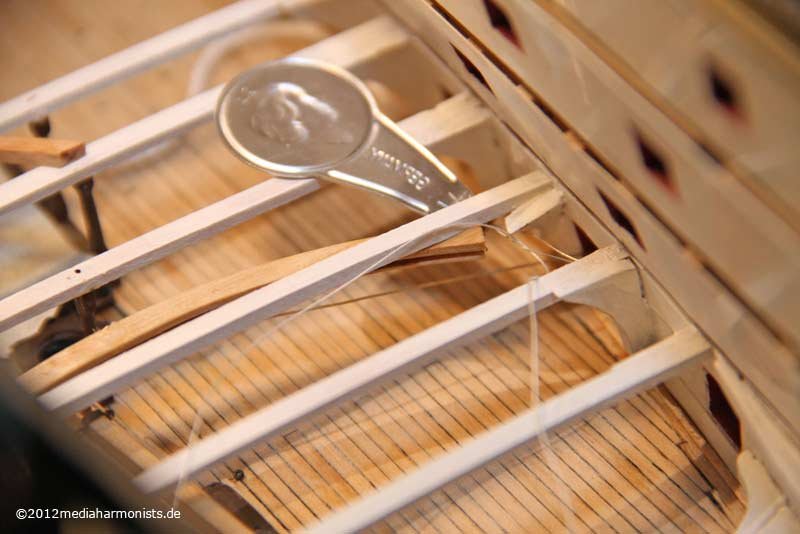 Then pushed the threading help from the front through the outer hole to pull the tiller rope from the back back to the front. Sounds easier? It is :-)Then constructed the further guidance of the rope with the cross members in the center line of the ship. Looks sexy ☺
Then pushed the threading help from the front through the outer hole to pull the tiller rope from the back back to the front. Sounds easier? It is :-)Then constructed the further guidance of the rope with the cross members in the center line of the ship. Looks sexy ☺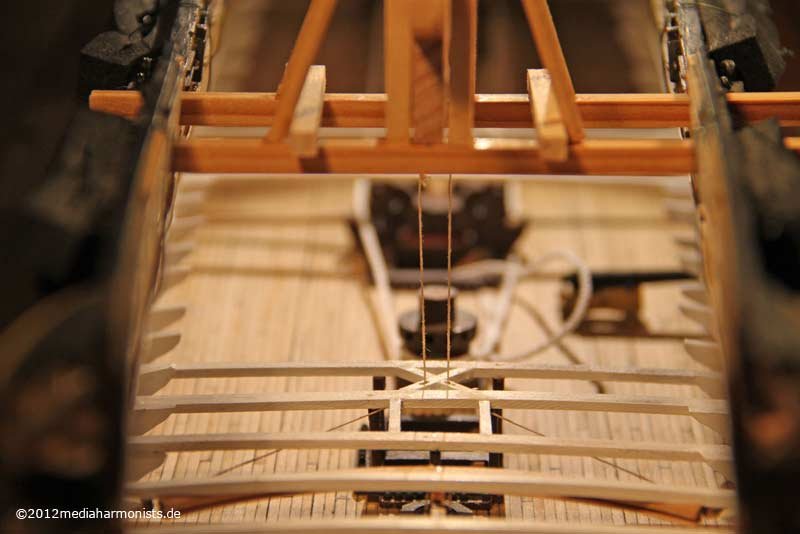 The rope is then led upwards through next deck´s gratings to the wheel.
The rope is then led upwards through next deck´s gratings to the wheel.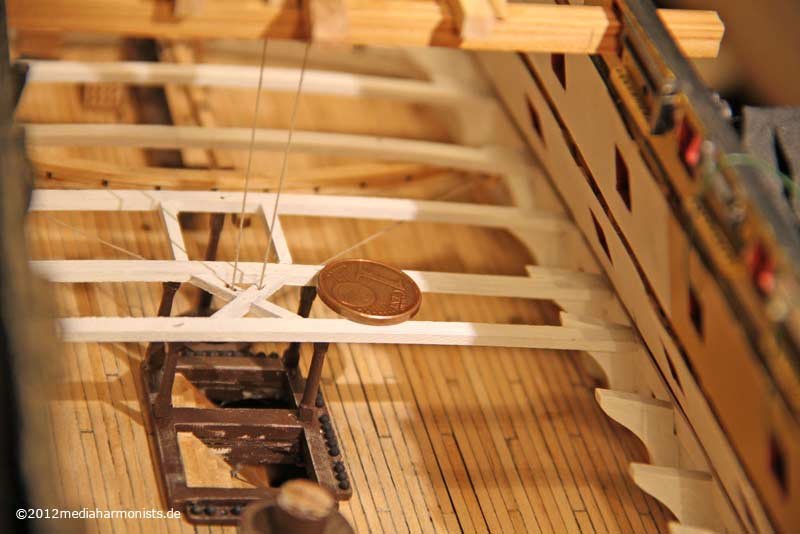 And as the 1:100 original model steering wheel is to fiddly for some real life´s turning, I constructed a substitute one. The drum diameter is about the right size. As the tensioning tackles on the tiller are fixed for some reasons, I had to adjust the tension in the system by two wedges underneath the barrel, this giving the great hight of the construction.
And as the 1:100 original model steering wheel is to fiddly for some real life´s turning, I constructed a substitute one. The drum diameter is about the right size. As the tensioning tackles on the tiller are fixed for some reasons, I had to adjust the tension in the system by two wedges underneath the barrel, this giving the great hight of the construction.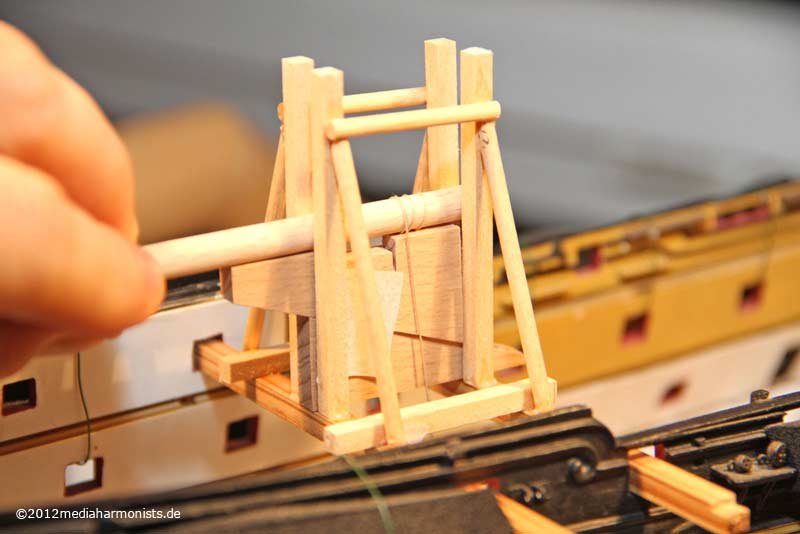 The construction now follows exactly the original so the following should happen:If those dafinistic fingers seen on the picture turn the barrel ...
The construction now follows exactly the original so the following should happen:If those dafinistic fingers seen on the picture turn the barrel ...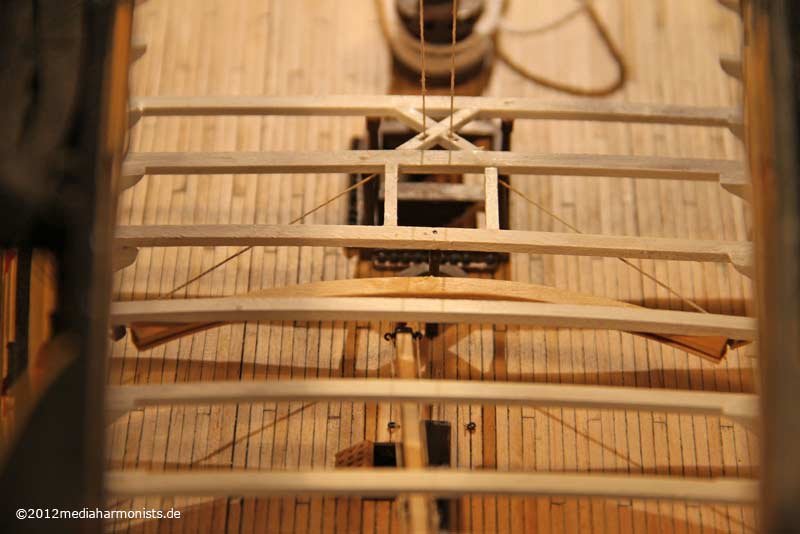 ... the tiller and the rudder move magically :-) :-) :-)
... the tiller and the rudder move magically :-) :-) :-)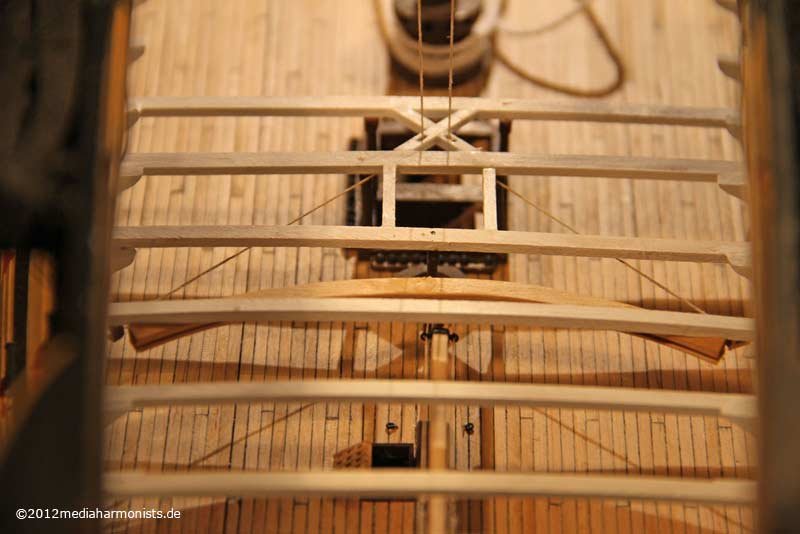
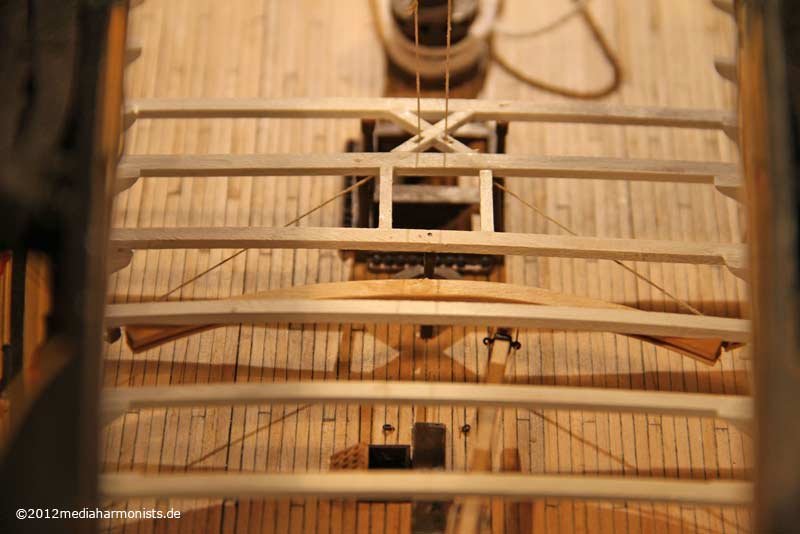
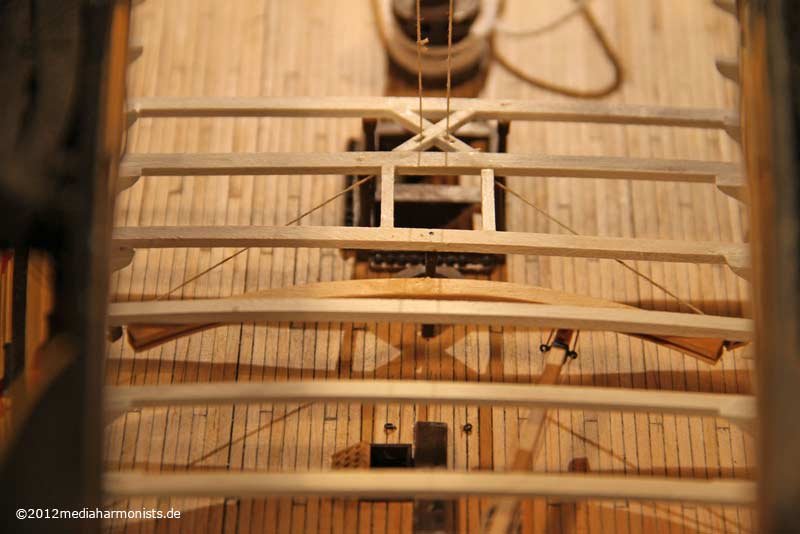 ....hihihihihihi...I hope that with this I passed my happy home examination ;-)I also hope you enjoyed this excursus to a 18th century steering system as much as I did. Learned a lot regarding the technic used in those days as much as learned some nice new tricks for model making. ☺With all the best wishes from this nice bin with the upholstered walls, oh what nice colors I can see after those funny pills ,always yours, DanielDisclaimer/Remark 1:NO! The steering wheel underneath the poop will not be movable! After fixing the next deck, tiller and rudder will be fixed for security reasons. I do not need an "unshipping of the rudder" on the finished model. But until then I will enjoy the view :-)Disclaimer/Remark 2:I already waiting for people trying to copy the substitute rudder believing it was an original fitting ...Disclaimer/Remark 3:But who knows - one of the first hits of the french round shots was the steering wheel and who knows how the orinal substitute looked like ...Ah, here they come, the men with the white coats, they are coming to take me away ...
....hihihihihihi...I hope that with this I passed my happy home examination ;-)I also hope you enjoyed this excursus to a 18th century steering system as much as I did. Learned a lot regarding the technic used in those days as much as learned some nice new tricks for model making. ☺With all the best wishes from this nice bin with the upholstered walls, oh what nice colors I can see after those funny pills ,always yours, DanielDisclaimer/Remark 1:NO! The steering wheel underneath the poop will not be movable! After fixing the next deck, tiller and rudder will be fixed for security reasons. I do not need an "unshipping of the rudder" on the finished model. But until then I will enjoy the view :-)Disclaimer/Remark 2:I already waiting for people trying to copy the substitute rudder believing it was an original fitting ...Disclaimer/Remark 3:But who knows - one of the first hits of the french round shots was the steering wheel and who knows how the orinal substitute looked like ...Ah, here they come, the men with the white coats, they are coming to take me away ... -
With the application form successful turned in, I was allowed to the qualifying examination to prove my insanity´s potential.I found an adequate project, the tiller sweep that supports the front end of the tiller and gives guidance for the tiller rope.First taking the measures - the moving angle of the tiller including the sheaves on the sides ...
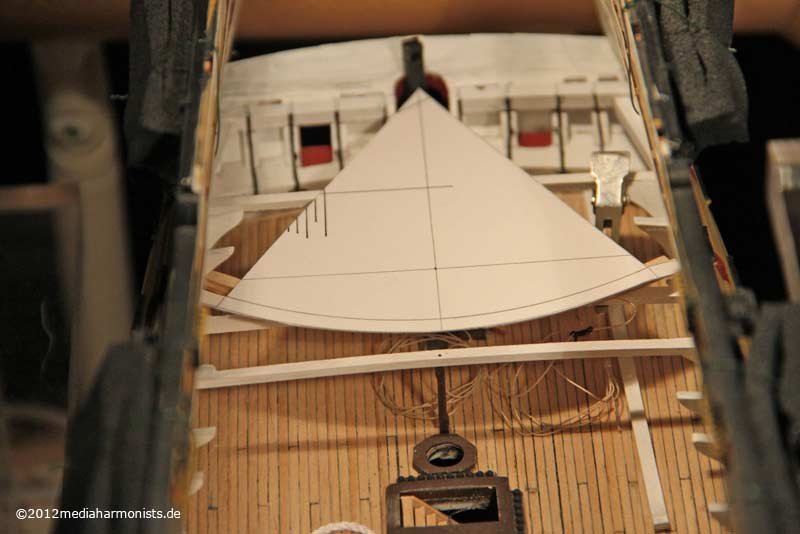 ... and it even fits, hihihihihi...The circular bits for the top and bottom were easily cut but how to do the middle part? ...... thought ...... thought ...- twice enough this time – and I knew how to build up the inside- the easy way ;-)Took one of the remaining 0,7 mm planks, cut it to a width of 1 mm plus and squeezed it vertically inbetween two 1 mm styrene sheets ...
... and it even fits, hihihihihi...The circular bits for the top and bottom were easily cut but how to do the middle part? ...... thought ...... thought ...- twice enough this time – and I knew how to build up the inside- the easy way ;-)Took one of the remaining 0,7 mm planks, cut it to a width of 1 mm plus and squeezed it vertically inbetween two 1 mm styrene sheets ...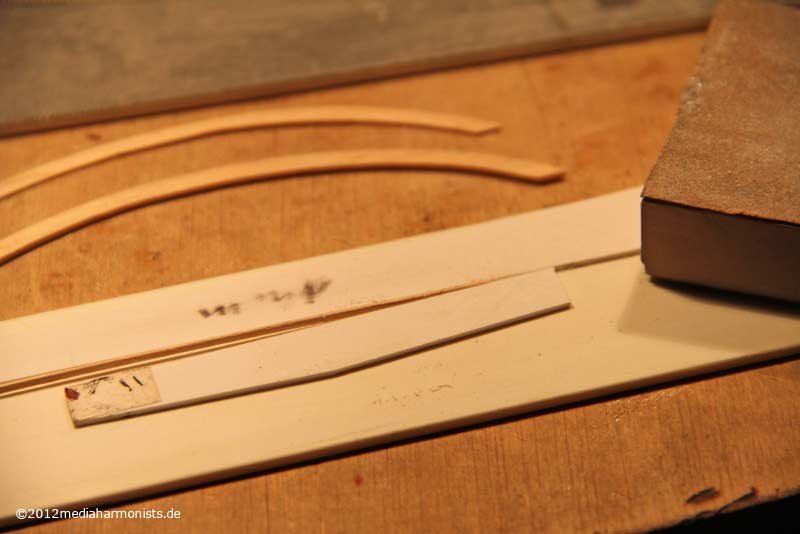 ... and sanded the excess away ...
... and sanded the excess away ... ... and glued it together as a sandwich. Gives a surprisingly sturdy piece of sweep, even though the faible materials.Glued a small handle on it and test placed it ...
... and glued it together as a sandwich. Gives a surprisingly sturdy piece of sweep, even though the faible materials.Glued a small handle on it and test placed it ...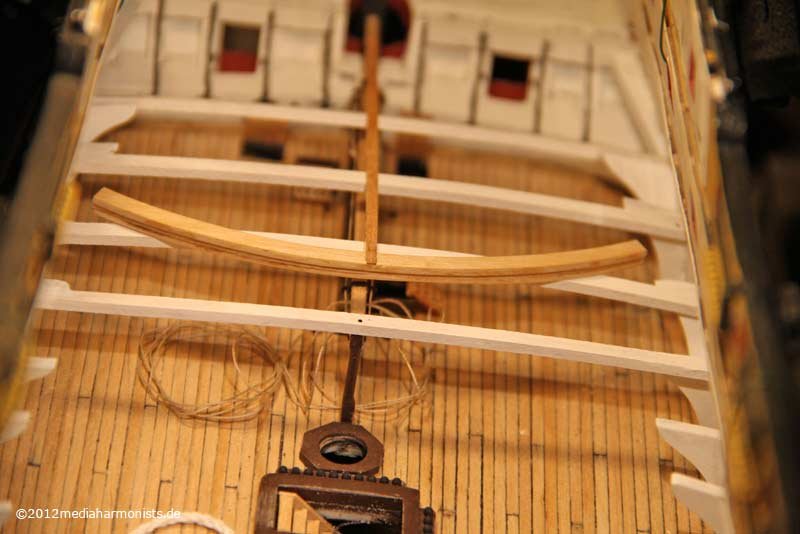 ... and it looked very promising ...... thought ...... thought ...... how do I fix this bit down there deep in the bowels of my Vic in some way, that it finds itself in the right place? And underneath the deck beam?... thought ...... and carved two guides for the deck beam into the top side of the sweep. Now the longitudinal direction was fixed ☺
... and it looked very promising ...... thought ...... thought ...... how do I fix this bit down there deep in the bowels of my Vic in some way, that it finds itself in the right place? And underneath the deck beam?... thought ...... and carved two guides for the deck beam into the top side of the sweep. Now the longitudinal direction was fixed ☺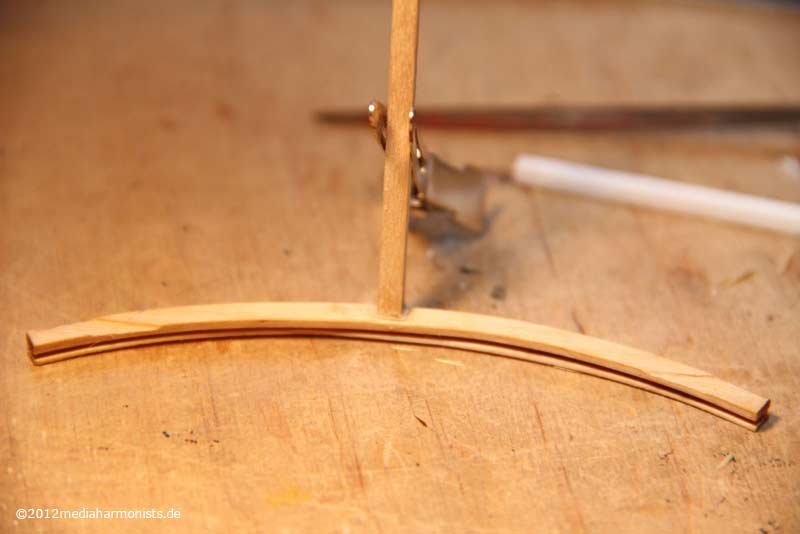 For that the tiller rope does not wear too much, there were rollers in the front groove ...
For that the tiller rope does not wear too much, there were rollers in the front groove ...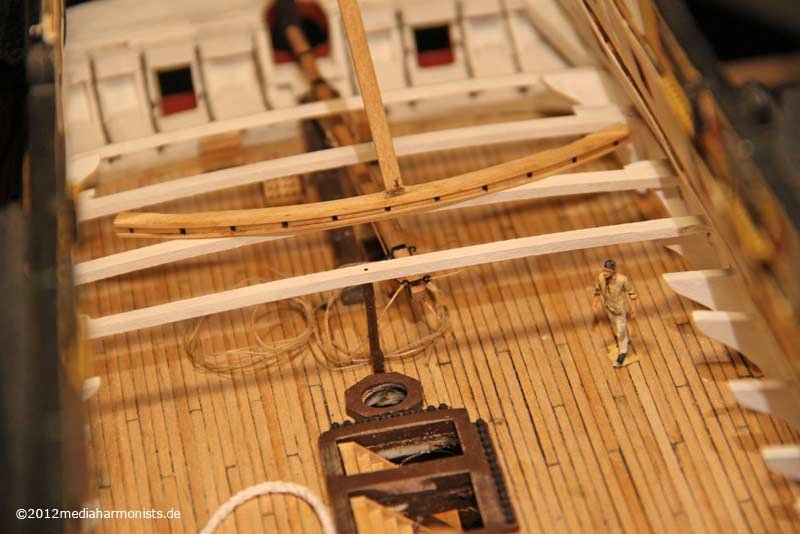 ... some more tests for the positioning ...
... some more tests for the positioning ... ... and again the old question: how to get it fixed down there?... thought ...... and again an easy solution: Two pieces of soft foam push gently from the bottom and allow precise fixing☺ The hairclips just help the positioning. Some drops of CA and here we are :-)
... and again the old question: how to get it fixed down there?... thought ...... and again an easy solution: Two pieces of soft foam push gently from the bottom and allow precise fixing☺ The hairclips just help the positioning. Some drops of CA and here we are :-)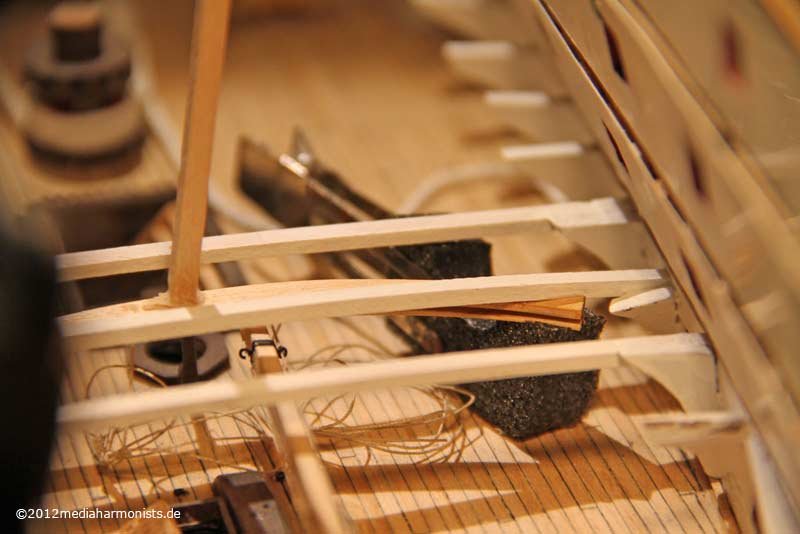 Still had to glue the goose neck on place protruding into the back groove and the tiller even sweeps the way it should do in the sweep.
Still had to glue the goose neck on place protruding into the back groove and the tiller even sweeps the way it should do in the sweep.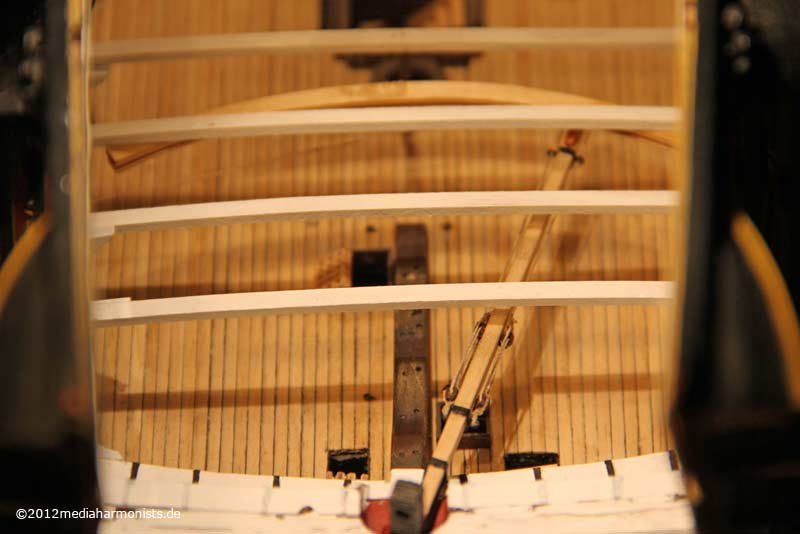
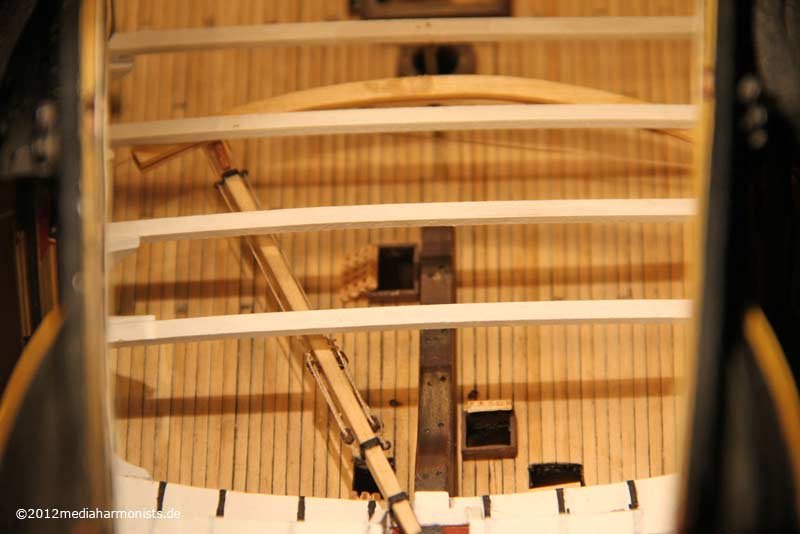 So the qualification test was going very promising and I hope I was able to show a glimpse of a model makers insanity potential.Sincerely yours, etc., etc. Daniel
So the qualification test was going very promising and I hope I was able to show a glimpse of a model makers insanity potential.Sincerely yours, etc., etc. Daniel -
Application form for the funny farm
Dear audience,
to get myself faster into the mental home, I decided to fill out the necessary application forms.As usual, I started by getting out the heavy material ...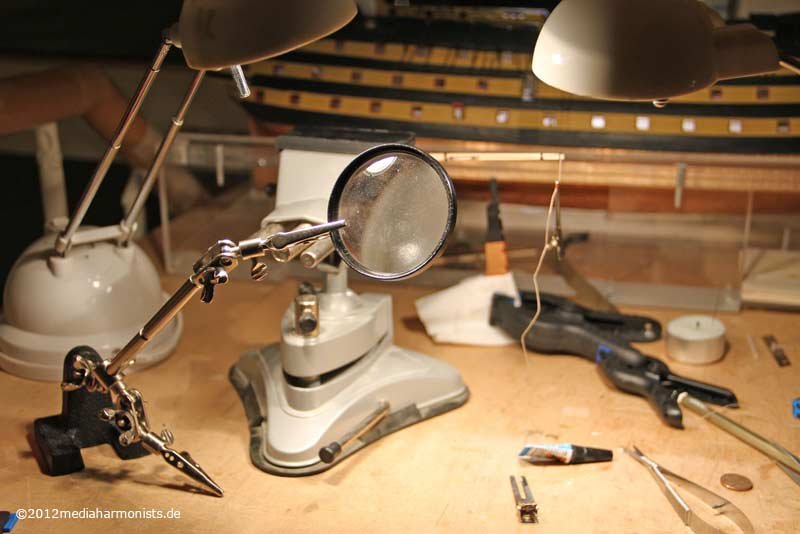 ... but it just started with some minor discomforts ...
... but it just started with some minor discomforts ...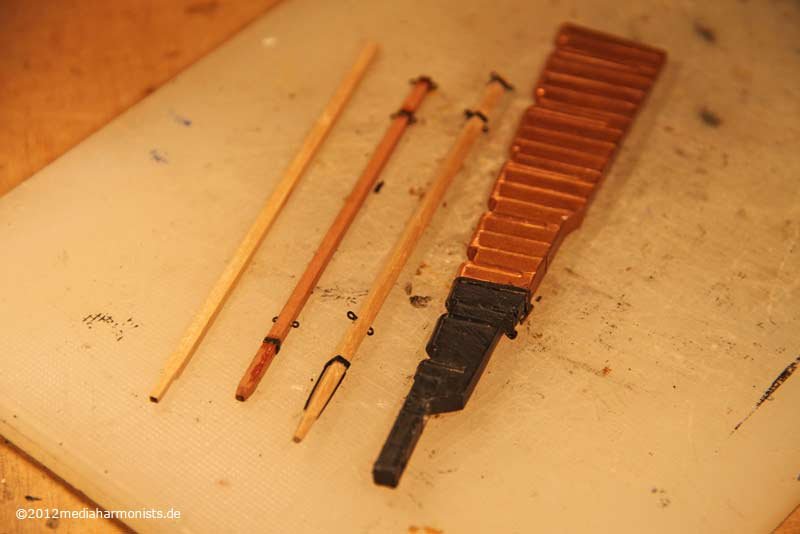 ... and I originally just wanted to exchange the dark brown tiller as it proved a little bit to short. The one on the left had the right length but when I wanted to prepare the fittings I realised ...
... and I originally just wanted to exchange the dark brown tiller as it proved a little bit to short. The one on the left had the right length but when I wanted to prepare the fittings I realised ...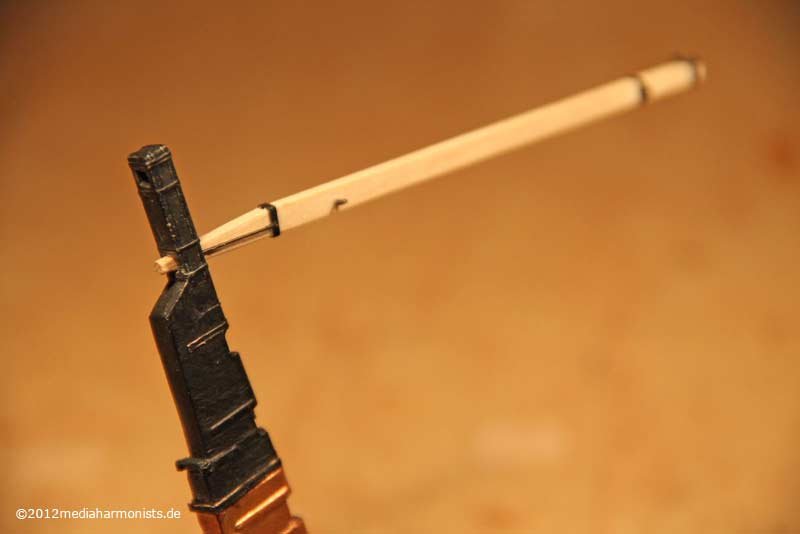 ... that the original had a completely different shape with the thickest part just in front of the rudder. So the fittings were fixed fast, the hoop near the rudder with the two fixing rods ...
... that the original had a completely different shape with the thickest part just in front of the rudder. So the fittings were fixed fast, the hoop near the rudder with the two fixing rods ...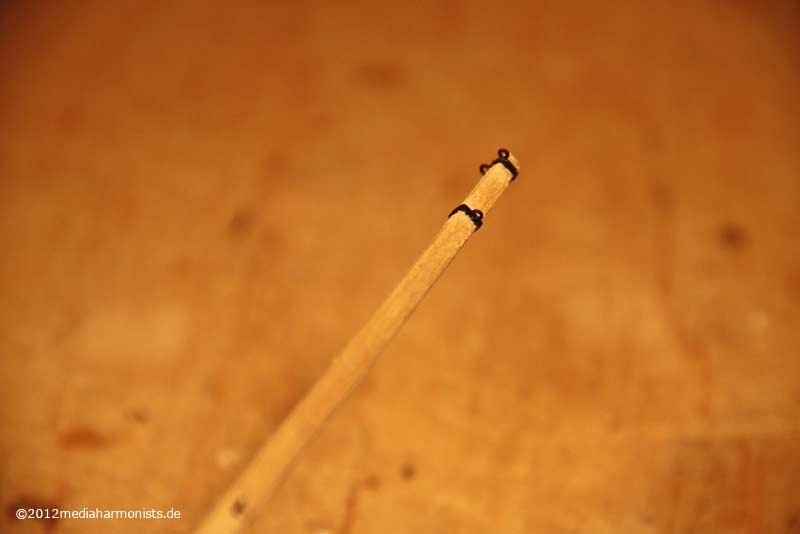 ... the bolts for the tension tackle, and the double pair in the front for guiding the rope: But now it got funny ...
... the bolts for the tension tackle, and the double pair in the front for guiding the rope: But now it got funny ...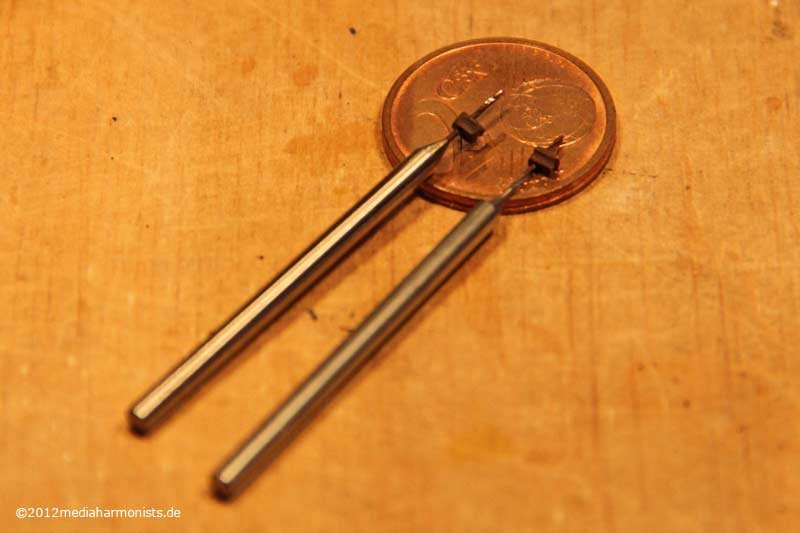 ... making blocks fitting to tiller with its 2 mm x 2 mm cross section. The drill has 0,5 mm and the new blocks out of Ureol have about 1,9 mm x 1,2 mm x 0,9 mm. For not having to look for them or even loosing them I left them stored on the drill :-)First rigging tests proved unsuccessfull, wrong cord, too thin and fuzzy. Also the blocks were on the wrong place.
... making blocks fitting to tiller with its 2 mm x 2 mm cross section. The drill has 0,5 mm and the new blocks out of Ureol have about 1,9 mm x 1,2 mm x 0,9 mm. For not having to look for them or even loosing them I left them stored on the drill :-)First rigging tests proved unsuccessfull, wrong cord, too thin and fuzzy. Also the blocks were on the wrong place.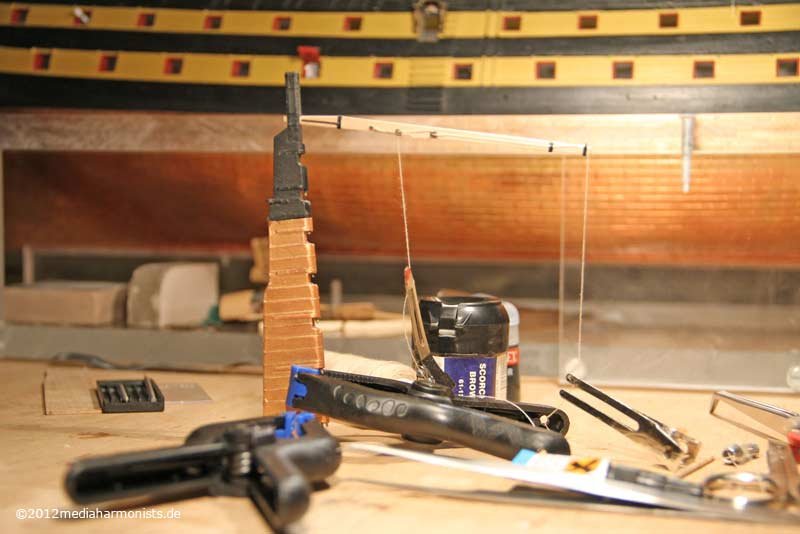 Ok, ripped it down and thought ...And thought.And thought.And thought.The conclusion: The length of the steering wheel´s drum shows the size of the rigging line. The original shows 7 turns of the rope which gives the half length of the drum and leaving a quarter of it free in the front and also in the back. This results in about 15 possible turns on a drum of about 45 cm which leads to a size of the rope of about 3 cm, respectively 0,3 mm on the model. Great, got some of that thickness in sufficient quality left :-)
Ok, ripped it down and thought ...And thought.And thought.And thought.The conclusion: The length of the steering wheel´s drum shows the size of the rigging line. The original shows 7 turns of the rope which gives the half length of the drum and leaving a quarter of it free in the front and also in the back. This results in about 15 possible turns on a drum of about 45 cm which leads to a size of the rope of about 3 cm, respectively 0,3 mm on the model. Great, got some of that thickness in sufficient quality left :-)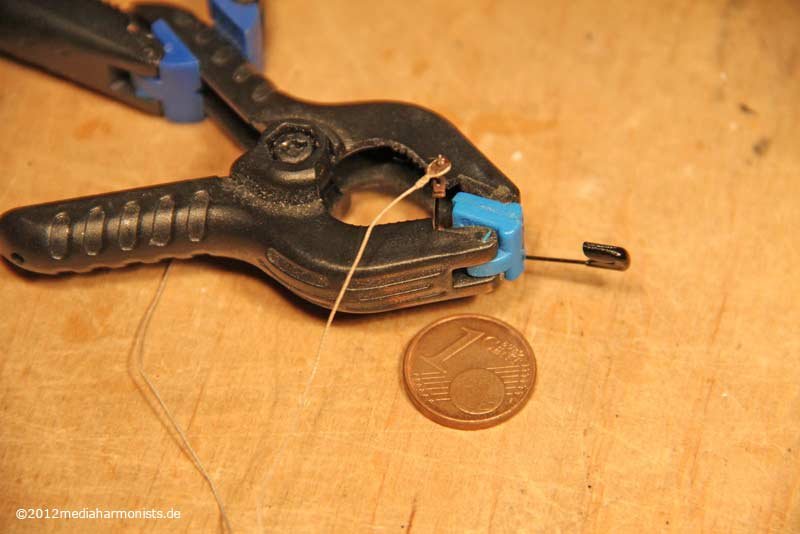 Rerigged the blocks - of course with the powersplice - and it looks much friendlier :-)
Rerigged the blocks - of course with the powersplice - and it looks much friendlier :-)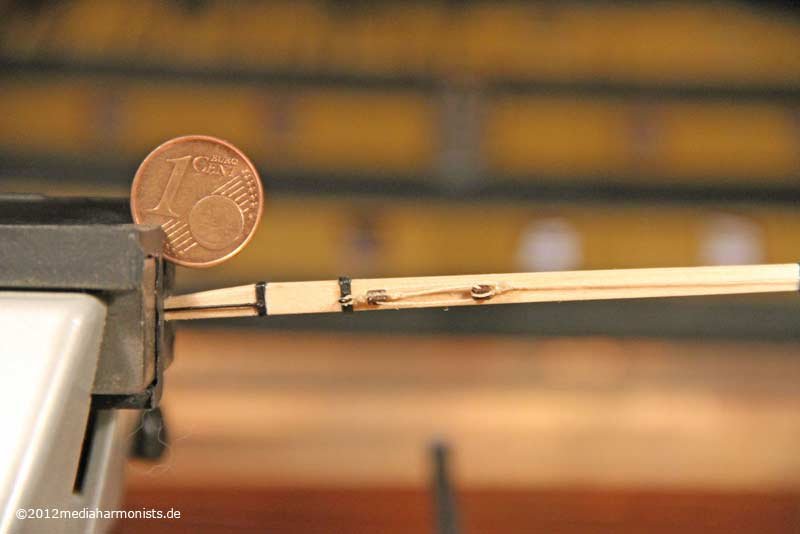
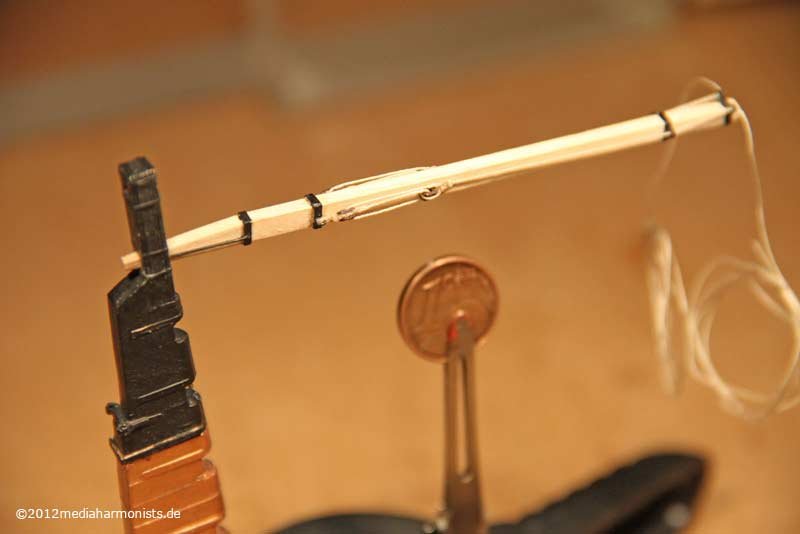 Still added - not glued yet - the goos neck for the sweep ...
Still added - not glued yet - the goos neck for the sweep ...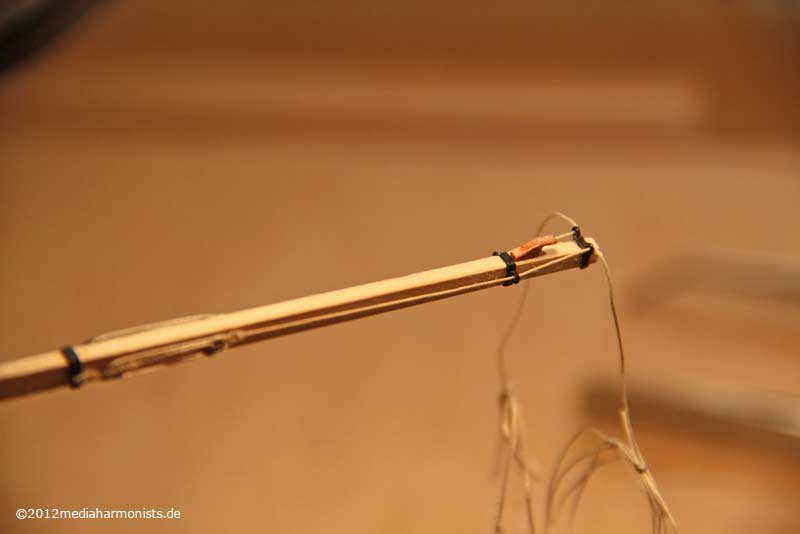 ... and I do believe that I have everything needed for the successful application form :-)Greetings from hell´s kitchen, Daniel
... and I do believe that I have everything needed for the successful application form :-)Greetings from hell´s kitchen, Daniel -
Hwello Jan,
nice to get her back .-)
great build and I love the colorful style of those days!
Daniel
-
Some small thoughts ...
... with 800 men crew and 6 seats we get this optimized calculation:800 men (NCO) / 6 seats gives 133 men/seatIn a optimized 24 hours use using all seats we get the following numbers:24 hours = 1440 minutes1440 minutes / 133 men = 10,5 minutes/man per day. This means no second wasted and the next user always stand by.If you take account of that not the whole day it is possible to have this steady usage because of time, scedules and weather, the usage time per person sinks dramatically. If I remember well, constipation was widely spread, which leads to longer men mean residence time.So the conclusion is, that the heads, regarding the weather, daytime and service schedule, could possibly be a quite crowded place at certain moments.This account only includes the "big business". There still would be some persons too to be expected at the heads for the "small business", if they are not preferring hanging out in the shrouds (leewards): One hand for the ship and one hand for yourself - now that line is finally understood.A quick research in German Law and regulations indicates the following:Puplic Law of the State of lower Saxony says for a leisure event of 800 visitors the calculation should be:800:100 x 0,8 = 7 seated toilets and 800:100 x 1,2 = 10 urinals (always rounded)The Law of Working Spaces "Arbeitsstätten-Richtlinie, ArbStätt 5.037.1, vom 26. Juni 1976 (ArbSch. 9/1976 S. 322)"for 250 employes one needs 10 seated toilets and 10 urinals, that means more than double for 800 employees.In a converse argument that leads to the conclusion:For a working place the ship should have 5 times more seated toilets and this leads to - that by the number of seats - the ship must be a leisure event - Join the Navy - see the better world!Sehr geehrter Gruß, Ihr treuergebener Dienermost sincerely, your humble servant,dafi -
Okokok...Back to business. Did you already discover the other small detail? The netting? Ever since I bought it 18 month ago I was wondering how to fix it in a decent way. Quite rigid but still floppy, bad to paint, difficult to handle, in on word: a modellers dream ;-)But now I think I found my way. Taking the measures with templates ...
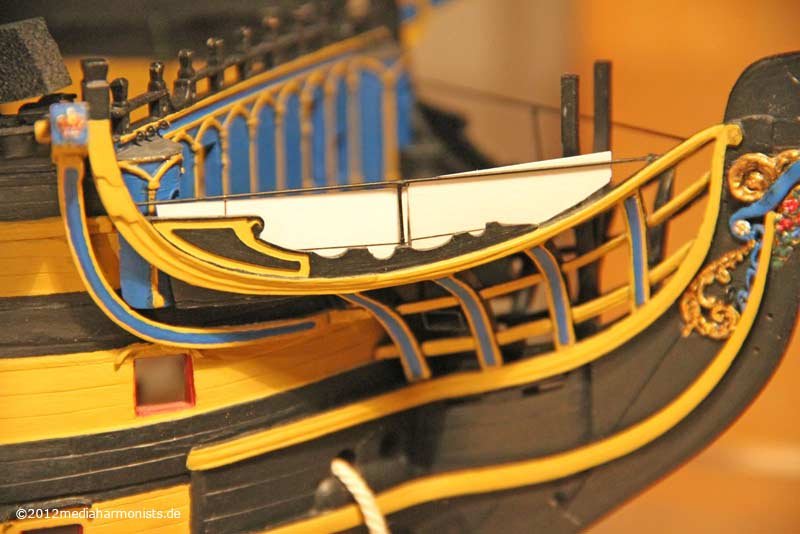 ... transfer to cardboard ...
... transfer to cardboard ...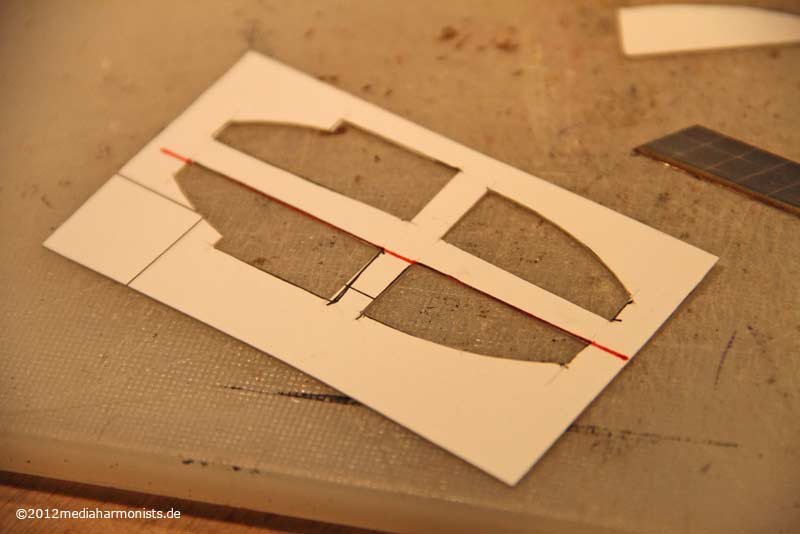 ... glueing the tulle over it, making a frame out of 0,3 mm copper wire and fix it with CA.
... glueing the tulle over it, making a frame out of 0,3 mm copper wire and fix it with CA.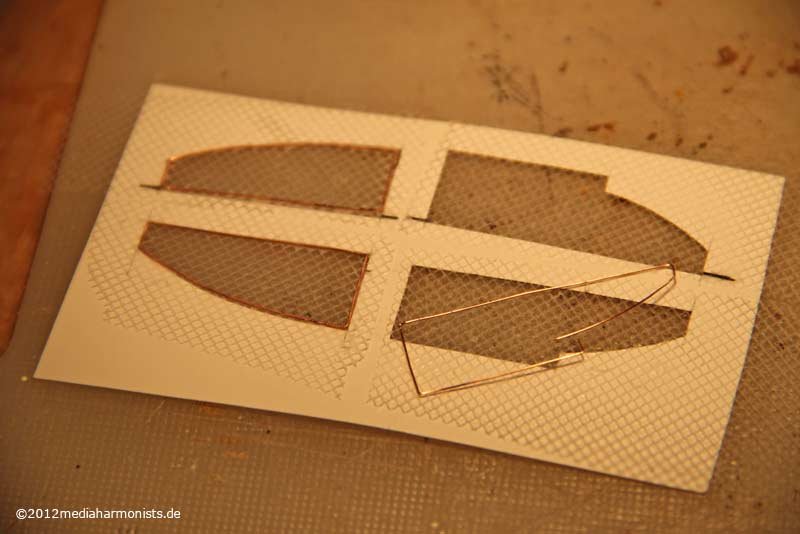 Taking my Citadel paints and give it a nice coat, this enhances the appearance of the material, three layers of different colors give a little bit of shading ...
Taking my Citadel paints and give it a nice coat, this enhances the appearance of the material, three layers of different colors give a little bit of shading ...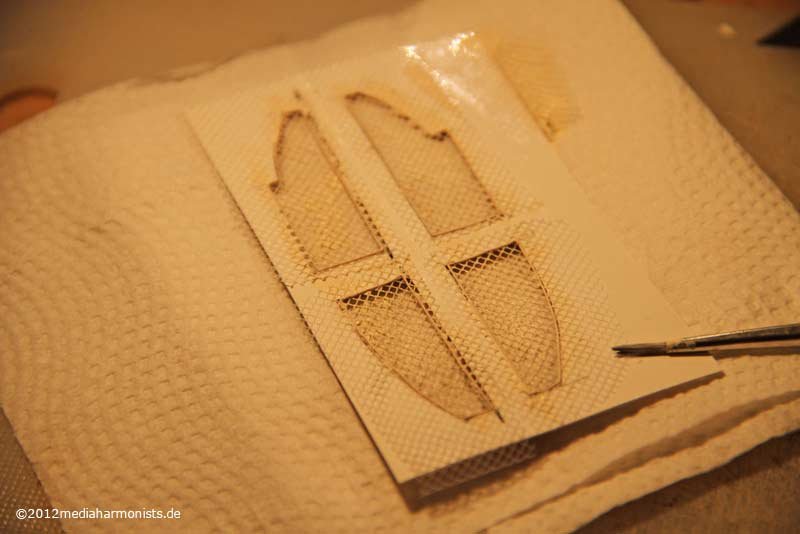 ... cut out ...
... cut out ...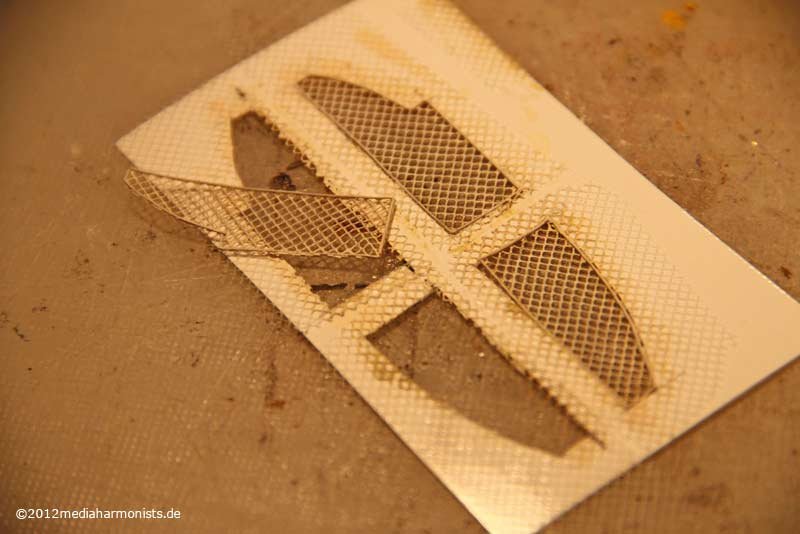 ... and holy s... I changed the running direction of the material and got different looks :-(
... and holy s... I changed the running direction of the material and got different looks :-(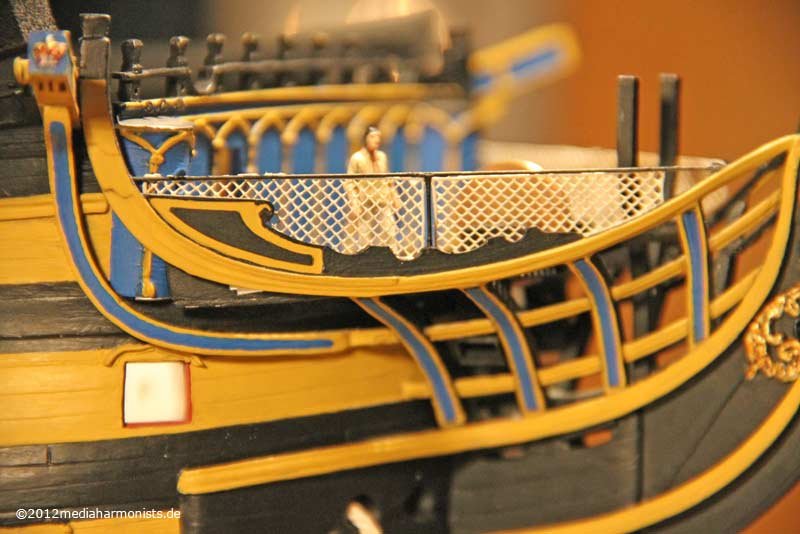 Ok, made new ones and sewed them on the proper way ...
Ok, made new ones and sewed them on the proper way ...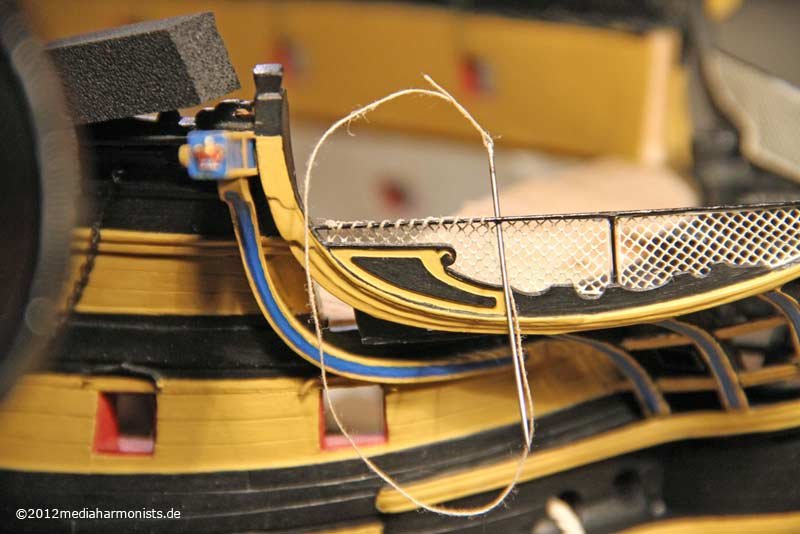 ... and it looks much better :-)By pulling a little bit on the right corners of the copper wire it also got slightly wavy to be not too even.
... and it looks much better :-)By pulling a little bit on the right corners of the copper wire it also got slightly wavy to be not too even.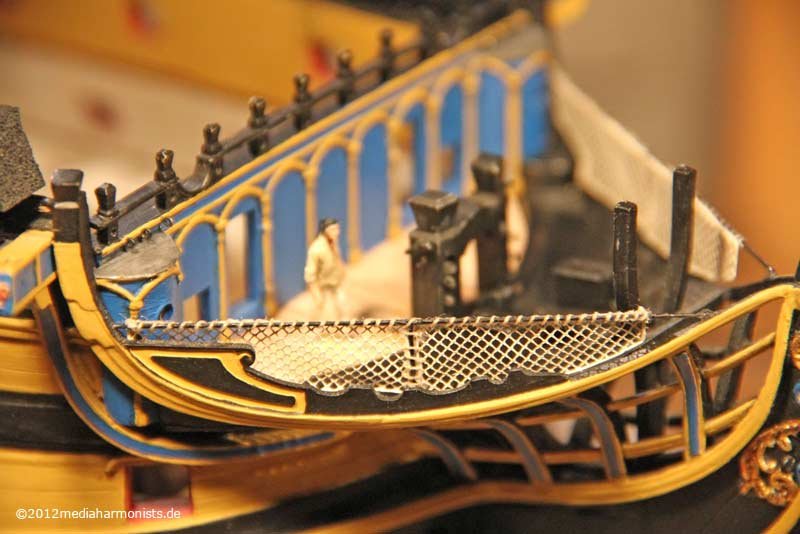 So bye for now, Daniel
So bye for now, Daniel



HMS Victory by dafi - Heller - PLASTIC - To Victory and beyond ...
in - Kit build logs for subjects built from 1751 - 1800
Posted · Edited by dafi